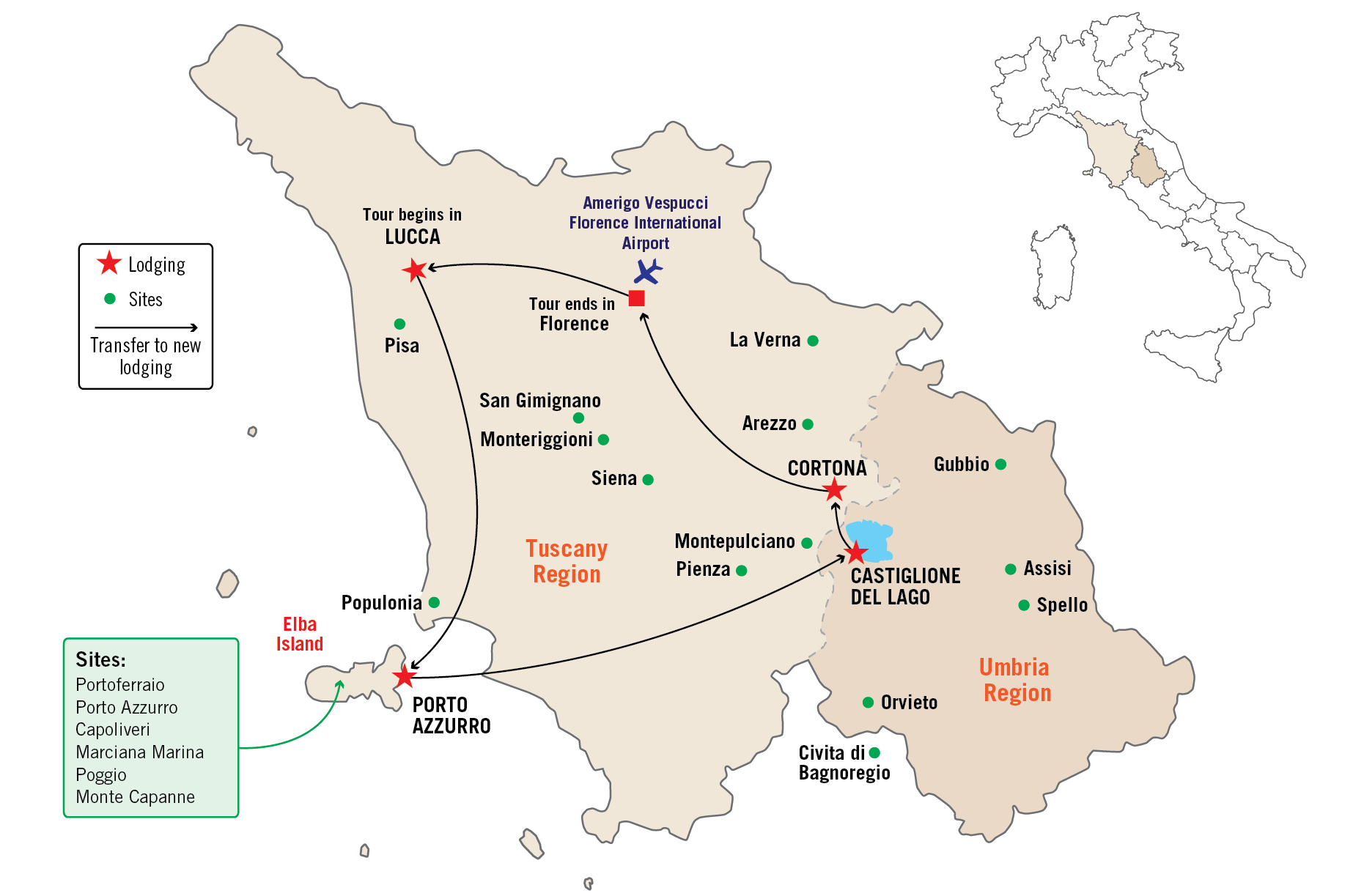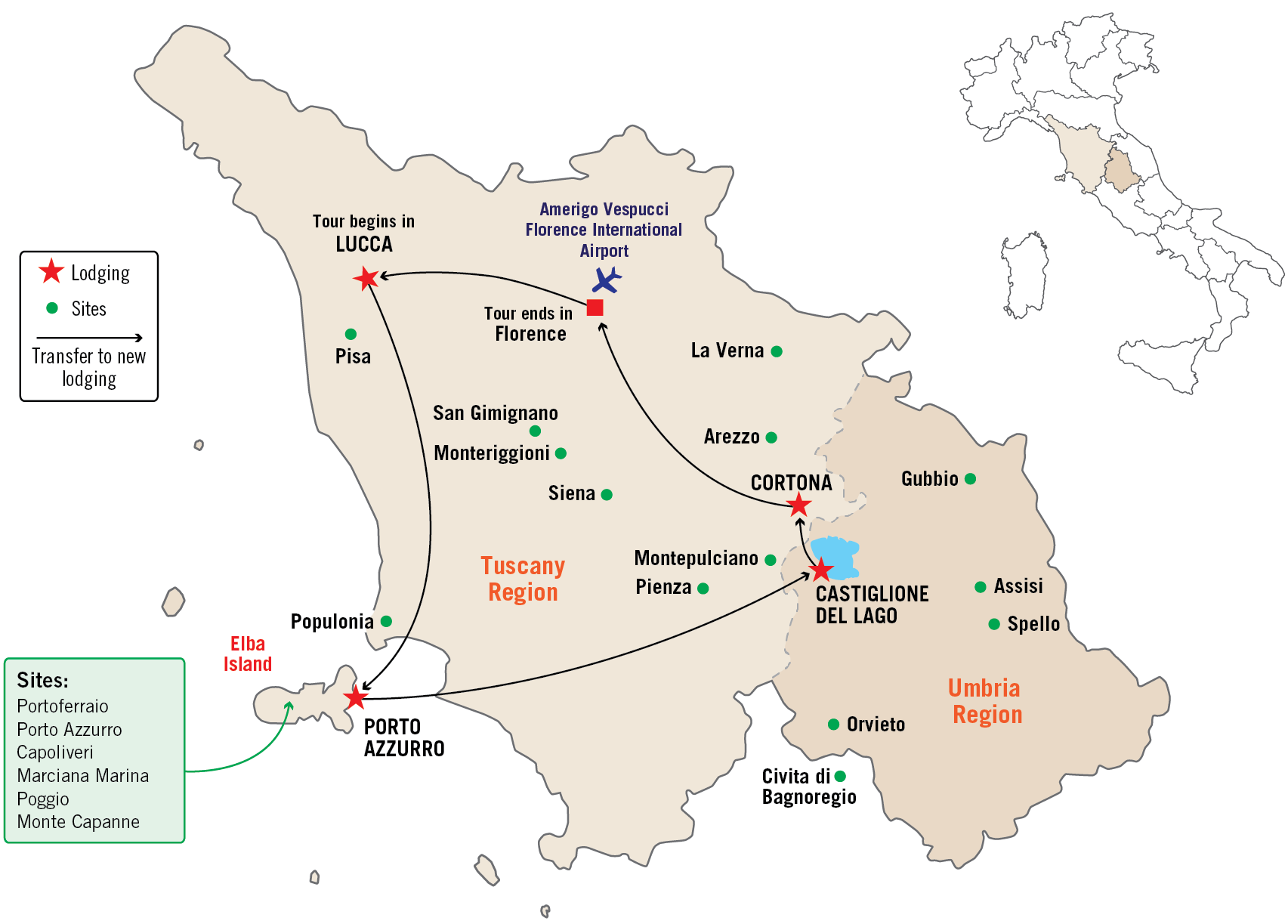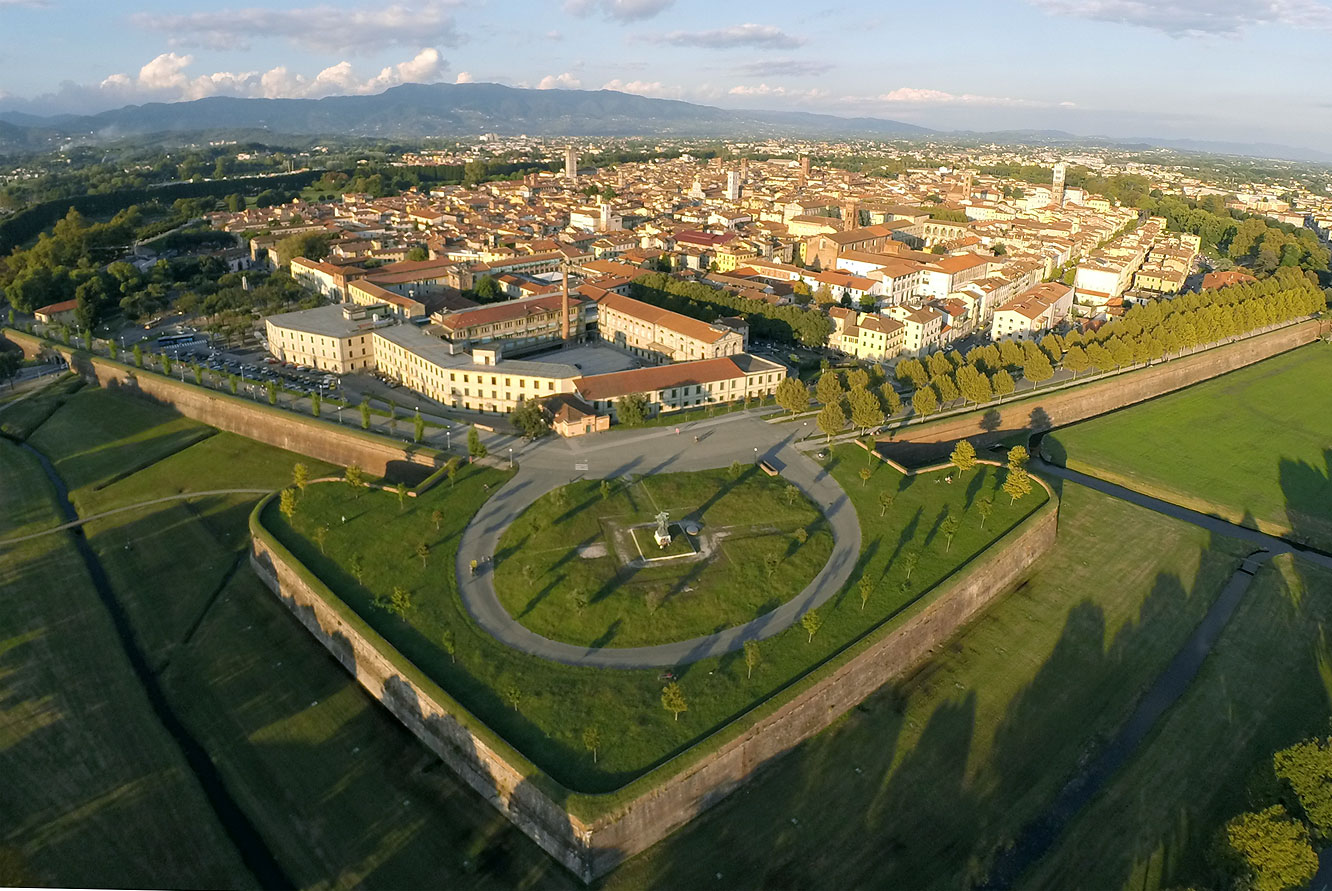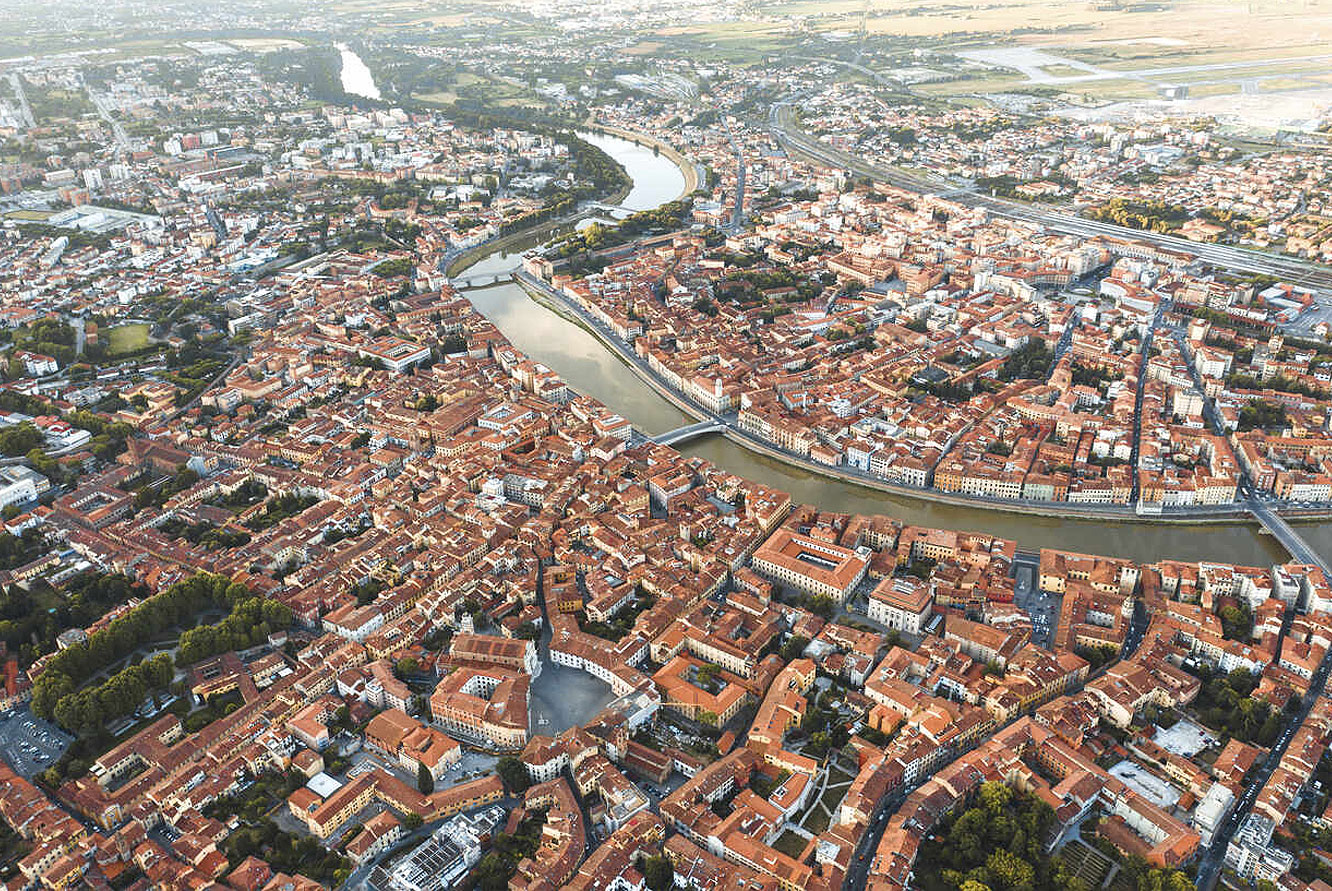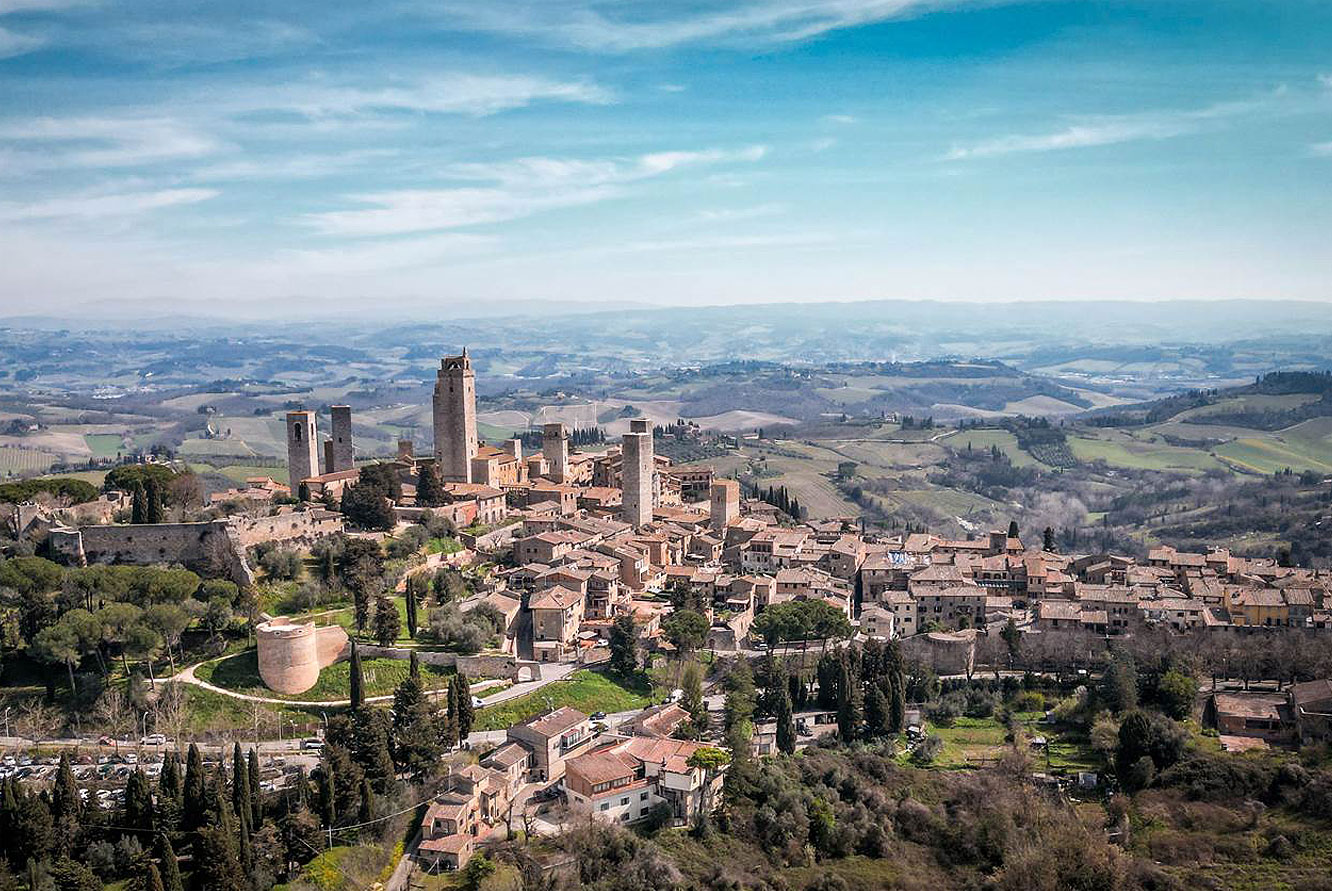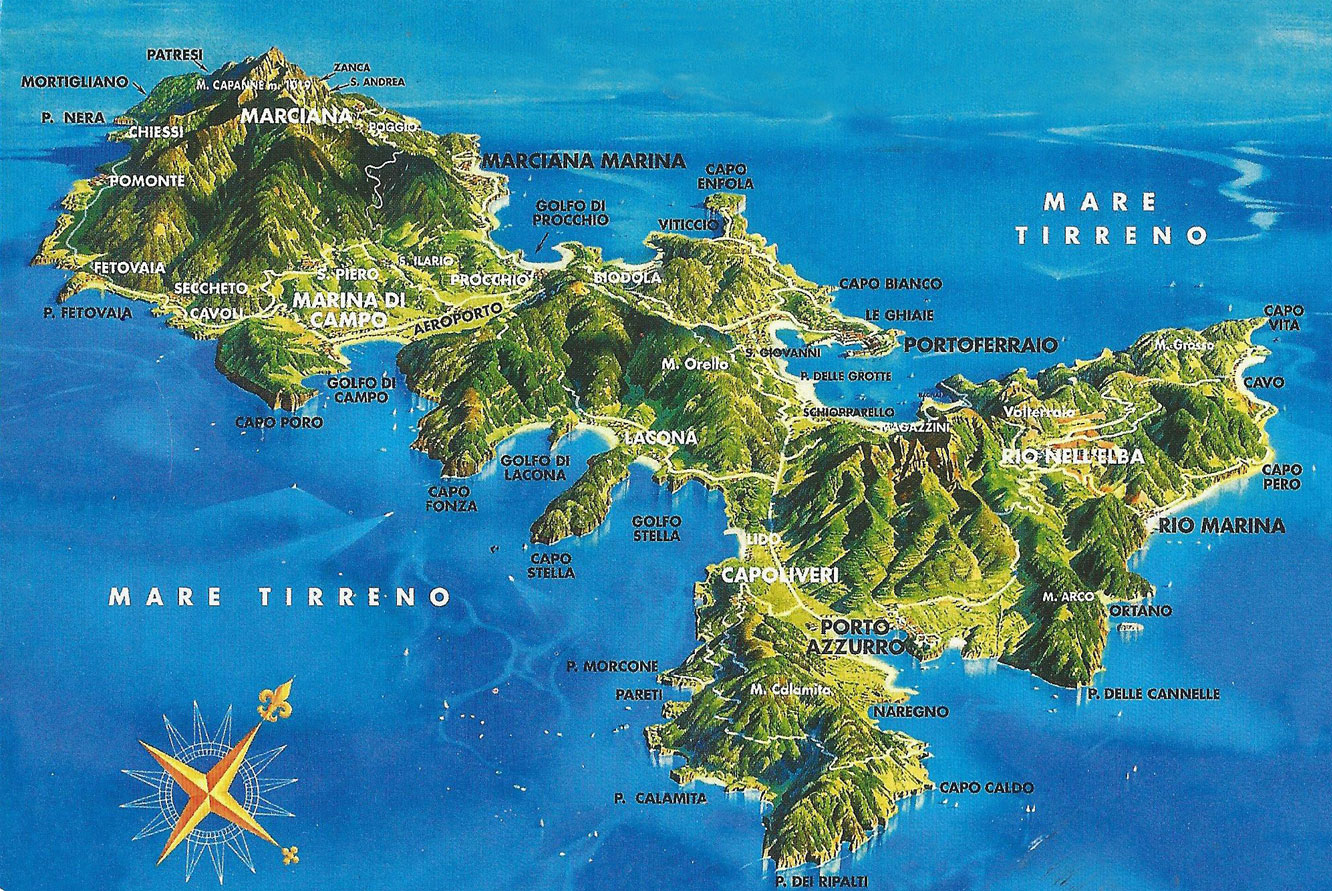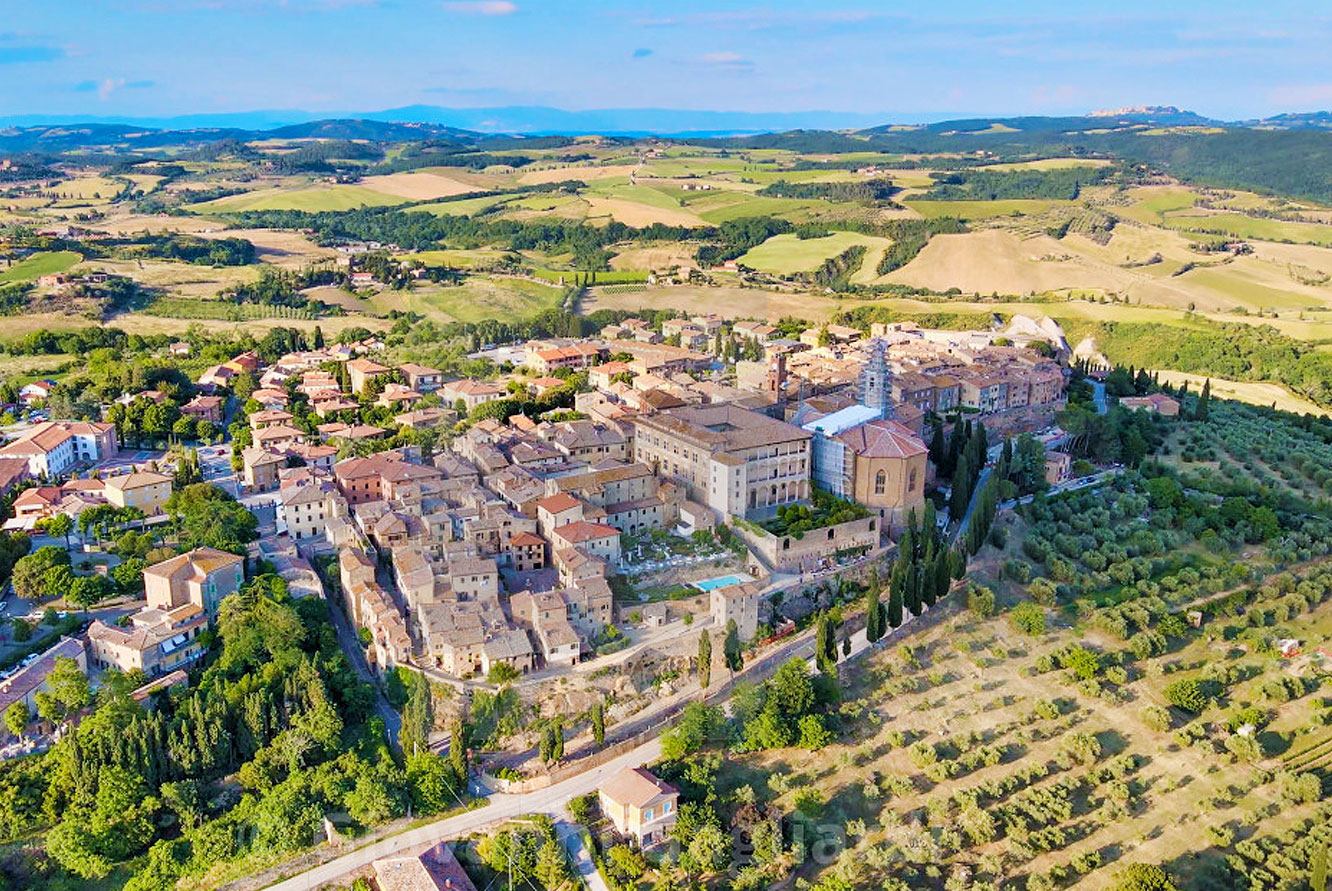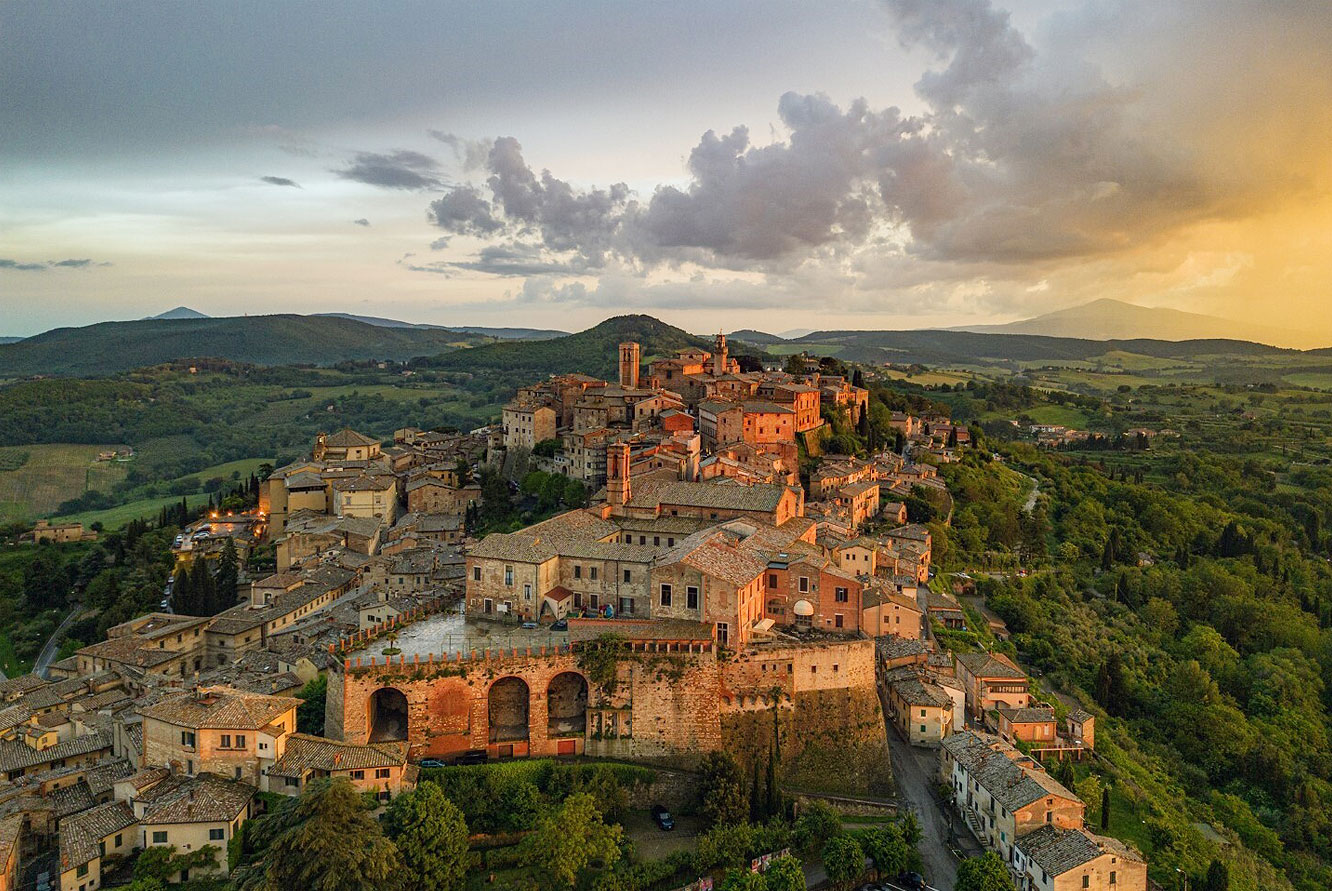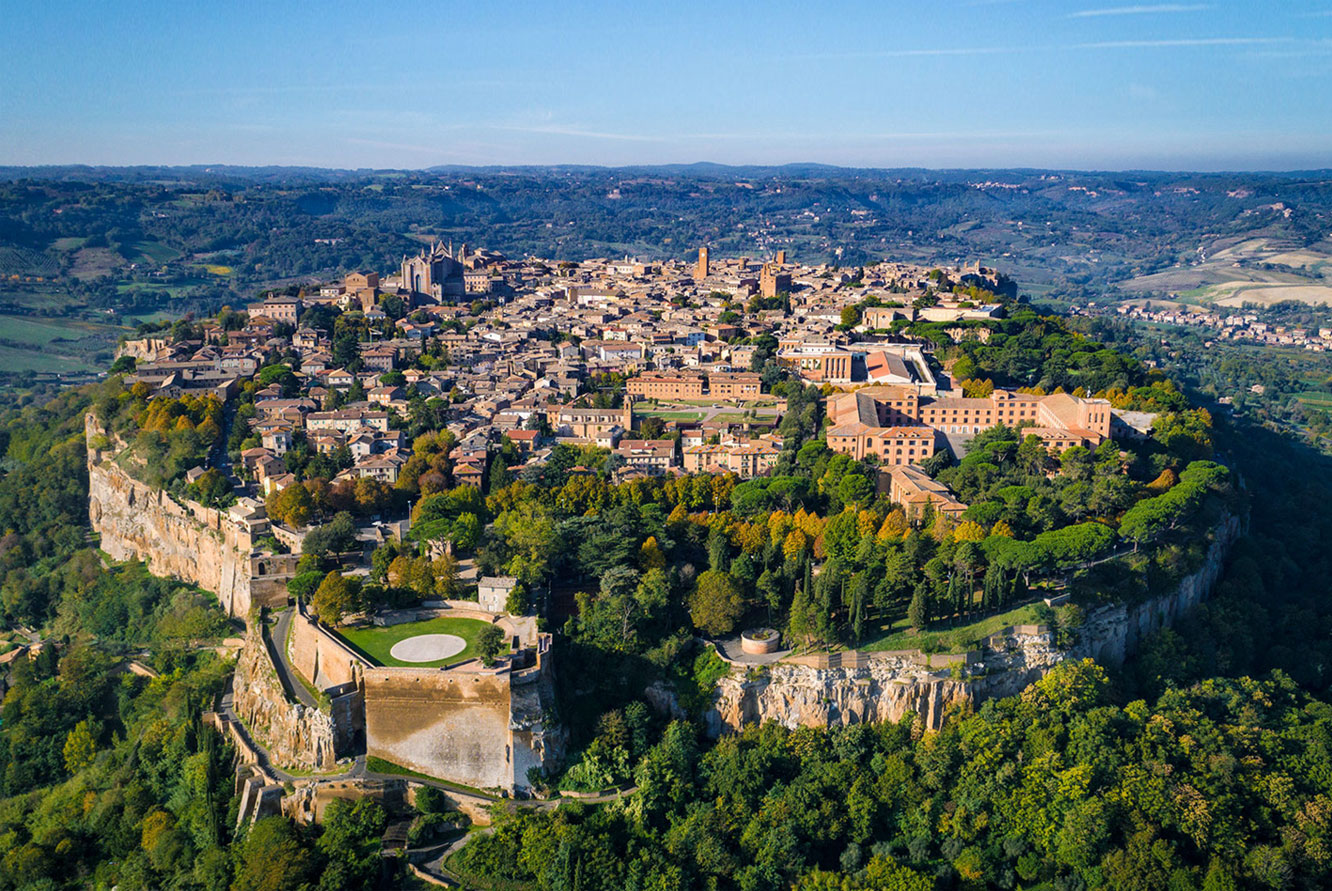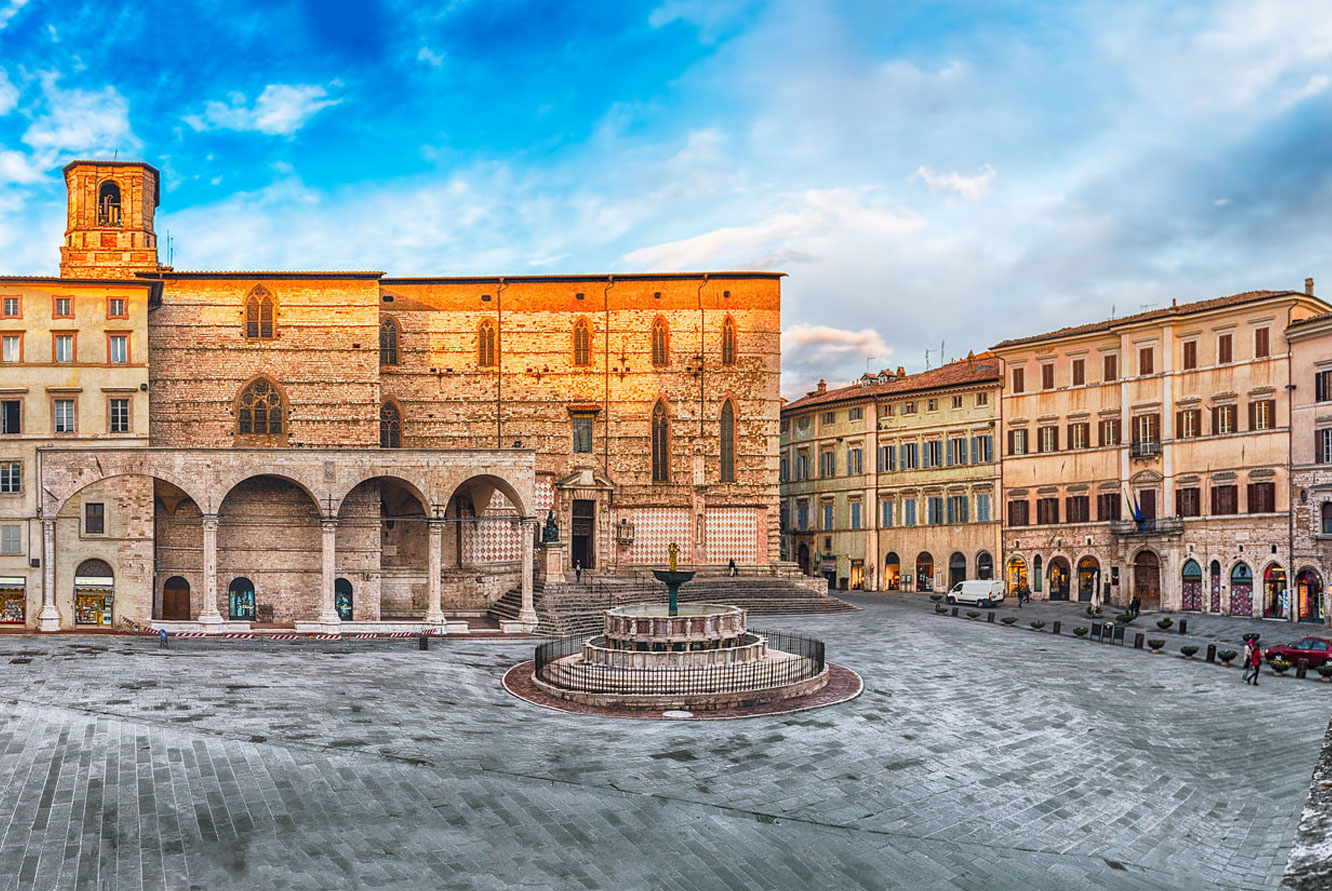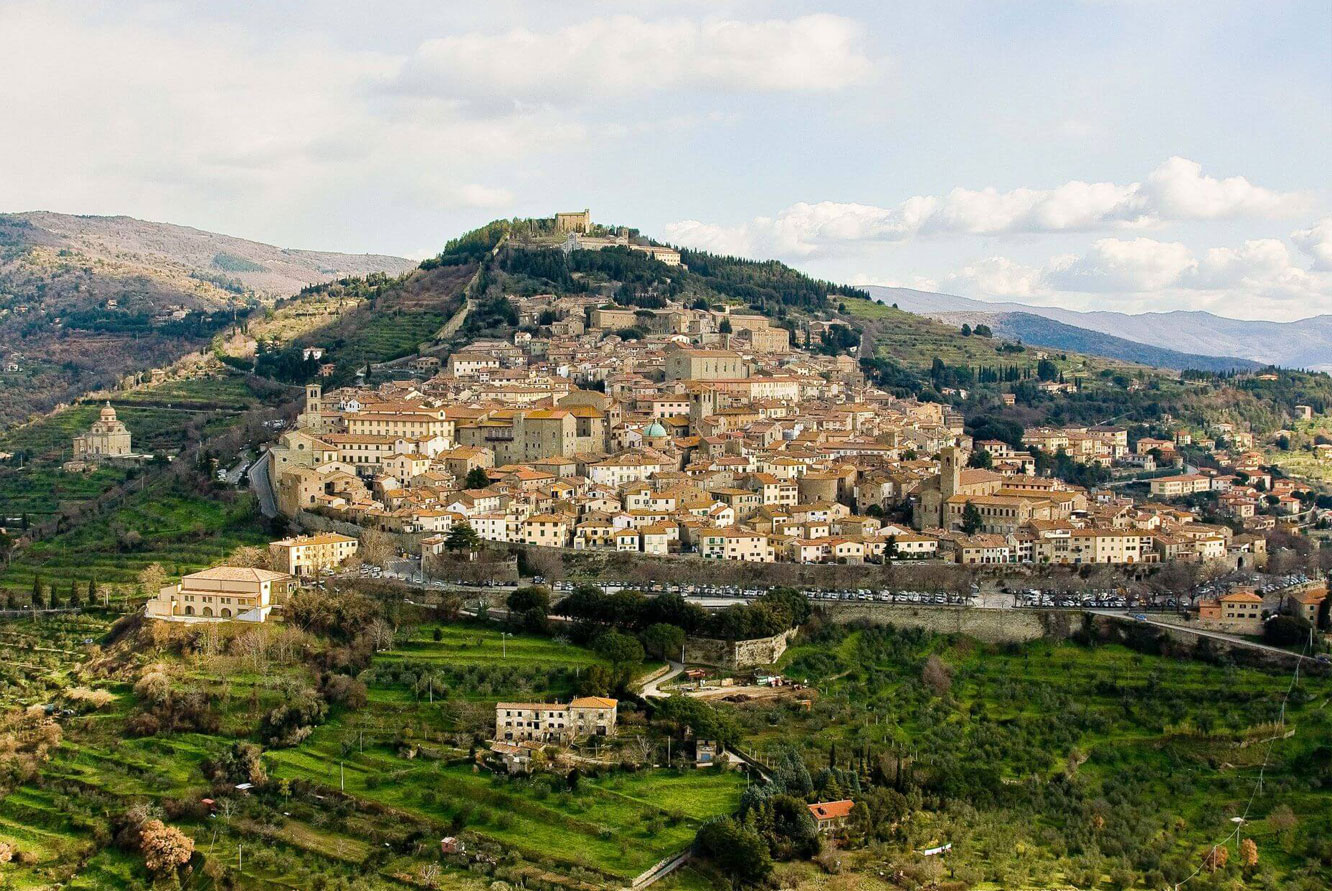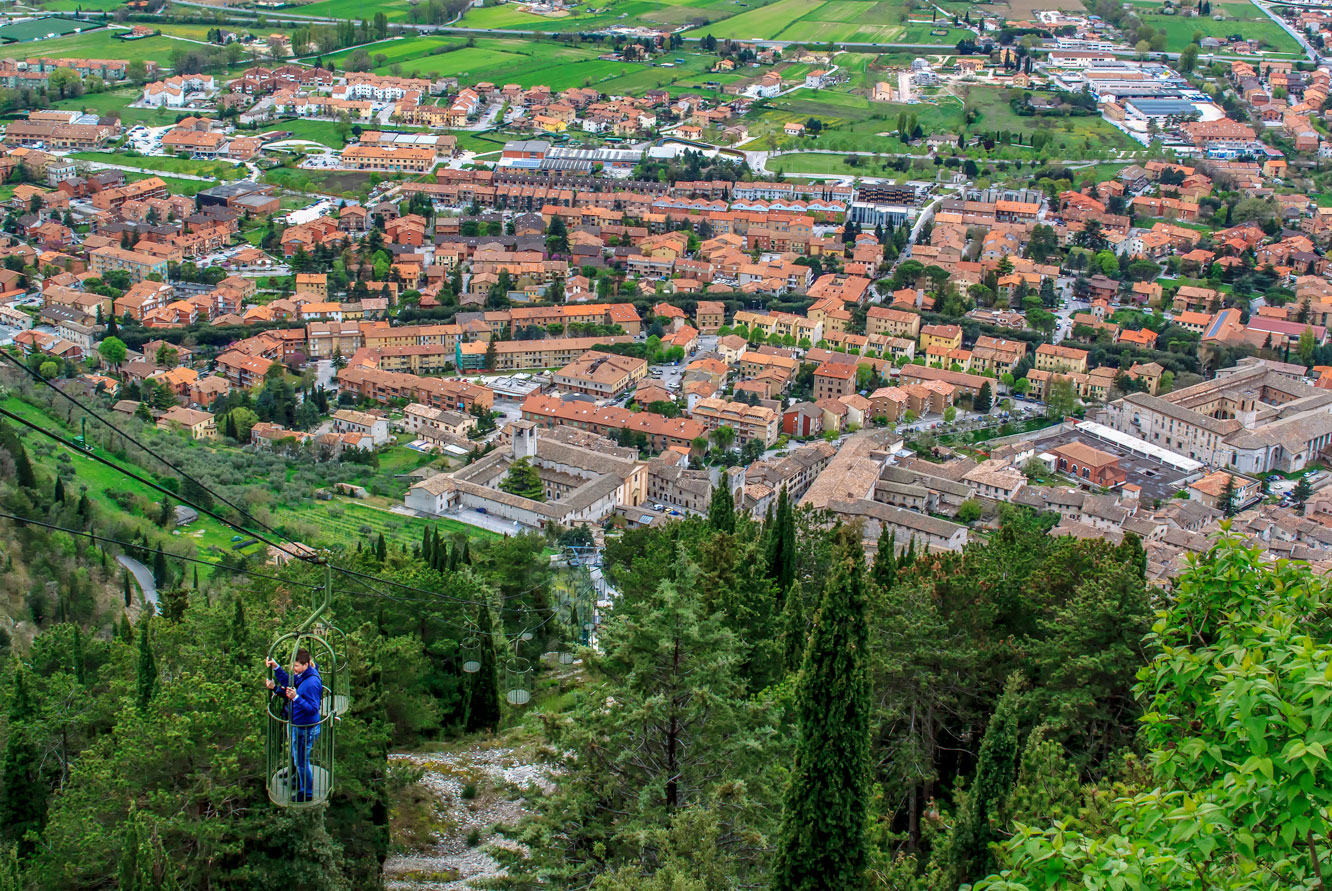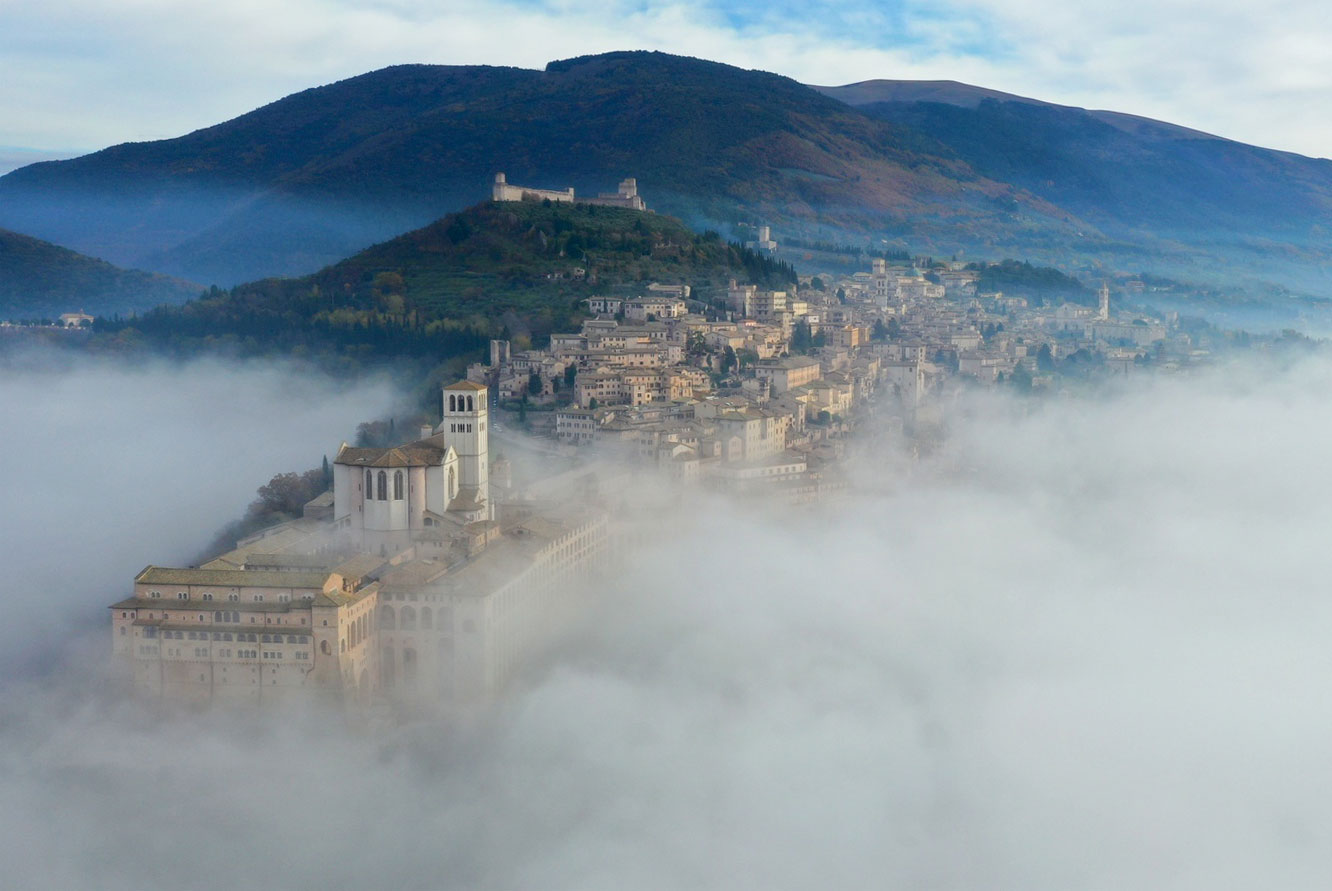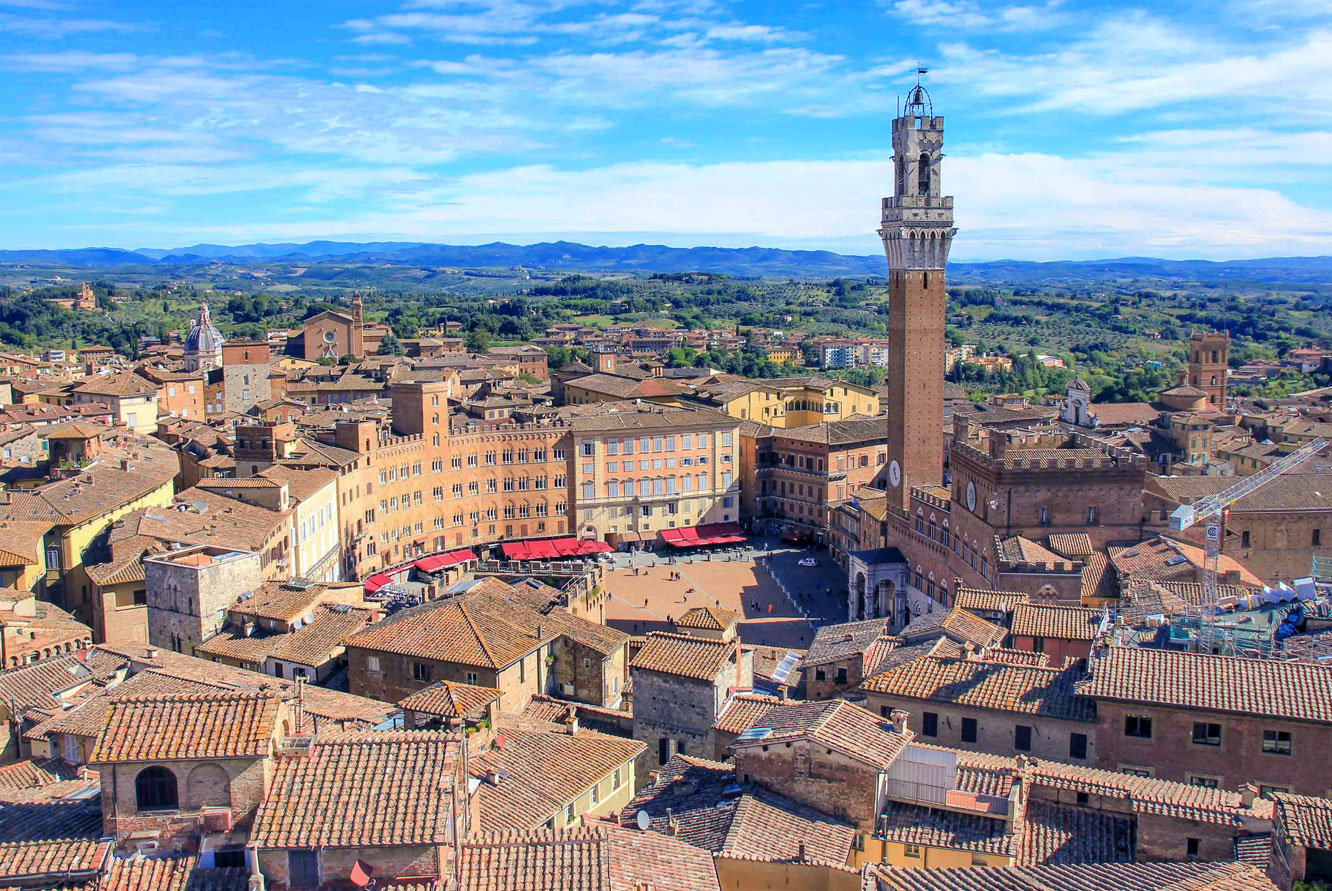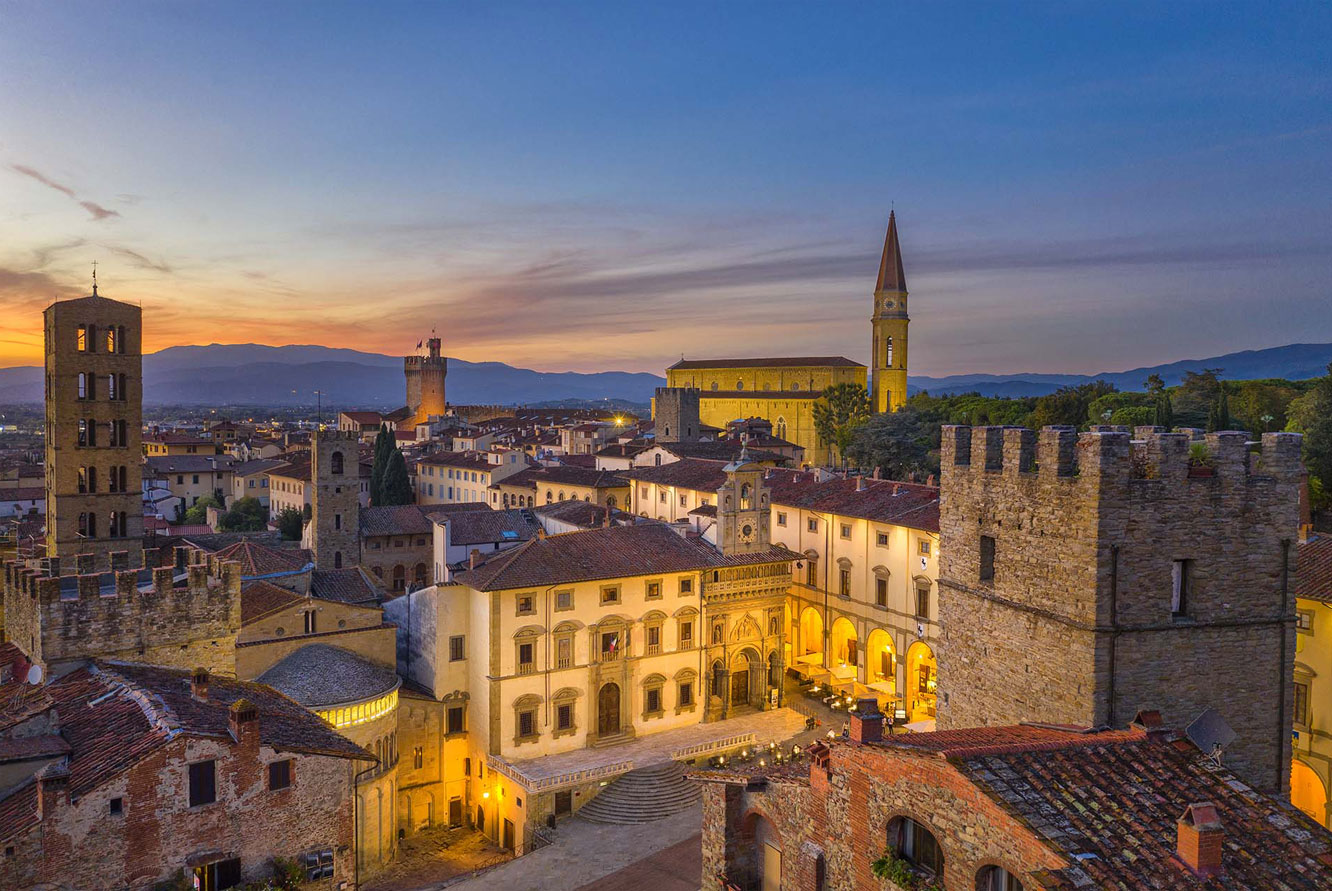~ TUSCANY & UMBRIA ~
Welcome to Italy, the Journey Begins in Lucca
Airport pick up.
Hotel check-in (3 night stay).
Options available according to arrival time.
Welcome Aperitif.
Dinner at the hotel.
Lucca
Lucca was founded by the Etruscans and became a Roman colony in 180 BC. The rectangular grid of its historical center preserves the Roman street plan and traces of the amphitheater can be seen in Piazza dell’Anfiteatro. Lucca, a town of merchants and weavers, maintained its autonomy as an independent state for several centuries until 1805 when it was conquered by Napoleon, who installed his sister Elisa Bonaparte Baciocchi as Princess of Lucca. Lucca is a remarkable art city, famous for its monuments, especially the 16th century walls which remain intact, even as the city expanded and modernized, unusual for cities in the region. Initially built as a defensive rampart, once the walls lost their military importance they became a perimeter of about 4,223 m (13855 ft) around the historic center with broad, tree-lined pathways which serve now as a bicycle lane and a pedestrian promenade, the Passeggiata delle Mura Urbane. Lucca is known as the city of 100 churches among which the most interesting are certainly San Frediano and San Michele and the Cathedral of San Martino. The opera composer Giacomo Puccini was born here and the city holds Concert Festivals showcasing his operas every night in the San Giovanni Church.
The Charming City of Lucca
Morning
- Walking guided tour:
- Duomo di San Martino, Lucca Cathedral.
- Piazza dell’Anfiteatro, one of the most suggestive squares in Tuscany, with its elliptical shape and the colorful buildings that surround it.
- San Michele in Foro, the Roman Catholic basilica located where the ancient Roman Forum once stood.
Afternoon
- Free time or optional activities:
- Torre Guinigi, the tower with a unique small garden at its summit.
- Taking a characteristic and pleasant bike ride atop the ancient city walls.
Duomo di San Martino
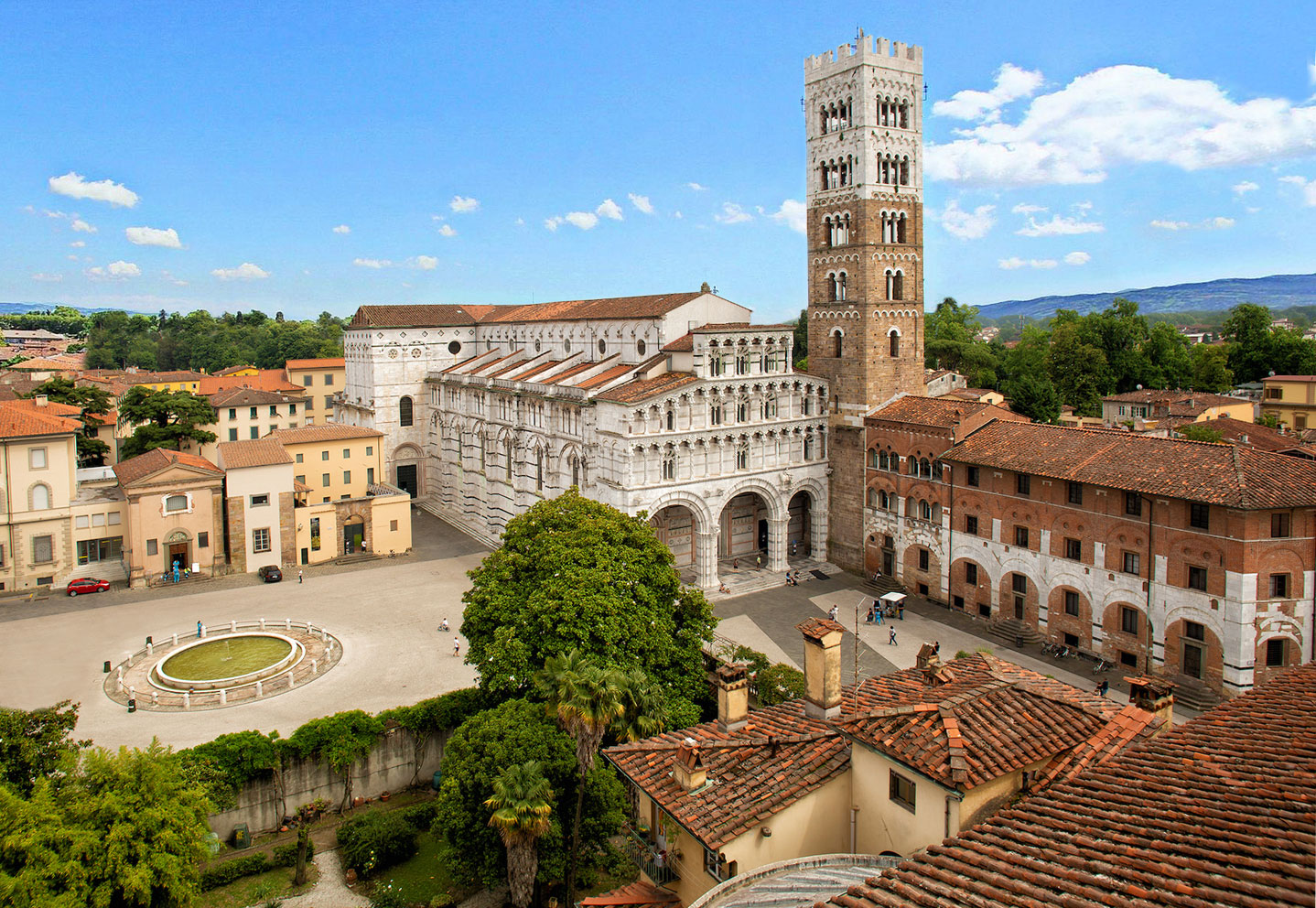
San Martino Cathedral is located in a secluded place, which is quite unusual for a cathedral generally found in the center of the city. The Cathedral, with its polychrome marble façade, inspired by the cathedral of Pisa, stands solemn and elegant, surrounded by civil and religious buildings. It was built in the 6th century in Gothic and Romanesque styles and dedicated to San Martino, who was a knight. One of the 3 arches of the portico is smaller due to the pre-existing bell tower, 60 m (197 ft) high and equipped with 7 bells. A labyrinth, a symbol linked to pilgrimage, is carved on the pillar close to the bell tower. In fact it is said that under the portico the pilgrims traveling along the Via Francigena used to trade with money changers. The marble inlay floor inside the Cathedral, with a mix of geometric and religious themes, is reminiscent of the one in the duomo of Siena. The church houses the funeral monument of Ilaria del Carretto, the Holy Conversation painting by Ghirlandaio and the Last Supper painting by Tintoretto.
Piazza dell’Anfiteatro
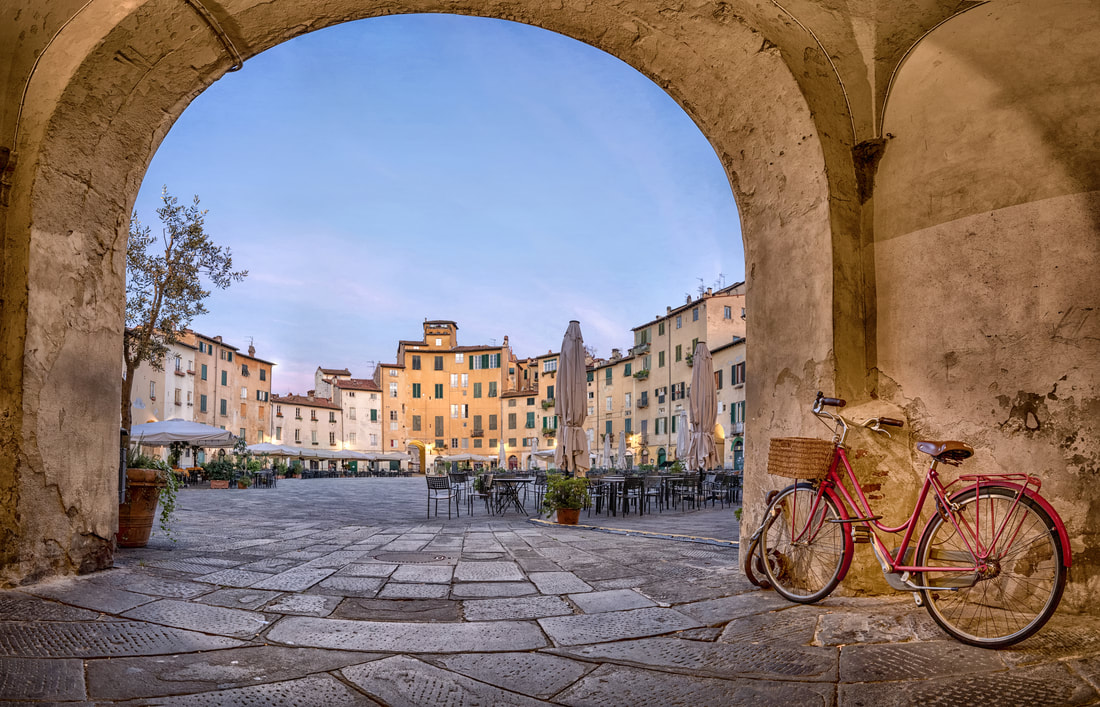
Where several centuries ago gladiators fought for their lives, today there is the bustling piazza where tourists and locals enjoy food and drinks. The square, takes its name from what was once the Roman amphitheater built in the 2nd century outside the city walls of the time, to be more easily accessible by the people who lived in the neighboring areas. It was made up of two superimposed orders of 55 arches and could hold up to ten thousand people. During the barbarian invasions and then in the Middle Ages, the amphitheater was plundered and at one point transformed into a fortress. What can be seen today is the result of a restoration by the architect Lorenzo Nottolini who in the 19th century had some of the buildings that were built inside demolished, bringing the square back to the original elliptical plan of the old amphitheater. The base and parts of the structure of the amphitheater are buried nine feet below the ground, and what remains of the vaults and arches have been incorporated into the modern shops, cafes, and houses that circle the plaza.
San Michele al Foro
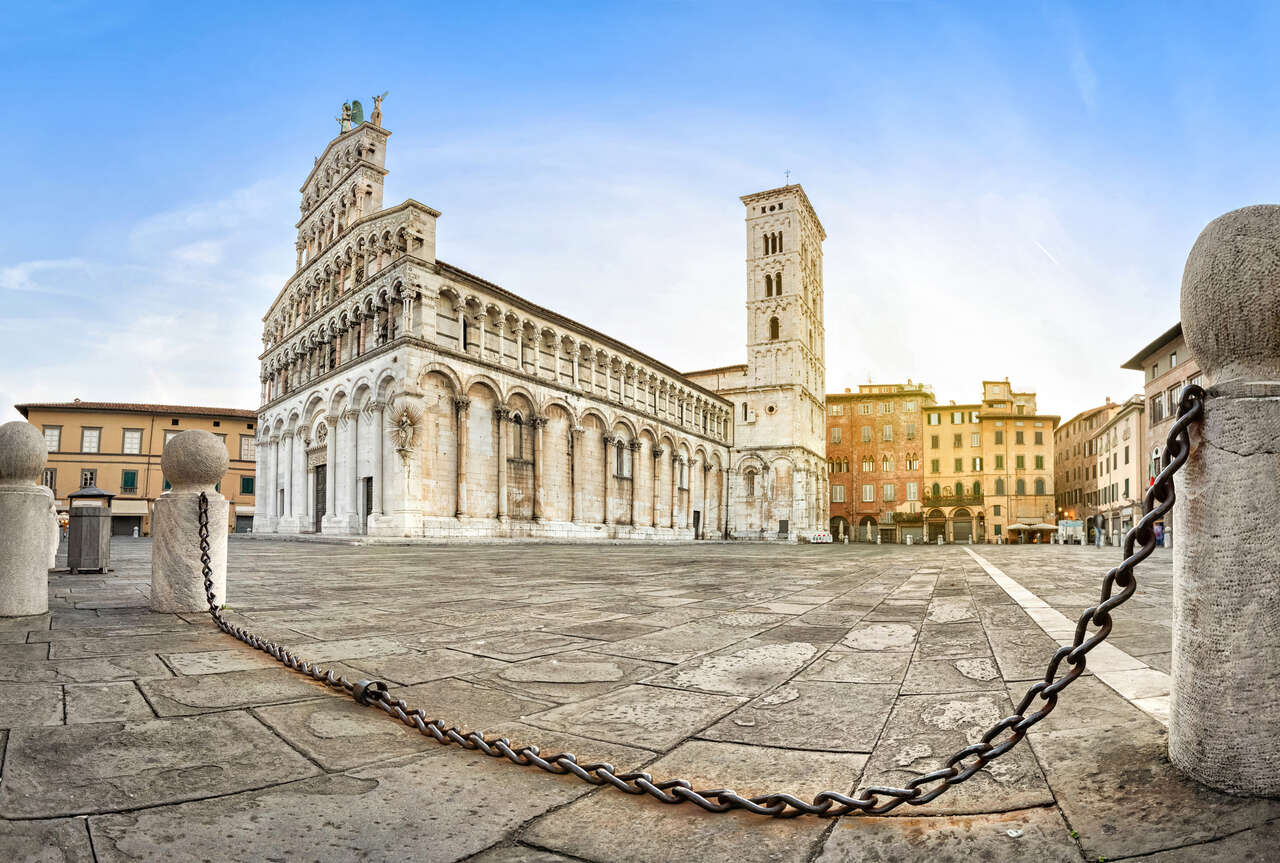
San Michele al Foro is a Roman Catholic basilica built on the remains of the ancient Roman forum and was designed to be dedicated to the Archangel Michael. The church as seen today is the result of a project begun in the 11th century in the Romanesque style and finished in the 13th century in the Gothic style when the magnificent façade was added. The latter is a true masterpiece made up of two parts, the lower one with 6 blind arches and the central portal, while the upper is divided into 4 levels of loggias supported by columns of different materials, inlays and styles. In harmony with the rest is the bell tower completed in the 12th century. The more sober interior with the nave supported by arches on monolithic columns, houses two splendid works of art, a terracotta of a Madonna with Child by Andrea della Robbia and the beautiful Pala Magrini by Filippino Lippi, an altarpiece representing Saints Rocco, Sebastiano, Girolamo and Elena.
La Torre di Guinigi
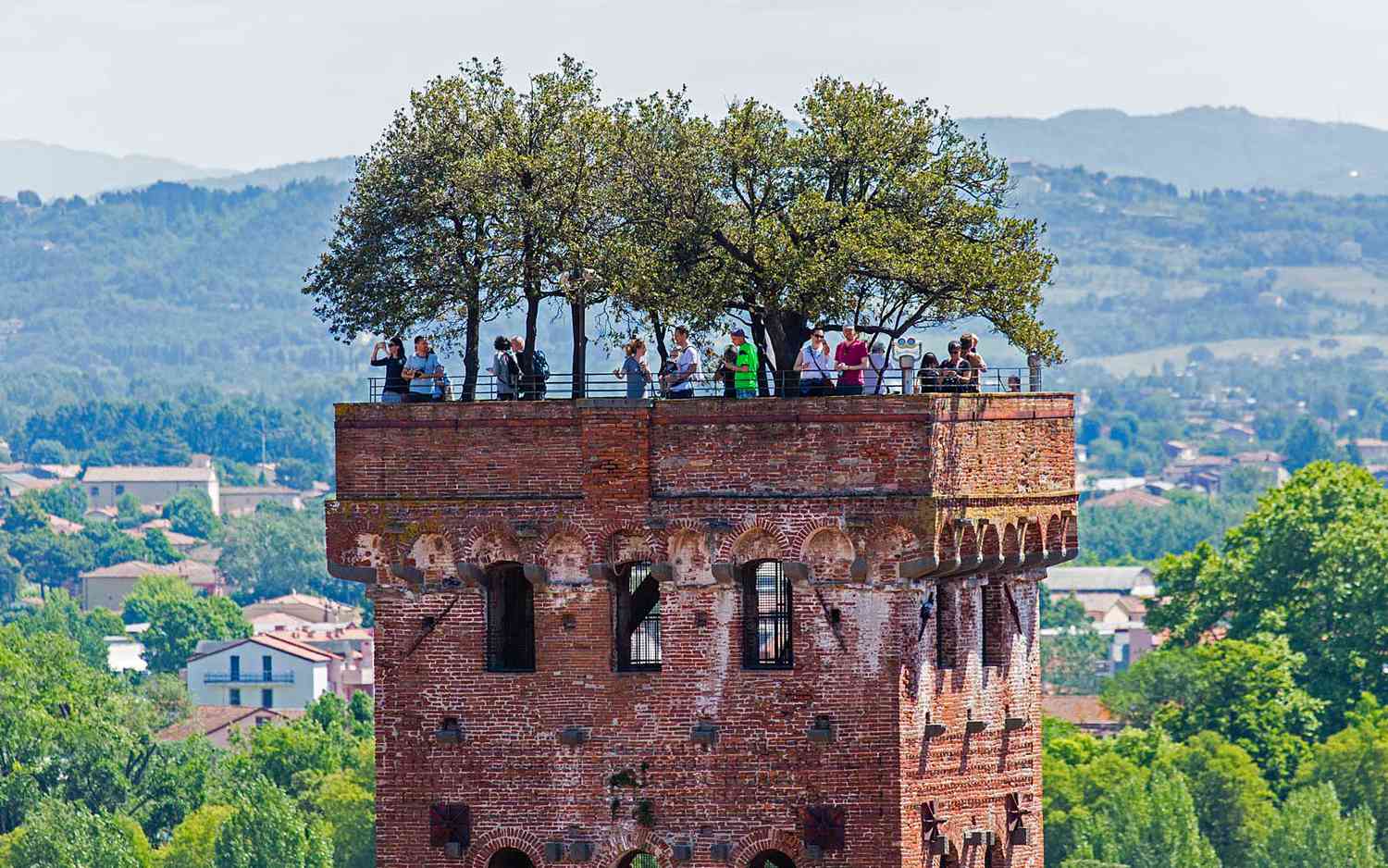
Lucca is also known as the Città delle Cento Torri (City of the Hundred Towers). One of the most famous is the Guinigi Tower that has survived over the centuries together with the nearby Torre delle Ore (Tower of the Hours). It was built in the second half of the 14th century and took its name from the Guinigi family, bankers and wealthy merchants and rulers at that time in Lucca. Today is an unmistakable symbol of the city, thanks to the holm oaks growing in the hanging garden at the top. Built of stone and brick, it is a typical example of Lucchese Romanesque-Gothic architecture. The tower is 45 m (147 ft) high and from the rooftop, reachable by 233 steps, it is possible to admire the outlines of the three concentric city walls, the Roman center of town, and the other few remaining towers.
La Torre di Pisa
Morning
- Drive to Pisa, the town of the Leaning Tower.
- Piazza dei Miracoli (Square of Miracles):
- Duomo di Santa Maria Assunta, the cathedral, the oldest of the three structures in the square.
- Battistero. The largest baptistery in the world standing at 55 m (180 ft) high and with a circumference of 100 m (328 ft).
- Torre Pendente, the free-standing leaning bell tower.
- Campo Santo, the Monumental Churchyard.
Afternoon
- Free time or optional activities:
- Exploring the historic center passing by Piazza dei Cavalieri (Knights’ Square), then the arcaded Borgo Stretto (Narrow District) to arrive at the Ponte di Mezzo (Middle Bridge) on the Arno river.
- Museo delle Sinopie, with the original preparatory drawings for the frescoes that adorned the walls of the Camposanto.
- Museo Nazionale di San Matteo, a museum housing numerous masterpieces of paintings and sculptures from the early Middle Ages, as well as archaeological and ceramic pieces.
- Drive back to Lucca.
Pisa
Pisa’s rich history extends far beyond its most famous landmark, the Leaning Tower. The city contains churches, several Renaissance palaces, museums, lovely public parks, and bridges across the Arno, the river that also flows through Florence. In the early Middle Ages, Pisa thrived as one of Italy’s four major Maritime Republics along with Venice, Amalfi, and Genoa, and becoming dominant from a military and commercial standpoint it was able to finance the construction of important buildings that have made it today a top tourist destination: the Cathedral, the Baptistery and the Leaning Tower, all of them built with white marble. After the 15th century, due to the accumulation of silt deposited by the Arno, Pisa was cut off from the shoreline. The origins of Pisa are not clear but historians think that the ancient population of Ligurians or the Greeks founded it. Without a doubt, Pisa was occupied by the Etruscans and then became an important town of the Roman Empire. However, not many traces of that historical period are left to testify the presence of Rome apart from some sarcophagi and scattered ruins. Pisa fought against Muslim raiders and participated in the crusades which allowed it to establish new trade routes increasing its power over the other maritime republics. Pisa is also known by its predominantly cultural role thanks to the presence of one of the oldest universities in Europe, founded in 1343 and where Galileo Galilei, a citizen of Pisa, was teaching.
Duomo di Santa Maria Assunta
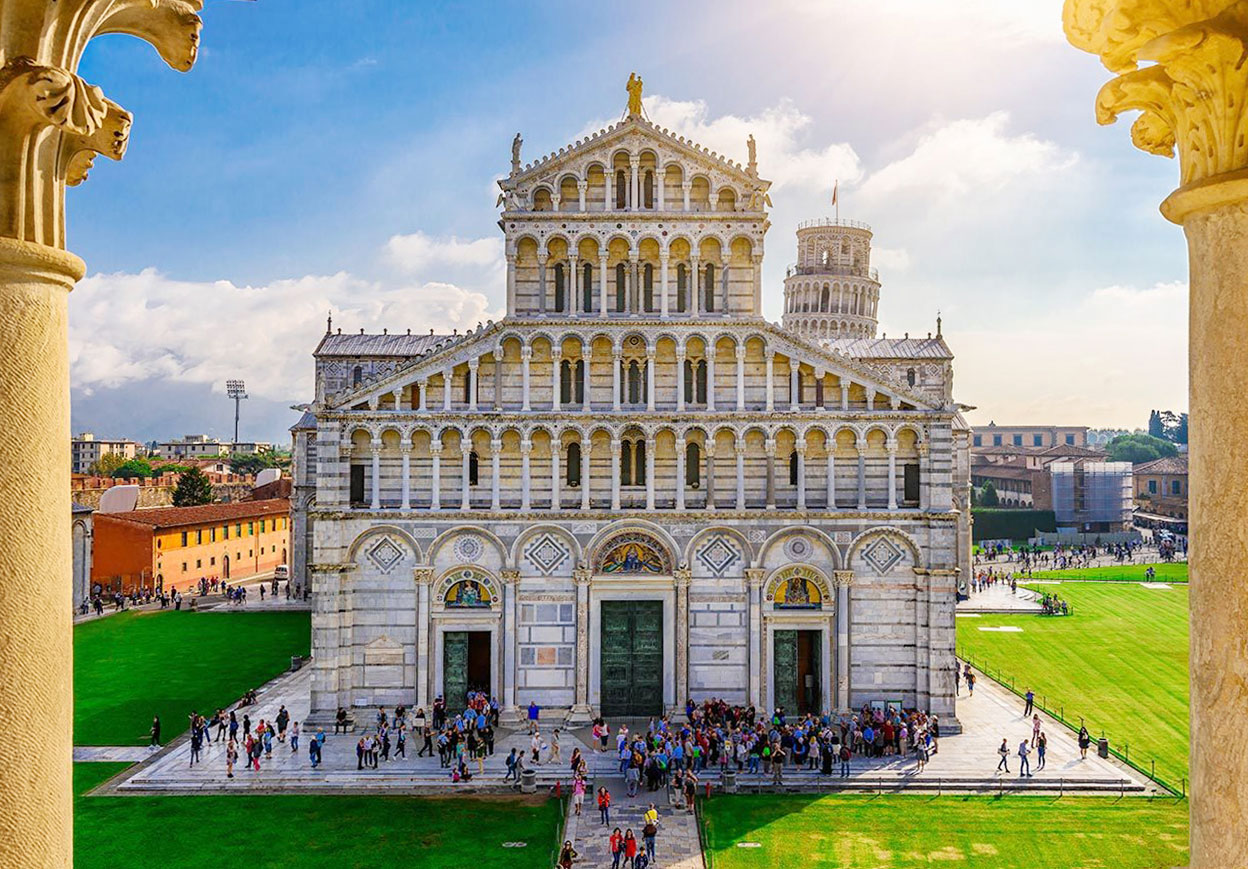
The Cathedral was built thanks to the wealth accumulated during the wars that the Pisans fought together with the Normans to free the city of Palermo from the Arabs. It was built inside a river port on the banks of what was once the Auser river, outside the early medieval walls to symbolize the power of the city which did not fear external threats. The construction began in 1063 but the Cathedral was consecrated only 50 years later when it was completed with the splendid façade. It is decorated with several styles: Lombard-Emilian, Classical, Byzantine and Romanesque. Inside are of particular note the ceiling decorated with 17th century gilded coffers, the 68 monolithic columns which represented the number of churches in Pisa at the time. The Arab influence in the interior, with the use of raised arches, the alternation of black and white marble bands and the unusual elliptical dome, all of Moorish inspiration, made the cathedral the first of its kind in Europe at the time.
Battistero
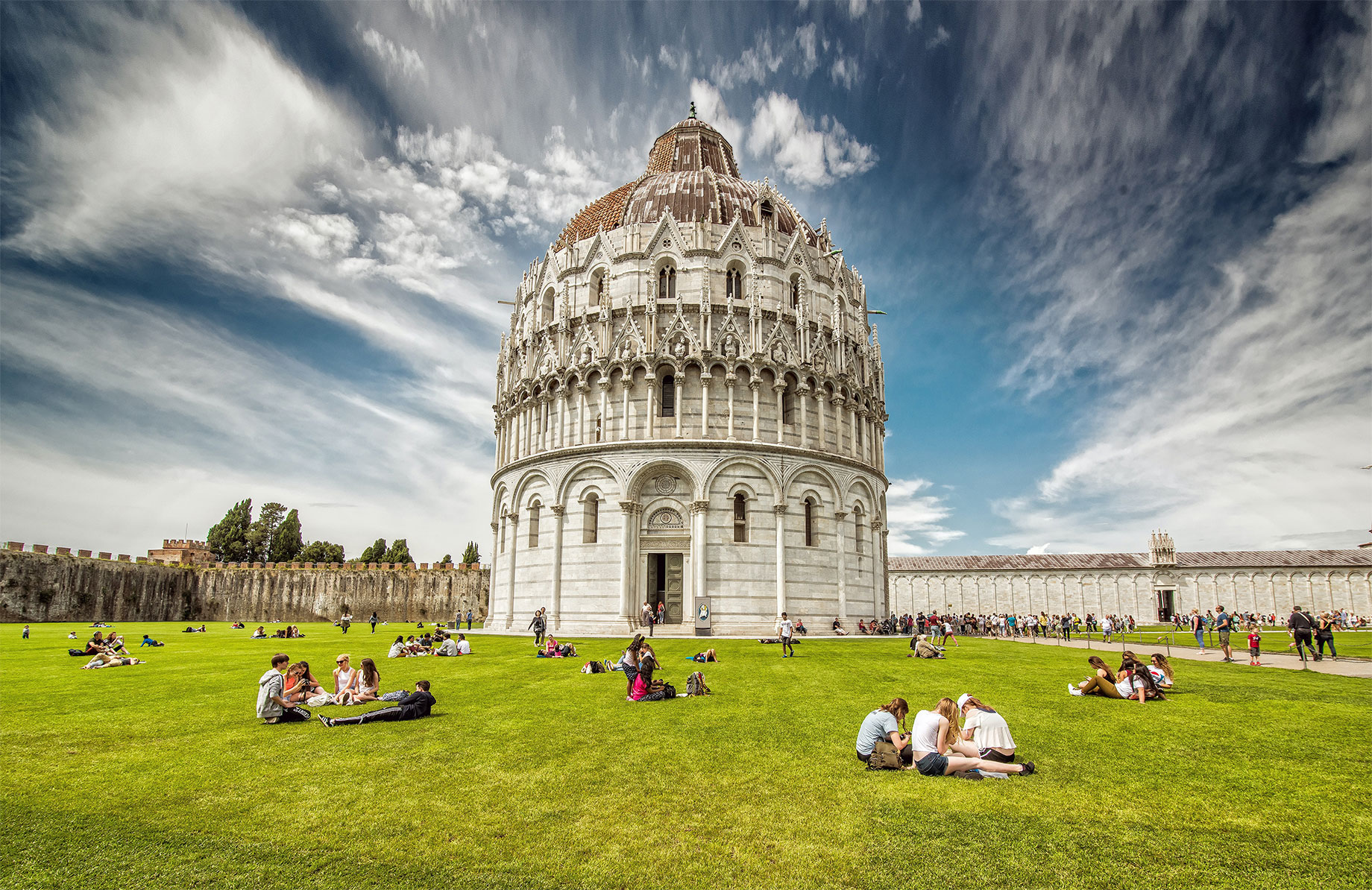
Like the other buildings located in Piazza dei Miracoli, the Baptistery, dedicated to Saint John the Baptist, was built with bichromatic recurring horizontal lines in blueish-gray marble. It stands on the same unstable ground as the tower and cathedral and for this reason, although not very noticeable, it is slightly tilted toward the cathedral. The construction started in 1152 to replace an older baptistery and was completed two hundred years later. The roof, built with a double dome, one inside in the shape of a truncated cone and the other outside with a hemispherical cap, produces exceptional acoustics that make the baptistery a real ‘musical instrument’. To demonstrate this, every half hour, a person in charge sings a few notes which, thanks to the particular reverberation, produces incredible melodies. The most important citizen of Pisa, Galileo Galilei, was baptized here in 1564.
La Torre di Pisa
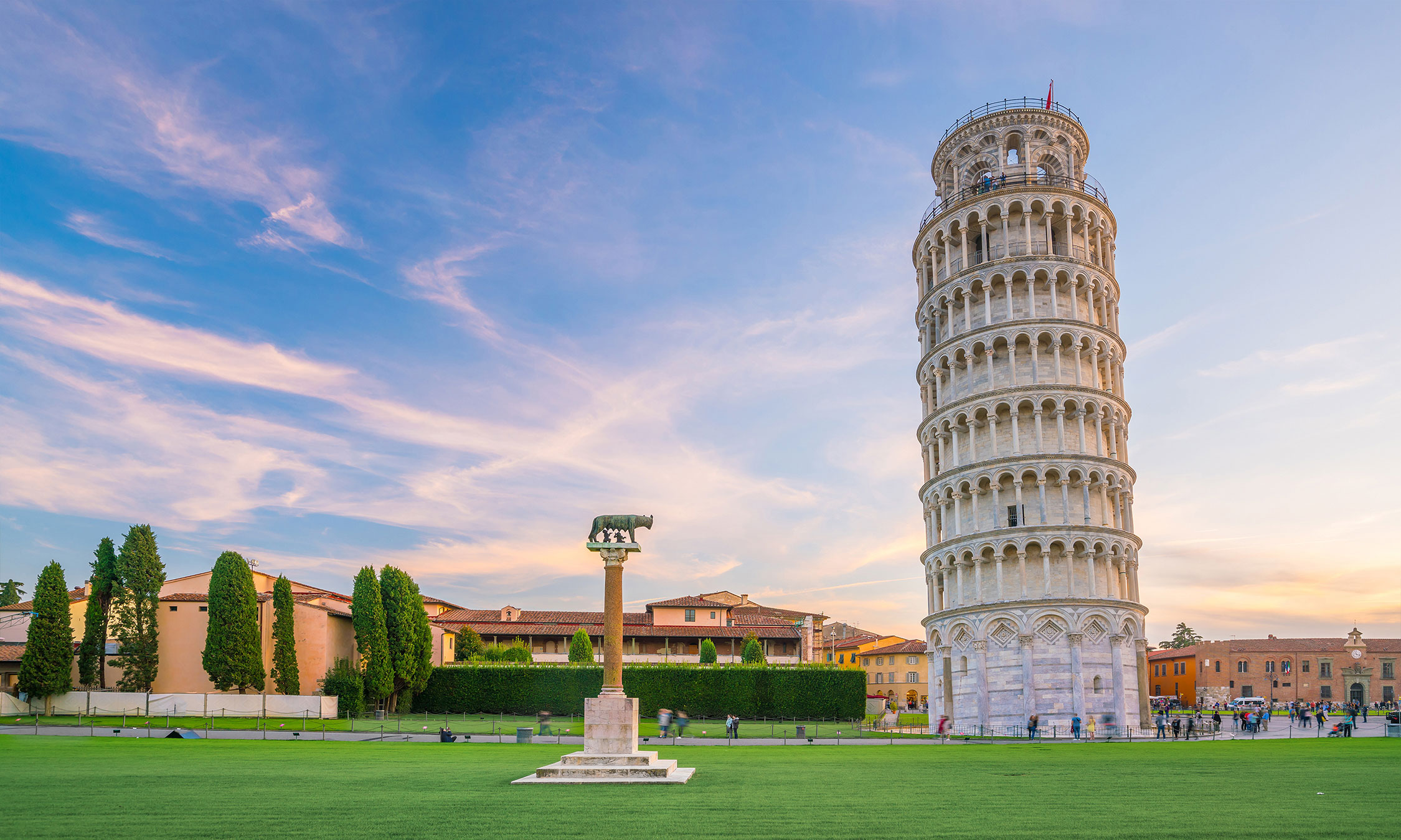
The Leaning Tower is the free-standing bell tower of the cathedral. The construction began in 1173 and reached only the first floor before it was interrupted when the building began to sag and lean due to the ground which was a mixture of sand and clay. The construction was resumed only after 100 years with the addition of the other floors, which were straightened as the height increased. The Tower is in Pisan Romanesque style with rounds of blind arches and six floors of loggias. It is about 56 m (183 ft) high and over the centuries its leaning has undergone various variations, but thanks to consolidation works carried out from 1990 to 2001 it has been reduced and according to experts this should remain as is for the next three centuries.
Camposanto
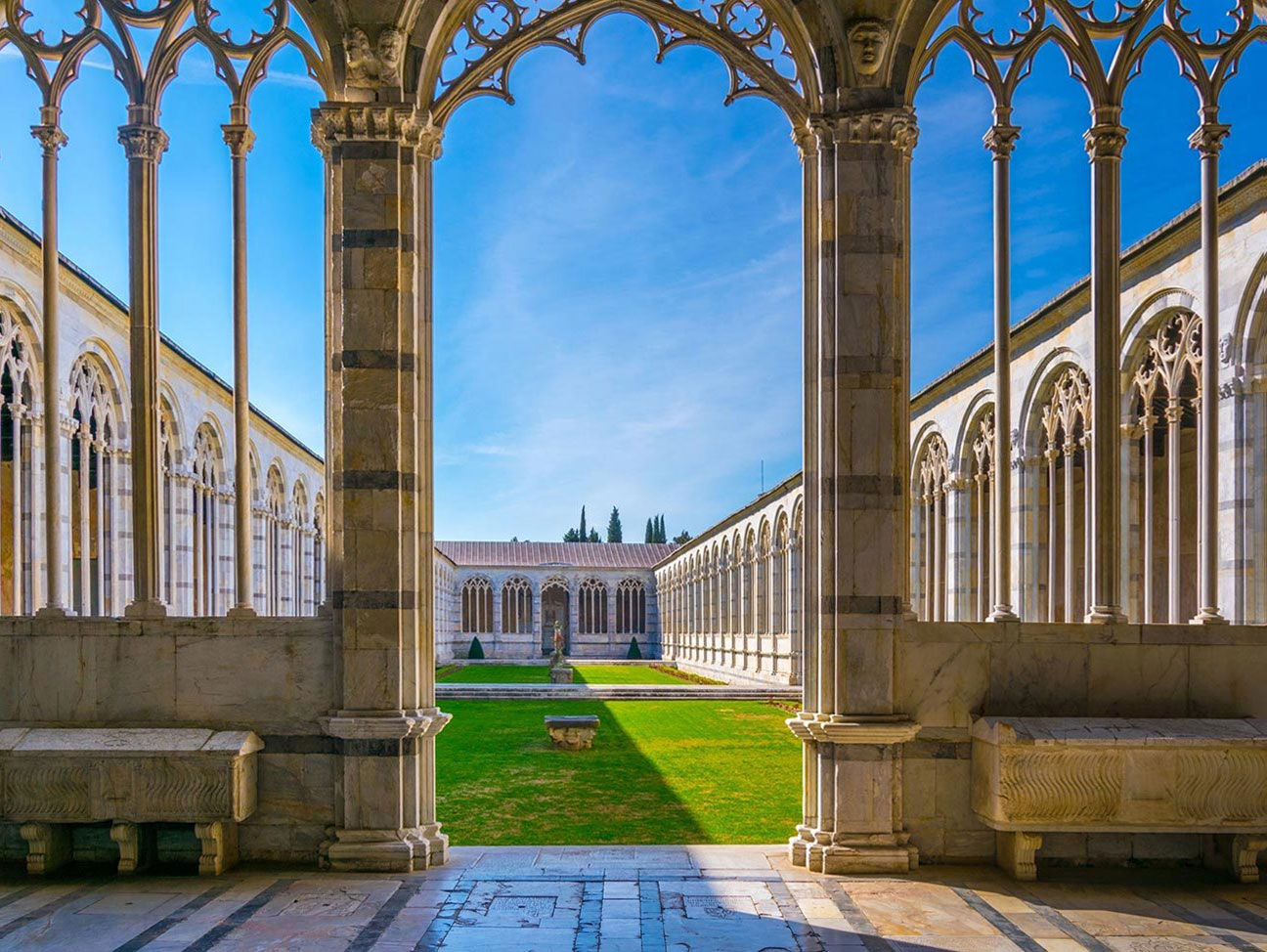
The Camposanto Monumentale (Monumental Cemetery), literally translated as holy field, is a rectangular marble building that, according to legend, was built around a shipment of sacred soil from Golgotha, brought to Pisa from the Crusade in the 12th century. The cemetery was built to accommodate the graves and sarcophagi that until then spread all around the Cathedral. During the 14th century, the inner walls were decorated with wonderful frescoes about Life and Death. It’s one of the oldest Christian Medieval structures dedicated to the devotion of the dead. In the early 19th century the monument became one of the first public museums in Europe.
2nd Leg: Moving to Elba Island
The Towers and the Walled Town
Morning
- Meet at 8:30 to leave for Isola d’Elba, Italy's third-largest island after Sardinia and Sicily.
- Stop in San Gimignano, often called the New York of the Middle Ages because of its skyline made up of tall, narrow towers.
Free time or optional activities:- Duomo, the cathedral with a 12th century Romanesque façade, a rather sober exterior that does not strike the eye, but which hides the wonders of its interior.
- Torre Grossa. Climb to the top of the tallest tower of the city for views over the picturesque countryside.
- Palazzo Comunale (Town Hall) also known as Palazzo del Popolo that houses the Civic Museum and the Pinacoteca featuring works by Florentine and Sienese artists.
- Stop for lunch in the medieval village of Monteriggioni.
Afternoon
- Drive to Piombino to take the ferry to Portoferraio, the main city of Elba Island.
- 1-hour ferry ride to Portoferraio.
- Drive to the hotel.
Welcome Aperitif.
Dinner at the hotel.
San Gimignano
Known as the Town of Fine Towers, San Gimignano’s hilltop setting, with its encircling walls and towers, is renowned for its unforgettable skyline. As with many other Tuscan cities, the history of San Gimignano dates back to the archaic Etruscan period, but it was during the Middle Ages that the city flourished when well off merchants and aristocrats built towers to show their wealth and power. A walk in the San Gimignano’s Old City, inside the 13th century walls, offers a glimpse of its past glory with 13 towers still standing out of the approximately 72 originally built. The old town grew around two centers: Piazza della Cisterna, a triangular square lined with medieval houses and a lovely well in the middle, and Piazza Duomo, with its more intricate shape where the majority of public and private buildings are located. San Gimignano, in the High Middle Ages, served as an important relay point for pilgrims traveling to or from Rome on the Via Francigena, an ancient trail starting in Canterbury, England, and ending in Rome. San Gimignano offers many local products, like saffron, extra virgin olive oil, salami and the renowned white wine, the Vernaccia di San Gimignano.
Monteriggioni
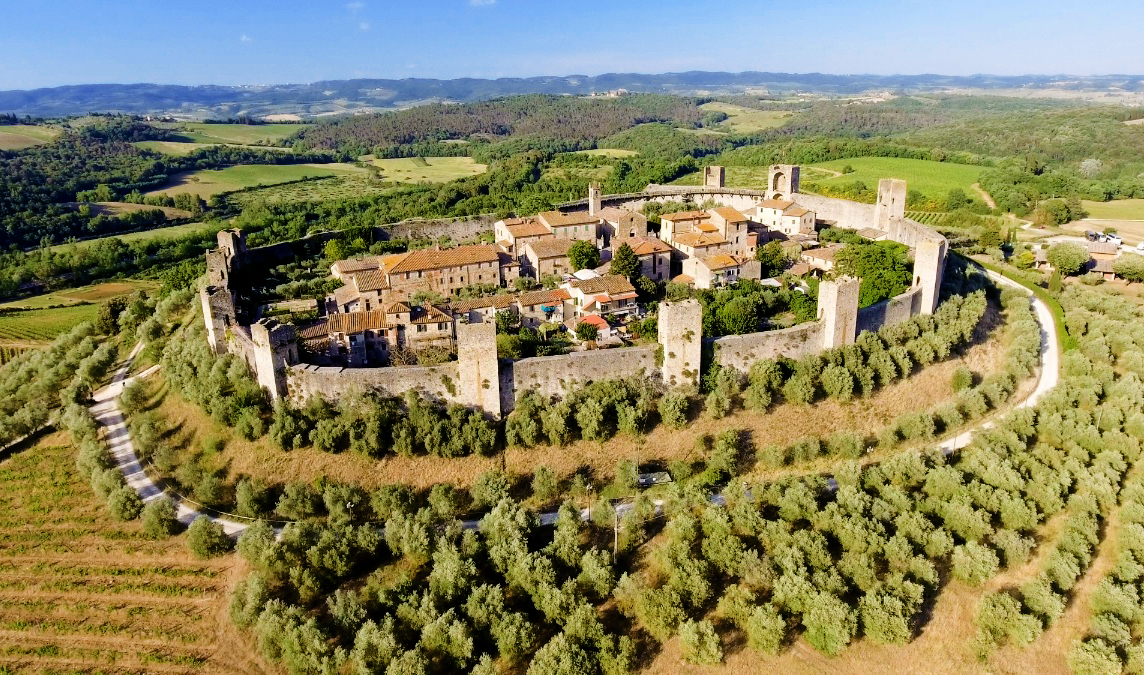
The charming Monteriggiorni was built in a strategic location in the 13th century during the conflicts between Siena and Florence. Its medieval fortifications and watchtowers wrap their way around the hilltop totalling a length of about 570 m (1,870 ft). Nowadays the walls are partially open to the public offering views of the surrounding Chianti region. In the main square, Piazza Roma, accessed via Porta Franca gate, there’s the tiny 13th century Romanesque church, next to the Armoury Museum with replicas of ancient weaponry. Monteriggioni was mentioned by Dante Alighieri in the Divine Comedy where he compares the towers of the city walls to horrific giants.
Isola d'Elba
Elba Island is located in the Tuscan Archipelago National Park on the Tyrrhenian Sea, 10 km (6.2 mi) from the coastal town of Piombino on the mainland. It is mainly known for its 100+ beaches, small bays, coves and crystal clear water, but also for being the home of Napoleon during his exile in 1814-15. Elba’s history dates back to the Ilvati, a tribe from Liguria who are believed to be the first colonizers of the island who named it Ilva. It was then inhabited by the Etruscans and later by the Romans, who were extracting and working the iron and other minerals, like Ilvaite and Magnetite, found in abundance on the island. In certain parts of the island, especially in the southeast, it is still possible to smell an intense odor of iron. The history of Elba continues in the early medieval period with the invasions of the Ostrogoths and the Lombards, later, in the 13th century it became a possession of the Maritime Republic of Pisa. Today Elba offers a great mix of options, both cultural and recreational, like archaeological findings, the Volterraio Fortress, the hilltop town of Capoliveri, the beautiful Napoleonic residences and, of course, the beaches and outdoor activities, all enriched by the deep culinary traditions and its noble wines.
At Napoleon's Residences
Morning
- Walking guided tour in Portoferraio, capital of Elba Island:
- Palazzina dei Mulini, Napoleon’s town residence located in the upper part of the historic center.
- Fortezze Medicee, the towers, the walls and the ramparts that were part of the defensive system of the city.
Afternoon
- Free time or optional activities:
- Linguella Archaeological Site which includes the Torre del Martello (Hammer Tower), the remains of a Roman villa and the archaeological museum where numerous and interesting Etruscan and Roman artifacts are kept.
- Drive to Villa San Martino, Napoleon's countryside summer residence built in neoclassical style.
- A dip in the sea.
Portoferraio
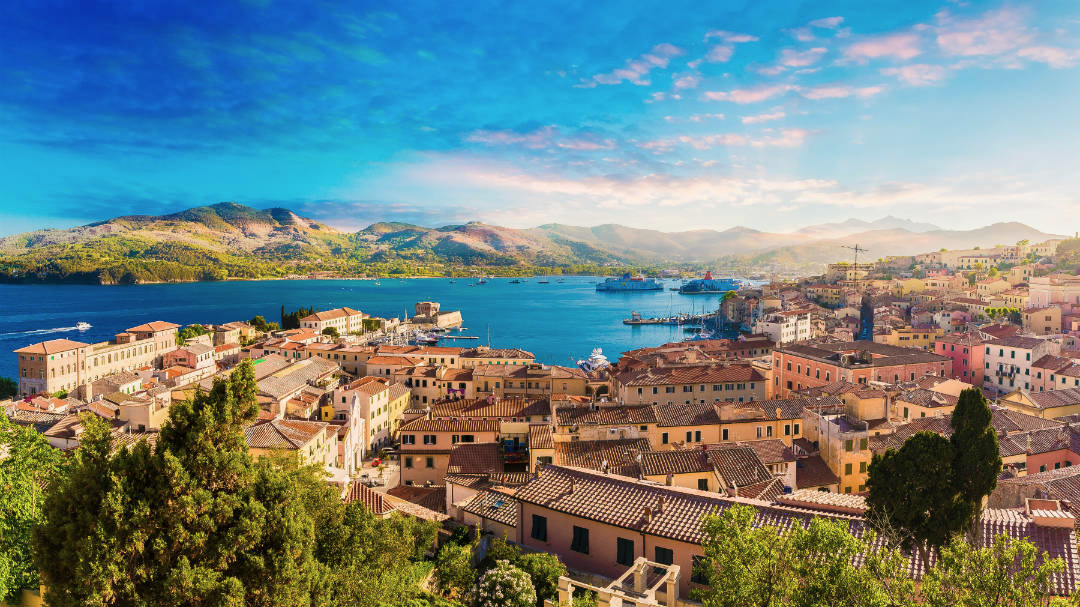
Portoferraio (Port of iron) is the most important town and major port of Elba Island, a strategic city, considered by Admiral Nelson the safest port in Europe. During the early 17th century Portoferraio, at that time called Cosmopoli (Cosimo's City), an edict by Cosimo I de’ Medici granted special privileges to all those who settled in Elba which influenced the development of the industry and economy of Portoferraio. During this period, numerous fortifications (Forte Stella, Forte Falcone, and Forte Inglese) were built, at the request of the Medici family, to protect the port from pirate raids. In 1814, during his stay in Elba, Napoleon, brought about more changes than any other leader before him. In this period, the city grew in importance and modernity, the road system was improved as well as the health care. Portoferraio should be seen from every corner, with its characteristic houses, balconies full of colorful flowers, narrow alleys, lively piazzas and breathtaking views of the sea.
Palazzina dei Mulini
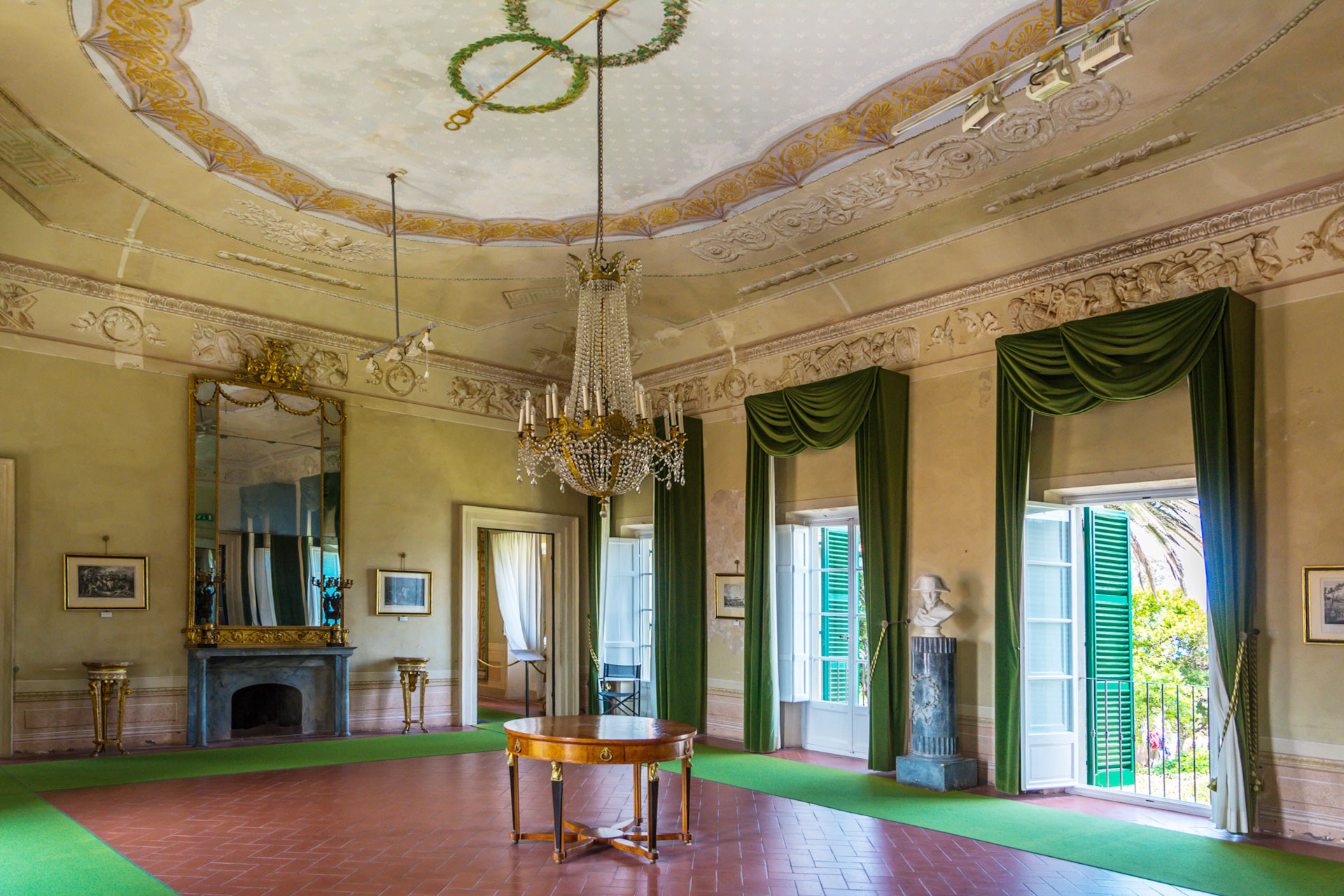
Initially built in 1724 by the Grand Duke Gian Gastone de' Medici, it was subsequently restored by Napoleon during his stay, who personally supervised the works and furnishings trying to recreate the atmosphere of the French court; this was supported by the presence of his mother and his sister, Pauline, who had joined him in exile. The Palazzina dei Mulini (Little Palace of the Mills), which takes its name from the presence of two ancient windmills, is located between Forte Falcone and Forte Stella on a spur of rock which overlooks the town and the sea below. The current furnishings of the building date back to the early 19th century and among the various rooms, the library which still preserves many volumes owned by the Emperor himself is notable. Nowadays the Palazzina is part of the National Museum of Napoleonic Residences.
Fortezze Medicee
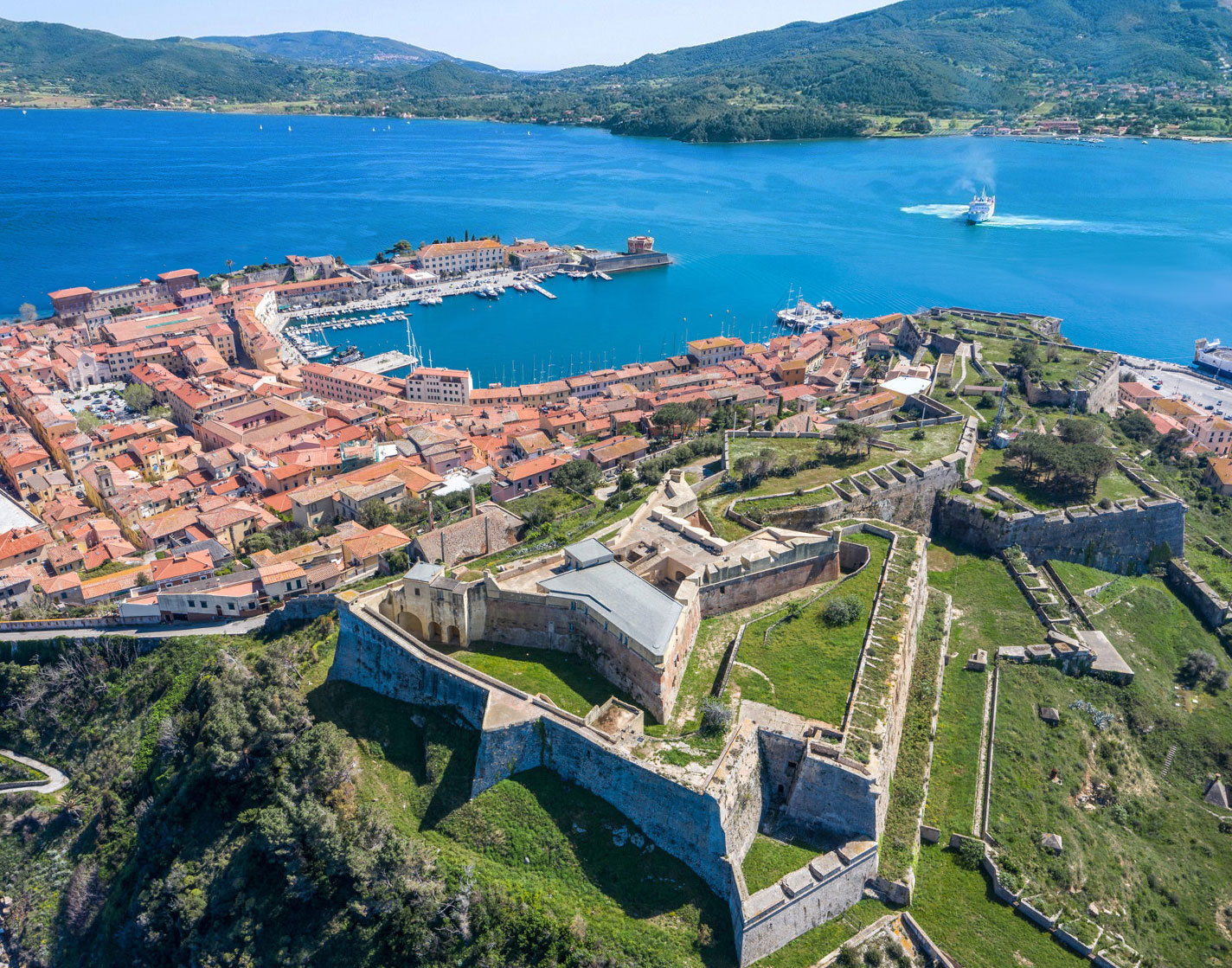
The fortresses, commissioned by Cosimo de' Medici, hence the name Medicee, are a magnificent and impressive architectural complex built to defend the Tuscan and Ligurian coasts. The most important parts are: Fort Linguella with the Martello tower located at the entrance to the dock, Fort Stella which takes its name from its star-shaped plan, and Fort Falcone, the most important, located in the highest part of the promontory. The three forts together with the walls ensured defense against invasions by sea. To complete the fortification, starting from Fort Falcone, there are bastions placed in 4 different levels and degrading towards the sea protecting the city from land invasions made even more impossible by a moat which was running along the perimeter of the bastions. There were two gateways to the city, a land road called Porta a Terra (Land Gate), which was closed in the evening and the Porta a Mare (Sea Gate) located on the pier. Walking along the fortifications it is possible to admire splendid panoramas passing through the different parks located on the three levels.
Beautiful Villages
Morning
- Drive to Marciana Marina, a charming little fishing village.
- Drive to Marciana, a peaceful medieval hilltop village, located above Marciana Marina at 375 m (1230 ft) above sea level.
- Cabinovia ride up to the top of Monte Capanne, the highest mountain on the island, to enjoy the 360° panorama opening over the whole Elba island and the Tuscan Archipelago.
Afternoon
- Drive to Capoliveri, one of the liveliest and most characteristic villages in the island with its narrow, picturesque alleys and archways called chiassi, where small craftsman’s shops lie.
- Back to the hotel for a break before going to Porto Azzurro, the azure blue harbor with traces of the Spanish rule era.
Marciana Marina
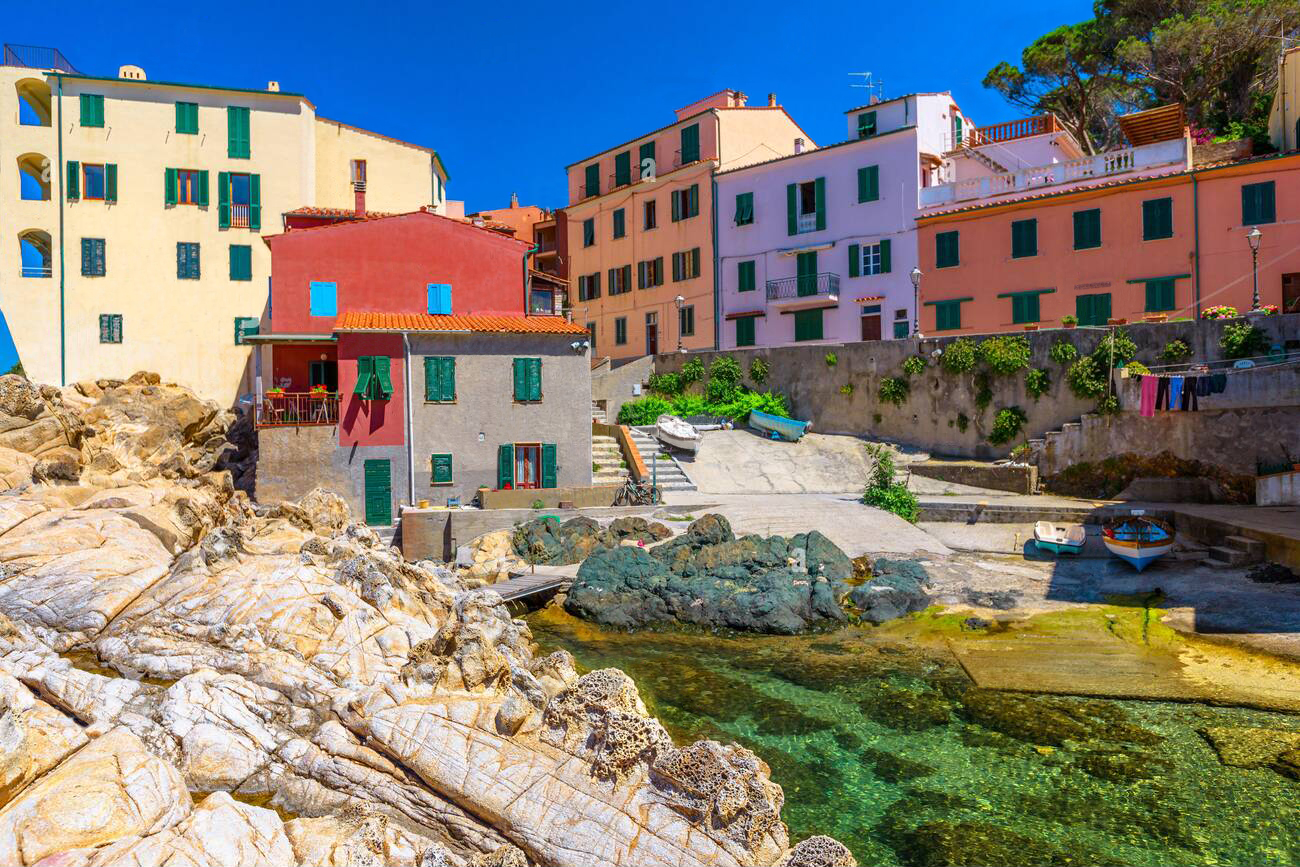
Marciana Marina by territorial extension, which is limited to the historic center, is the smallest of the 8 municipalities of the island and the third smallest in Italy. Until 1884 the town was part of Marciana, located at the foot of Monte Capanne, and was an important seaport inhabited mainly by fishermen and where boats were built and repaired using wood obtained from chestnut groves. Despite its small size, it enjoys a certain command over Elba’s trade routes, and has been nicknamed the “Little Marseille”. Although in recent years, there has been an increase in tourist-building development, the city has been able to preserve the original architectural and urban features of the 19th century. The historic center, called Cotone or Borgo del Cotone, with its narrow granite streets that intersect along pastel-colored houses looking out onto the sea, make Marciana Marina one of the most picturesque and evocative villages of the whole island.
Capoliveri
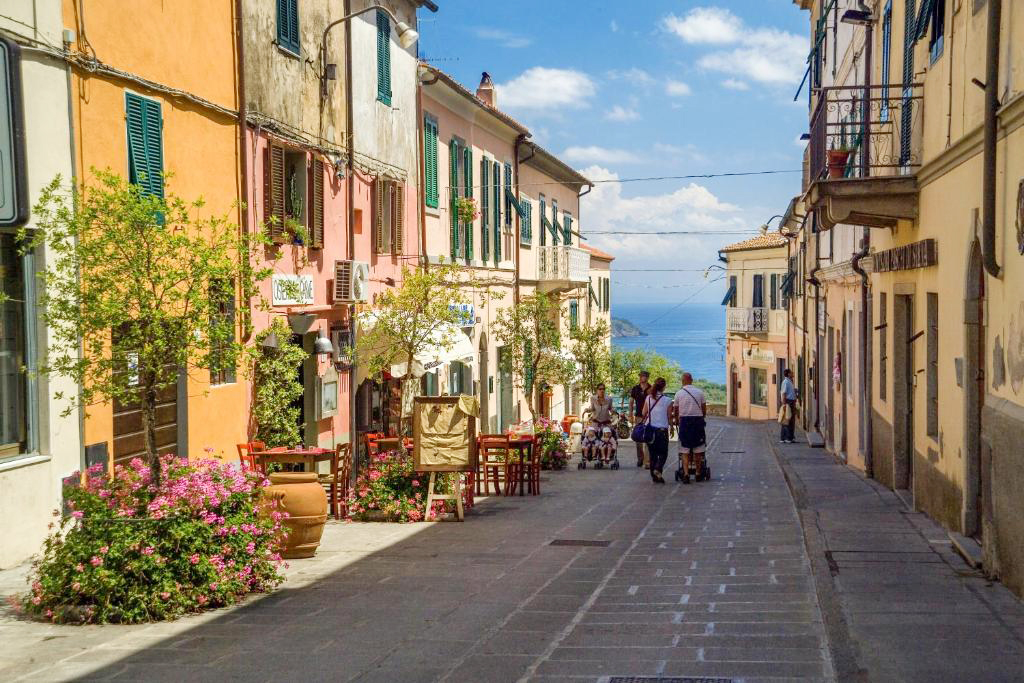
Capoliveri is a quaint, small medieval town that sits on the slope of Monte Calamita (Mount Magnet) at 167 m (550 ft) above sea level. The mines of the Mountain, which provided jobs for the local people, now attract a large number of visitors. It has a deep Etruscan and Roman heritage from which the name Capoliveri probably comes from. Caput Liberum, Capitis Ilvae, Caput Liseri or Caput Liveri have all been documented. The meaning is uncertain and could have been given in connection with either the God Liber or the God Bacchus for the wine-growing in the surrounding area. Thanks to its location, Capoliveri played an important role in the economy and politics of the island during the Middle Ages when it was fortified by the Pisans against the continuous attacks of Saracen pirates. During the Napoleonic campaign of 1799, the population of Capoliveri tenaciously resisted the French troops. This explains why in 1814, when he arrived in exile as King of Elba, Napoleon was greeted with skepticism in Capoliveri, while everyone else saluted him as a liberator. Like many other medieval towns Capoliveri is divided into four districts: il Fosso (the Ditch), la Torre (the Tower), la Fortezza (the Fortress) and il Baluardo (the Bulwark), which every October celebrate the traditional Festa dell’Uva (Grape festival), facing each other amidst different choreographies based on various themes of the grape harvest.
Porto Azzurro
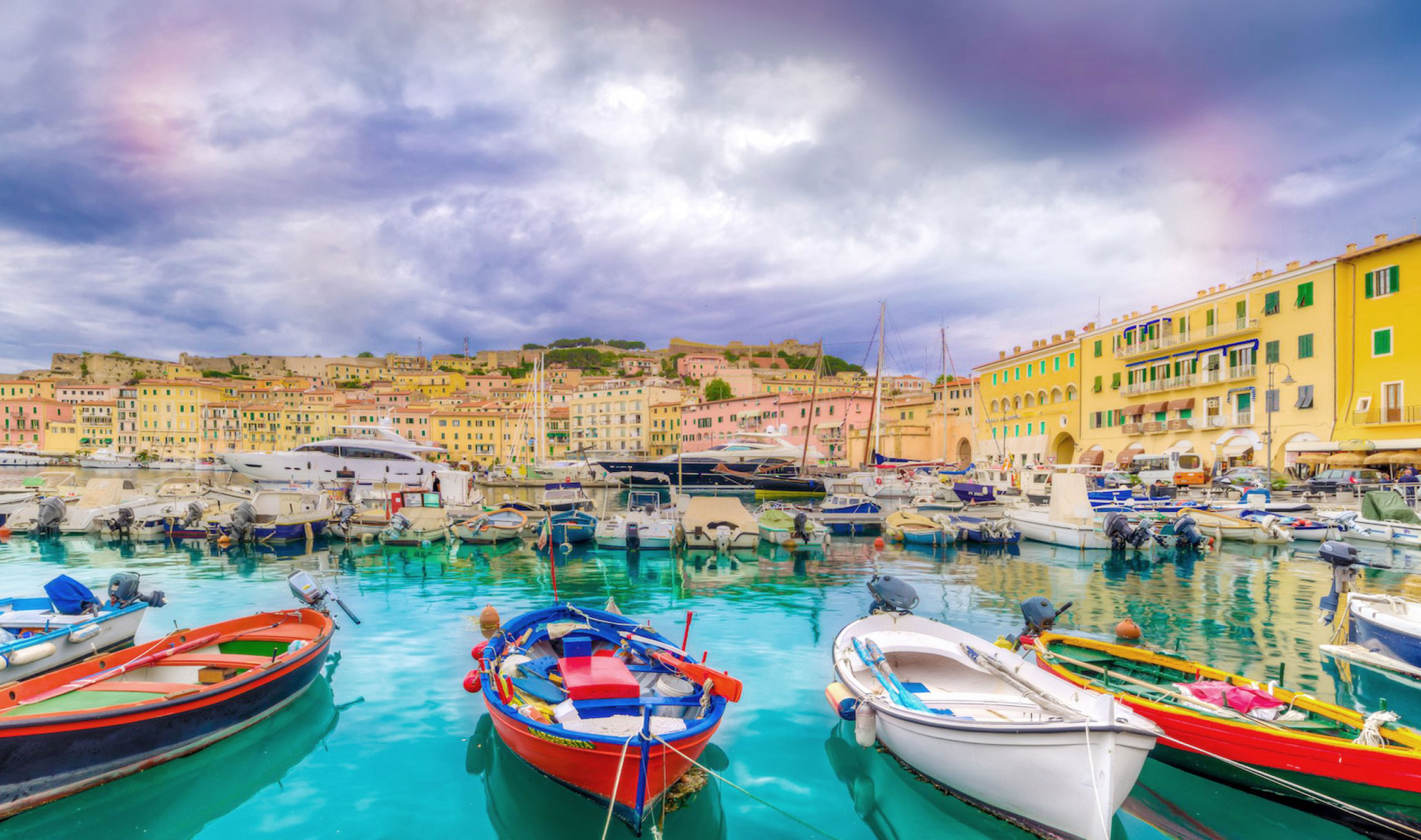
Porto Longone was founded in 1603 by King Philip III of Spain who wanted to make it into a fortified town to defend its territory. The charming seaside town grew up at the foot of the Forte di Longone, also known as Forte San Giacomo (St. James Fort), which was used as a prison at the end of the 18th century. In 1947 during the tourism boom, the name was changed to Porto Azzurro, to create a new image, away from its old associations with the penitentiary and reflecting more the surrounding landscape. Another important testimony of Spanish rule is the Sanctuary of the Madonna di Monserrato built in 1606 not far from the city and immersed in the green and fragrant nature of the island. Porto Azzurro is located on the western coast of Elba Island, has narrow streets with small houses, boutique shops, excellent restaurants and a town square in front of the marina with a tile floor design that resembles a fishing net to pay homage to the fishermen. The coastline around Porto Azzurro boasts unique beaches of natural beauty with their dramatic rock formations and white sand.
3rd Leg: Moving to Castiglione del Lago
The Land of the Etruscans
Morning
- Drive to Porteferraio to take the ferry to Piombino.
- Drive to Populonia, a medieval hamlet and once one of the twelve city-states of the Etruscan Dodecapoli and the only one facing the sea.
- Collezione Gasparri, a small Etruscan Museum which houses a collection of artifacts recovered from the archaeological excavations of the necropolis around Populonia as well as other objects found at sea.
- Torre Medievale and Rocca Degli Appiani, the fortification system built in the early 15th century by the will of the Appiani family. From the walkway of the walls and especially from the tower the panoramic views are breathtaking.
Afternoon
- Drive to Castiglione del Lago.
Welcome Aperitif.
Dinner in the historic center.
Populonia
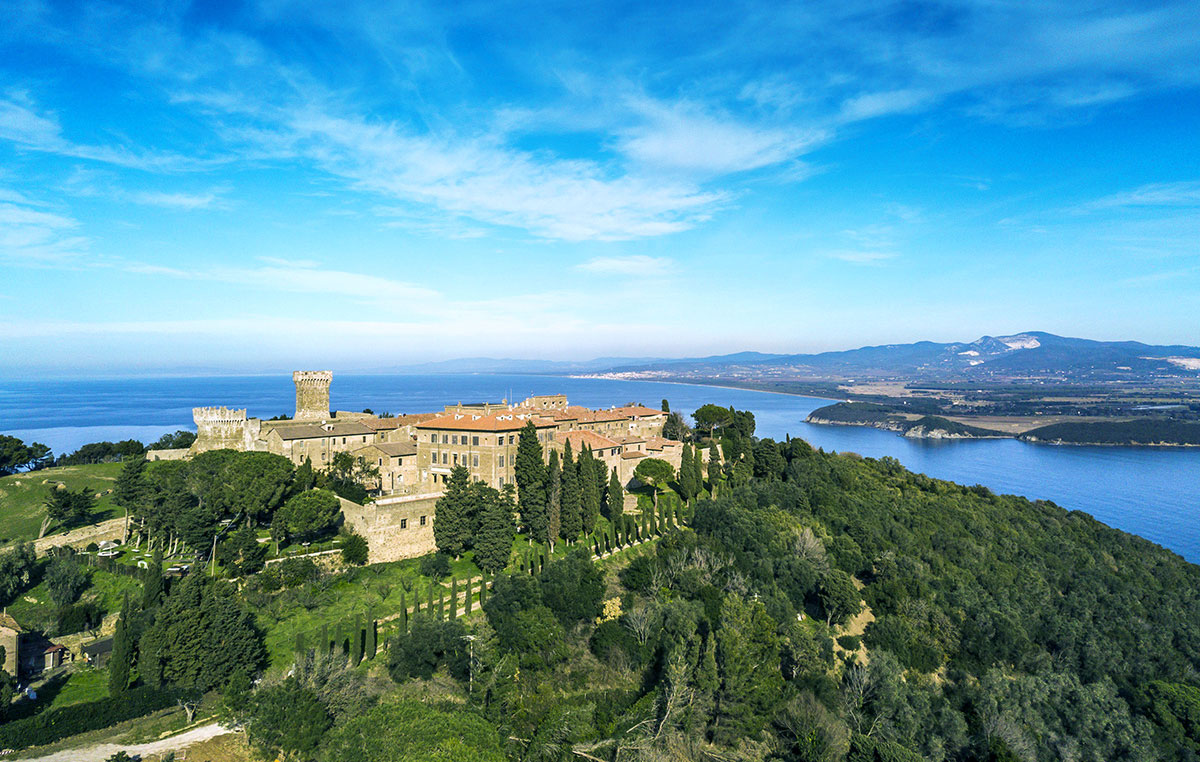
In the 7th century BC, Populonia, known as Fufluna (from Fufluns, the Etruscan god of intoxication) or Pupluna, was already one of the largest, most wealthy and prominent ancient Etruscan settlements thanks to the smelting of silver and iron ores transported from the many mines the inhabitants owned on the Island of Elba and, likewise, copper ores from their mines in the nearby Metalliferous Hills. The only Etruscan city built along the coast and one of the major mining centers of the Etruscan metal industry. Populonia attracted thousands of inhabitants, with an acropolis, a necropolis, several ports and industrial districts. Today, Populonia is a pretty little medieval village notable for its ancient ruins, the Etruscan walls, remains of Roman buildings and a a 15th century fortress, located on top of a hill surrounded by a crystal-clear sea in a dominant position, on one of the promontories that form the Gulf of Baratti.
Castiglione del Lago
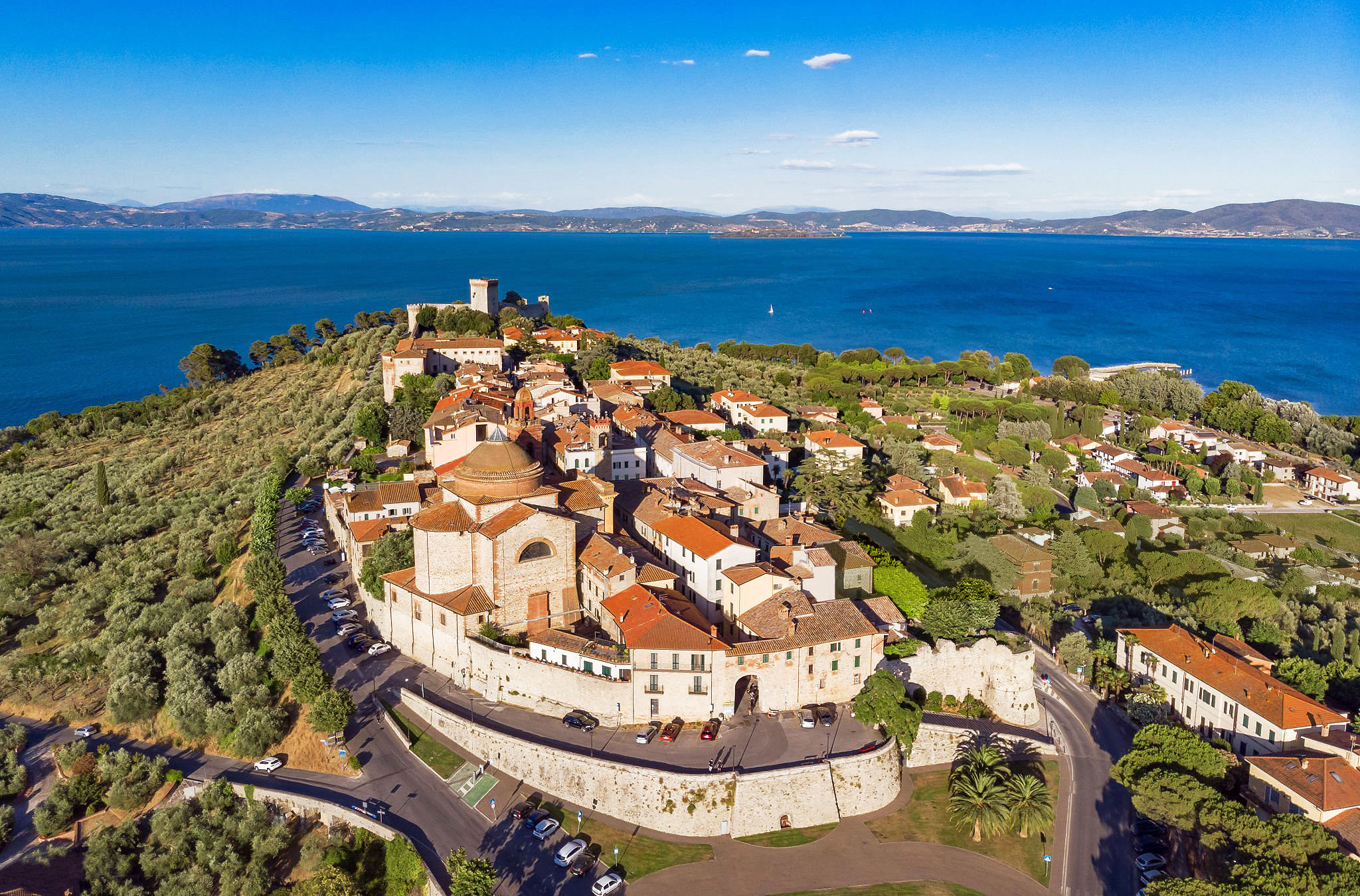
Surrounded by walls and rising on a promontory, the town is dominated by its Medieval Fortress and towering Keep. Founded by the Romans, who named it Novum Clusium, the town now stands on what, in ancient times, was the fourth island of Lake Trasimeno. The name Castiglione comes from the coat of arms of the family that once ruled the city, the Castellum Leonis (Lion’s Castle). Castiglione del Lago played an important role in the history of the region and its strategic location made it a disputed area. Struggles ensued between the Etruscans and the Romans and, during the Middle Ages since the town had a great strategic importance because it controlled the roads that went from Rome to Florence, there were also conflicts between various Tuscan and Umbrian towns that caused the destruction of the original fortifications, which have been rebuilt several times.
Lake Trasimeno
Morning
- Walk to Palazzo della Corgna also known as the Ducal Palace and also visit the Rocca del Leone, the fortress located at the end of the city overlooking the lake.
Afternoon
- Drive to Pienza, known as the “Ideal City of the Renaissance” and gastronomically renowned for the production of Pecorino cheese.
- Palazzo Piccolomini. The palace overlooks the Val d’Orcia valley, residence of the Pope and his family in past centuries.
- Museo Diocesano. The small museum housed in the Palazzo Borgia, it boasts masterpieces of the 14th century.
- Drive to Montepulciano, a beautiful Renaissance hill town in the Val di Chiana surrounded by vineyards that have made it famous for the production of wines.
- Drive back to Castiglione del Lago.
Palazzo della Corgna
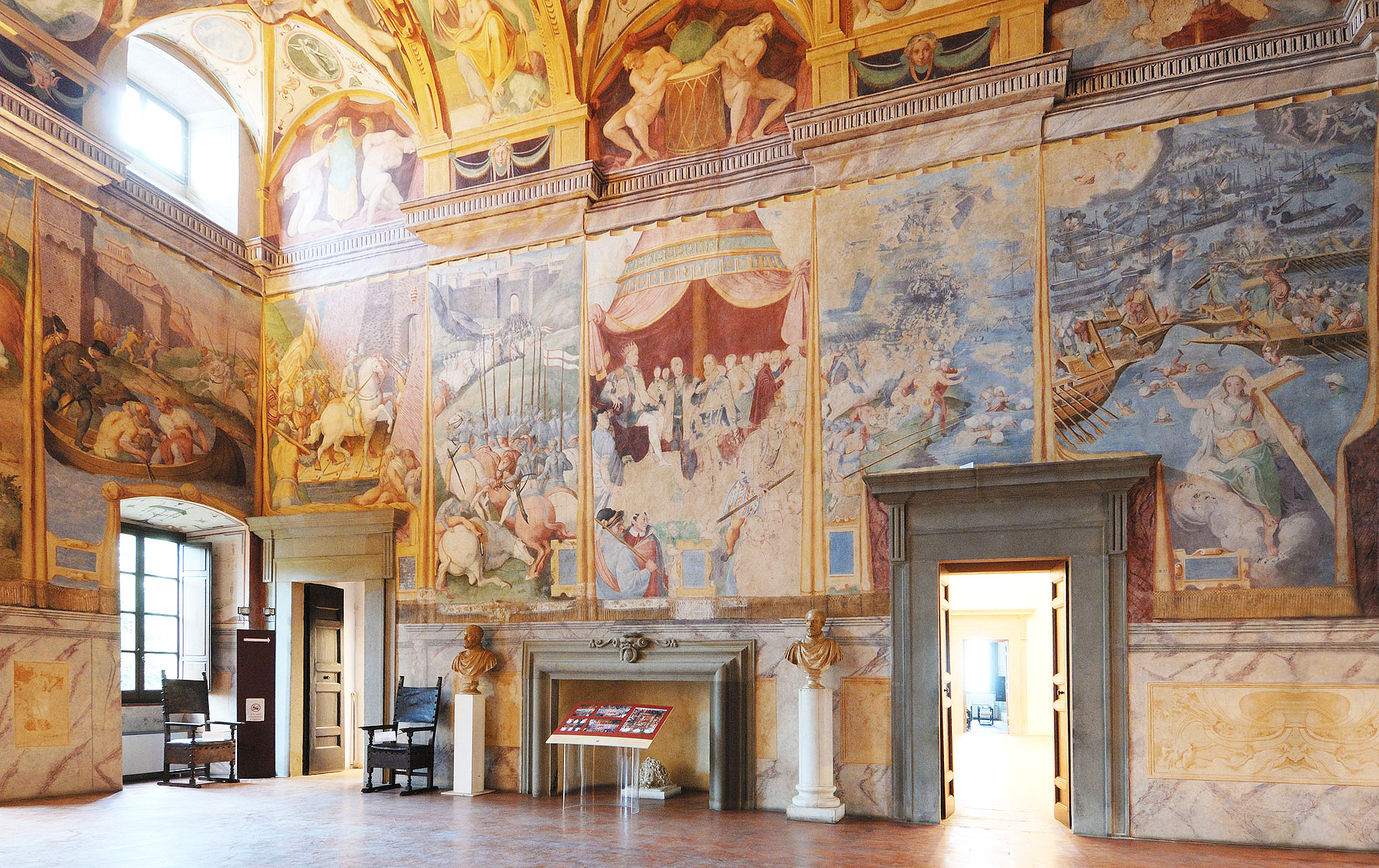
The Corgna Palace was designed as a hunting lodge in the early ‘500 and then incorporated to a new building commissioned in 1563 by the condottiero Ascanio della Corgna to serve as his noble family’s home. The palace, with its elegant luxuriant garden that surrounded it and the interiors frescoed walls and ceiling, is testimony to the social rank enjoyed by the della Corgna family in the Renaissance period. The richly decorated scenes include the deeds of Ascanio, episodes from Roman and Latin myths and historical themes like the Battle of Trasimeno. The Ducal Palace della Corgna is also famous for having hosted celebrities such as Niccolò Machiavelli and Leonardo da Vinci. The palace was recently restored and became the municipal building of the City of Castiglione and home to the museum. From the palace, via a covered walkway, it is possible to get to the medieval fortress Rocca del Leone that looks out over Lake Trasimeno.
Rocca del Leone
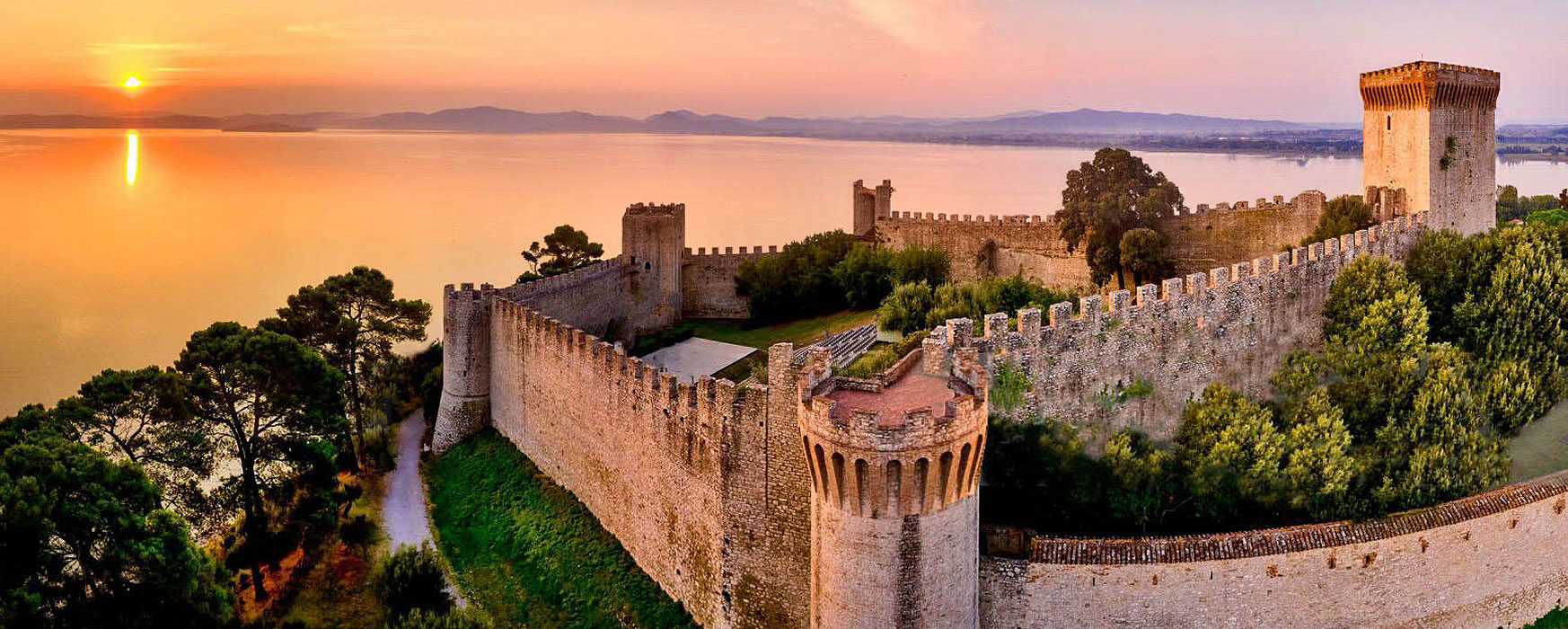
The Lion Fortress, built around 1247 on the orders of Emperor Frederick II of Swabia, sits on the remains of an Etruscan acropolis. The irregular pentagon-shaped plan is composed of a 39 m (128 ft) high triangular tower and four towers that fortify the crenelated walls; two of these, of circular shape, were built in the first half of the 16th century. Inside the Rocca are the ruins of a church of probably Byzantine origin, built on the remains of an Etruscan temple. The Rocca has been adapted as an amphitheater for cinema, musical performances and events of various kinds.
Pienza
Standing high atop a hill, dominating all the Val d’Orcia, Pienza has a fairly recent history closely linked to its founder: Pope Pius II, born Enea Silvio Piccolomini. In fact, until 1462, the town was nothing more than a small fortified village called Corsignano that Pius II decided to rebuild, transforming the place that had given him birth into a city whose name recalled his papacy. Piccolomini did not want just any city but a strongly worthy urban center and in antithesis with Siena, the city which had sent his family into exile during a civil war between supporters of the emperor and those of the Pope. Thus it was that, thanks also to the support of wealthy families including the Borgias, in just three years (1459 - 1462) Pienza was born, the City of Authors, the Ideal City, the Utopian City. During these years, several splendid and harmonious buildings were completed around the central square; the Piccolomini Palace, the Cathedral, the Town Hall and the Borgia Palace. Pienza is considered a turning point for the history of architecture and who knows what Pienza would have become if the Pope hadn’t prematurely died on the eve of a Crusade on August 14, 1464.
Montepulciano
Montepulciano has a long and ancient history that begins in the 4th century BC, reaching its cultural and economic splendor in the 16th century. Montepulciano is known throughout the world for its magnificent Vino Nobile di Montepulciano DOCG, one of the best wines in the world, the result of centuries of viticulture dating back to Etruscan times. From the historic center of the city, which still adheres to its medieval plan, filled with splendid Renaissance palaces, churches, monuments, charming squares and hidden corners, you can admire the impressive vineyards of the surrounding valleys that remind us of its agricultural importance. The Torre di Pulcinella is a clock tower topped by a figure of the Pulcinella, a commedia dell’arte character. The heart of Montepulciano is Piazza Grande and the setting for its main events, including the barrel-racing Bravio delle Botti contest held in August every year since 1974, replacing an equivalent horserace dating back to 1373. Teams of two spingitori (pushers/runners) representing the eight contrade (town’s districts) compete to be the first to roll an 80 kg wine barrel through the streets of the historic center for approximately 1.8 km (1.1 mi) mostly uphill. Due to the narrow streets and the barrels' shape and size, collisions between teams are frequent. The word bravio derives from the latin Bravium meaning victory prize, which in this case is a painted cloth bearing the image of the patron saint of the city.
The Two Wonders
Morning
- Drive to Bagnoregio.
- Walk to Civita, the citadel suspended in time and space, a magical and surreal place, located on top of a hill, that has been nick-named “the town that is dying”, due to the constant erosion of the tuff rock.
Afternoon
- Drive to Orvieto.
- Duomo. The Orvieto Cathedral, one of the greatest artistic achievements of the Italian late Middle Ages, constitutes a unicum that escapes any simplistic classification of style.
- Torre del Moro. Climb the long-standing clock tower to reach the balcony and enjoy panoramic views of Orvieto and the surrounding countryside.
- Pozzo di San Patrizio (Saint Patrick’s Well) which, with its 53 m (174 ft) depth and 248 steps, impresses modern engineers to this day.
- Orvieto Sotterranea, the underground city with 1,200 caves, tunnels & wells carved into the rock 2.5 to 3 millennia ago.
Civita di Bagnoregio
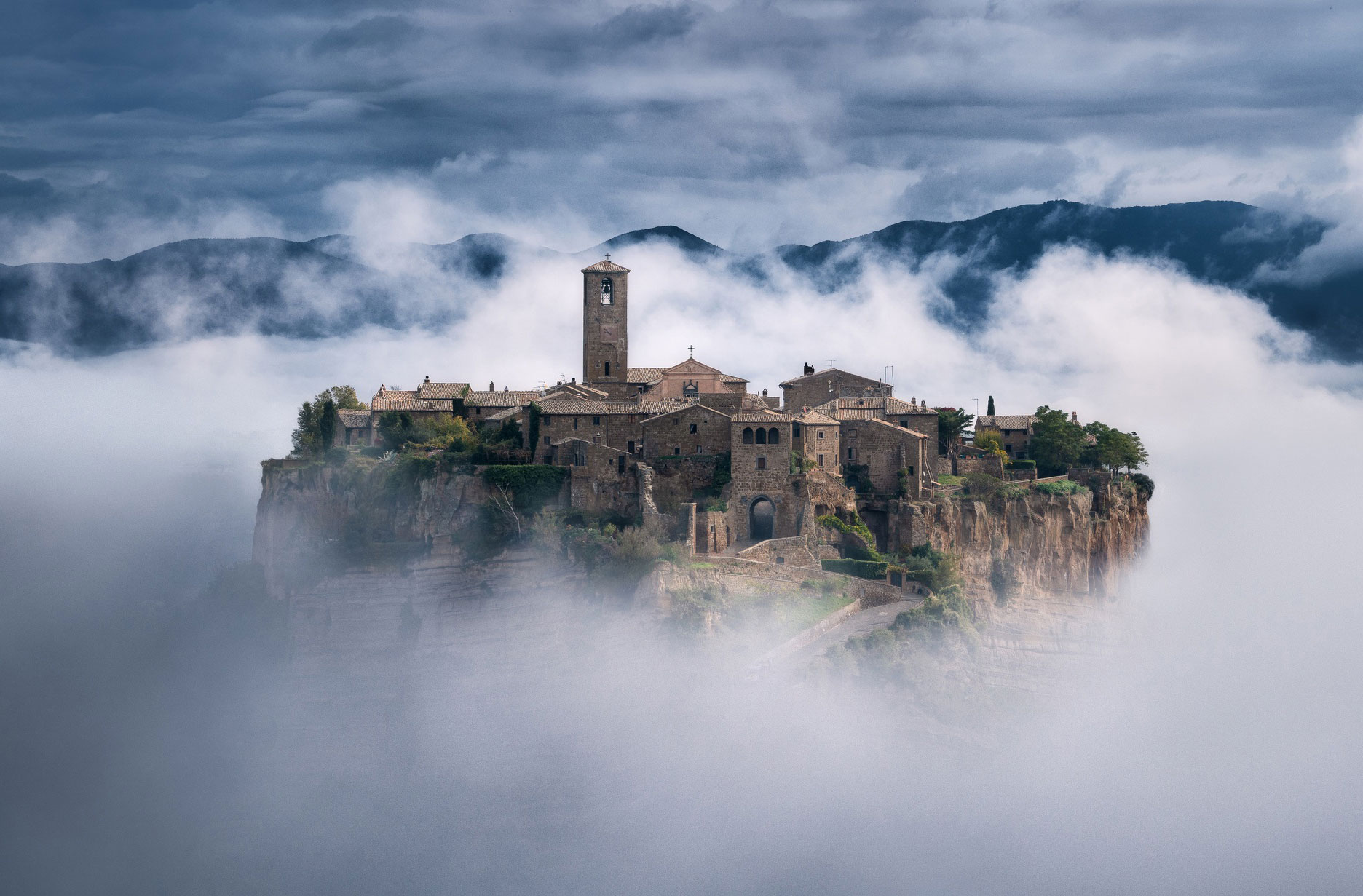
Civita di Bagnoregio is a medieval village founded by the Etruscans more than 2,500 years ago. It is situated atop a huge stack of slowly crumbling tuff rock. At the end of the 17th century it was part of the Papal States but started declining in the 19th century when the town was turning into an island due to fast erosion caused by the streams, atmospheric agents and deforestation. Civita di Bagnoregio owes much of its unaltered condition to its relative isolation. The territory is made up of two different formations of rocks, different in chronology and constitution. The base layer is that of clay which is particularly subject to erosion. The top layers are made up of tuff and lava material. Inhabited by only a dozen people, Civita can be reached only via a reinforced concrete pedestrian bridge built in 1965.
Orvieto
Orvieto is a small city perched on the flat summit of a large butte of volcanic tuff. It rises dramatically 150 m high (almost 500 ft) with defensive walls built of the same stone. The origins of Orvieto date back to the 9th century BC. as evidenced by the traces found of the Villanovan community (early Iron Age), the ancestors of the Etruscans. Today in the underground city it is still possible to see an intricate network of caves, grottoes and numerous wells that date back to Etruscan times. With the arrival of the Romans, Urbs Vetus (old city), which is the origin of the current name of Orvieto, was annexed to the Empire in the 3rd century BC. With the fall of the Roman Empire began a turbulent period characterized first by the arrival of the barbarians and then by the invasion of the Lombards. The Middle Ages mark an important moment for the city, a period of great wealth, beauty and expansion, which reached its peak between the 13th and 14th centuries and its very particular urban structure has remained substantially unchanged since then. Once again, as often happens in Italian cities, including Orvieto, the greatest expression of the art of this period and of the Renaissance is its marvelous cathedral. Its imposing size can be enjoyed from the terrace at the top of the Torre del Moro.
Cattedrale di Santa Maria Assunta
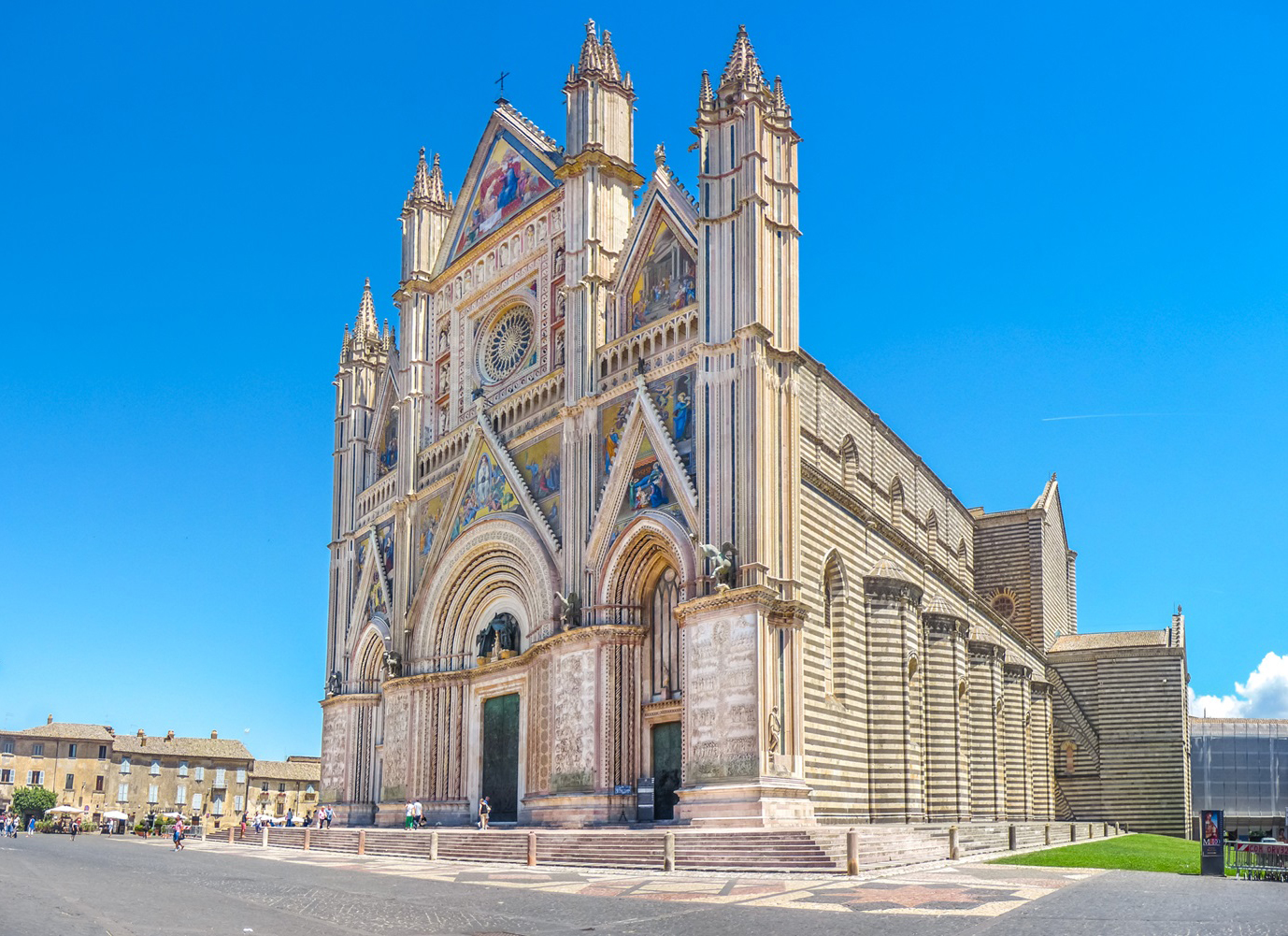
The Gothic Cathedral is one of the most famous in Italy. Construction of the cathedral began in 1290, initially using a design by the architect of the Florence Cathedral, and lasted for nearly three centuries, with the design and style evolving from Romanesque to Gothic. The façade, in richly polychrome sculpted marble, bas-relief decorations and statues, is one of the great masterpieces of the Late Middle Ages. The painters Fra Angelico and Benozzo Gozzoli decorated sections of the vault in the Chapel of the Madonna di San Brizio, a 15th century addition to the cathedral, while the decoration of the rest of the vault and of the lunettes is by Luca Signorelli, completed in 1503. These frescoes, on the Apocalypse and the Last Judgment, are considered Signorelli’s most complex and impressive work.
The Island in the Middle of the Lake
Morning
- Drive to Passignano sul Trasimeno to take a ferry to Isola Maggiore.
- Stroll the main street to arrive at the Pieve di San Michele Arcangelo abbey on the top of the hill with a 180 degree view of the lake.
Afternoon
- Ferry back to Passignano sul Trasimeno.
- Drive to Perugia for a unique multi-sensory and cultural experience: rich variety of museums, a pristine medieval center, artistic craft workshops and delicatessens from its typical cuisine.
- Walk in the historic center through its narrow streets discovering its beauties, enjoying the views from Porta Sole and stroll on what once was the Medieval aqueduct.
- Palazzo dei Priori, a medieval palace housing the National Gallery of Umbria.
- Casa del Cioccolato Perugina. Visit the home of the Chocolate and historic Museum of Perugina, worldwide known for the irresistible Baci.
Isola Maggiore
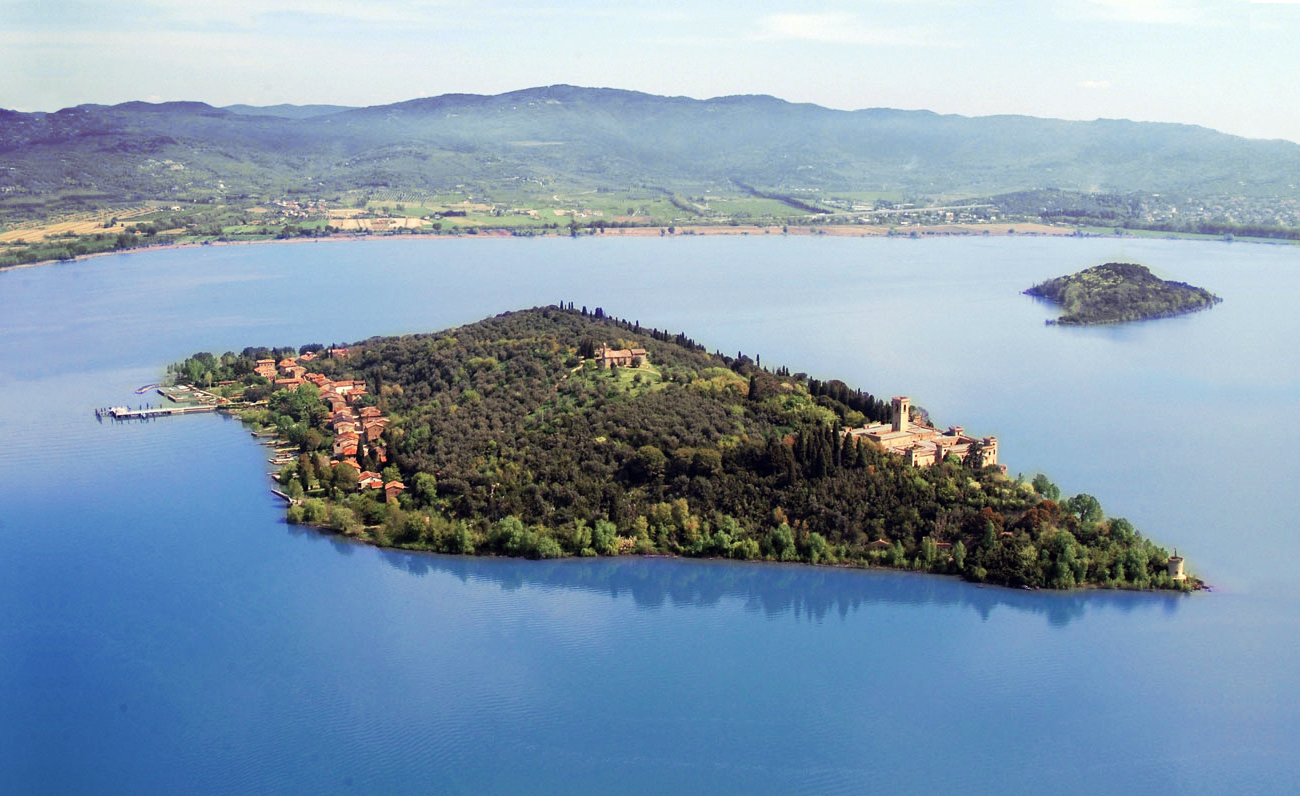
Isola Maggiore is the second largest of the three natural islands of Lake Trasimeno in Umbria. The island saw its heyday during the 14th century when a Franciscan monastery was established but its population has declined since then; the island now has less than 20 inhabitants. For centuries fishing was the town’s main source of livelihood but now tourism provides its main income. The island is famous for its pizzo d'Irlanda, a special type of lace-making. This activity dates back to 1904, when a teacher from Ireland taught crochet techniques to the women on the island. Today, there are very few lacemakers but a museum has been opened to preserve this tradition.
Perugia
Capital of the Umbria region, Perugia boasts a thriving international student scene thanks to its two universities – the University of Perugia founded in 1308 and the University for Foreigners, the oldest of its kind in Italy – and is famous for its international events such as Umbria Jazz, which attracts tourists from all over the world. Encircled by Etruscan walls, the city has preserved its medieval churches, winding cobblestone streets, and an impressive Renaissance and Baroque architecture. Perugia was the hub of the great Renaissance Umbrian school of painting, which reached its height in the 15th century. In the center of the city the magnificent Piazza Quattro Novembre, a former Roman forum, contains the gothic Palazzo dei Priori (1293–1297) housing the National Gallery of Umbria’s remarkable collection of paintings and sculpture; the cathedral of San Lorenzo (1345–1430) and the splendid Fontana Maggiore, built between 1275 and 1278 by Nicola and Giovanni Pisano, a precious symbol of a lively and magnificent medieval Perugia. Other landmarks include the Rocca Paolina, a fortress symbol of papal authority (XVI century), and the Collegio del Cambio (1452–57), with frescoes by Pietro Perugino. Particularly notable among the many fine churches are San Angelo (5th and 6th centuries; on a circular plan); San Domenico (1305; rebuilt 1632) and San Severo, with a fresco by Raphael. The Perugia Aqueduct is one of the most particular attractions of the town. It is a rather complex hydraulic engineering work - started in Roman times and finished in the Middle Ages - because it transported water to a city full of gradients without using any pump. Decommissioned in the mid-1800s, today it offers one of the most beautiful and picturesque promenades in Italy.
3rd Leg: Moving to Cortona
Under the Tuscan Sun
Morning
- Drive to Cortona, well known nowadays as the setting for the book and movie Under the Tuscan Sun.
- Walk through the historic center to reach Piazza Garibaldi to enjoy the panorama.
- Museo Diocesano, an art museum located in the former Church of Jesus.
Afternoon
- Free time or optional activities:
- MAEC, an Etruscan museum.
- Drive to Le Celle, one of the most stunning venues for a Franciscan monastery.
- Walk to Fortezza del Girifalco, the Medicean fortress located on the hilltop overlooking Cortona.
Dinner nearby the hotel.
Cortona
Located on the border with the Umbria region, perched on a hillside overlooking the Valdichiana, Cortona is a well-preserved, unspoiled medieval town, a strategic point and a convenient base for exploring the surrounding areas. Cortona’s rich history is evident in its narrow streets, hidden stone staircases, palazzos and piazzas. For four centuries it was an important Etruscan magisterial center when the imposing walls that surround the city for about 3 km (1.86 mi) were built, of which some remains are incorporated in the medieval walls. In 310 BC Cortona became a Roman colony under the name Corito. During the Second Punic War, Hannibal besieged and attacked the city, and in the famous battle of Trasimeno Lake he ambushed and killed about fifteen thousand Romans. In the 16th century, during the Florentine Renaissance, under Cosimo I de’ Medici the town flourished, becoming a medieval jewel. Cortona’s many points of interest include its distinctive 16th century clock tower located in the central square, the Palazzo Casali, the neoclassical Signorelli theater, the Etruscan Museum, the Diocesan Museum, the Girifalco Fortress, and the wonderful views over the valley.
Eremo le Celle
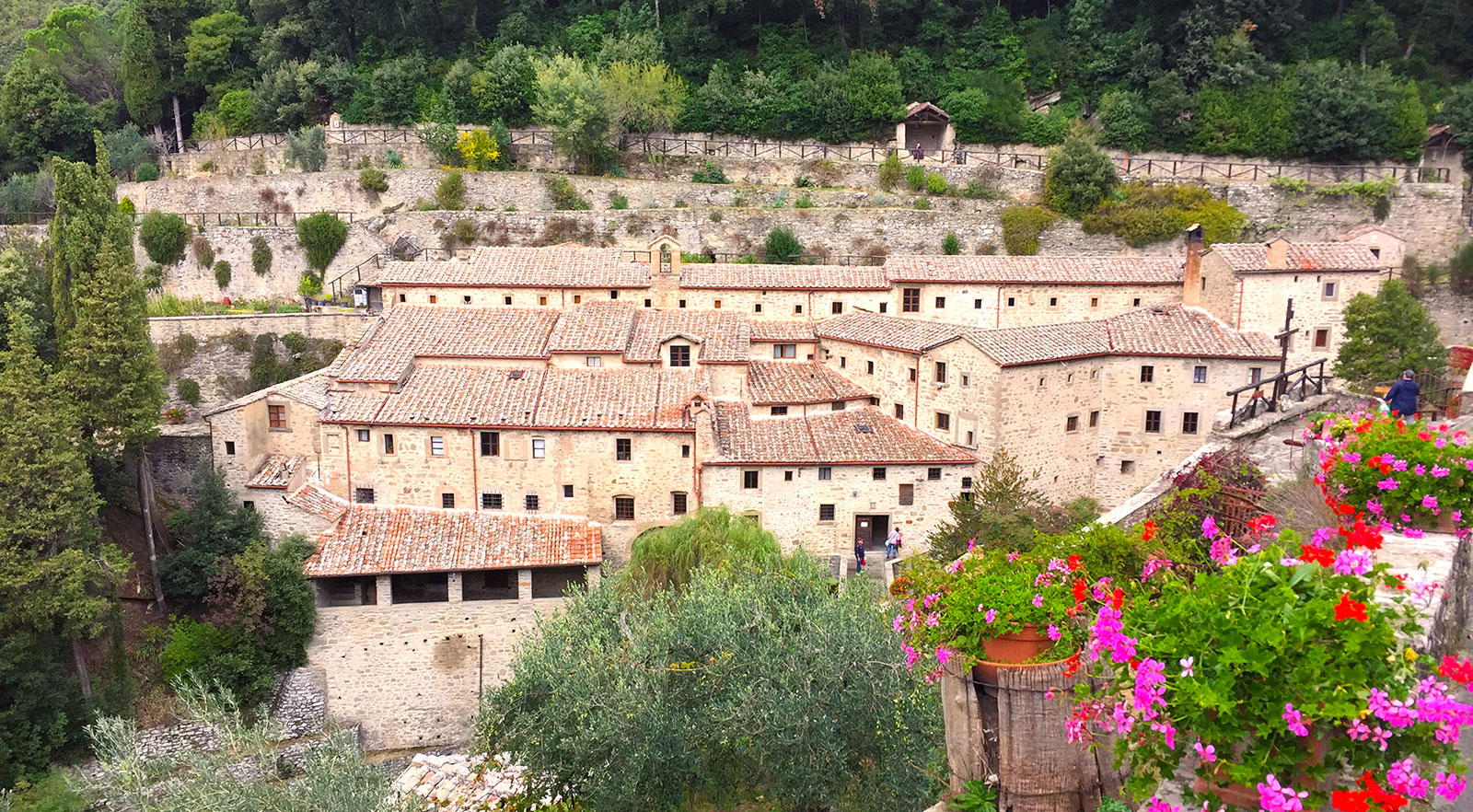
The hermitage Le Celle is a Franciscan monastery founded by Saint Francis in 1211. Located in an enchanting valley where nature and man have lived harmoniously for the past centuries, this place has a special effect on visitors. After entering the monastery, many feel transported and surprised by the tranquil silence, interrupted only by the singing of birds and water flowing, that invites them to listen and look inside themselves. Some meditate, some pray, some feel closer to Nature, but everybody finds the Eremo to be a truly spiritual place.
Museo Diocesano
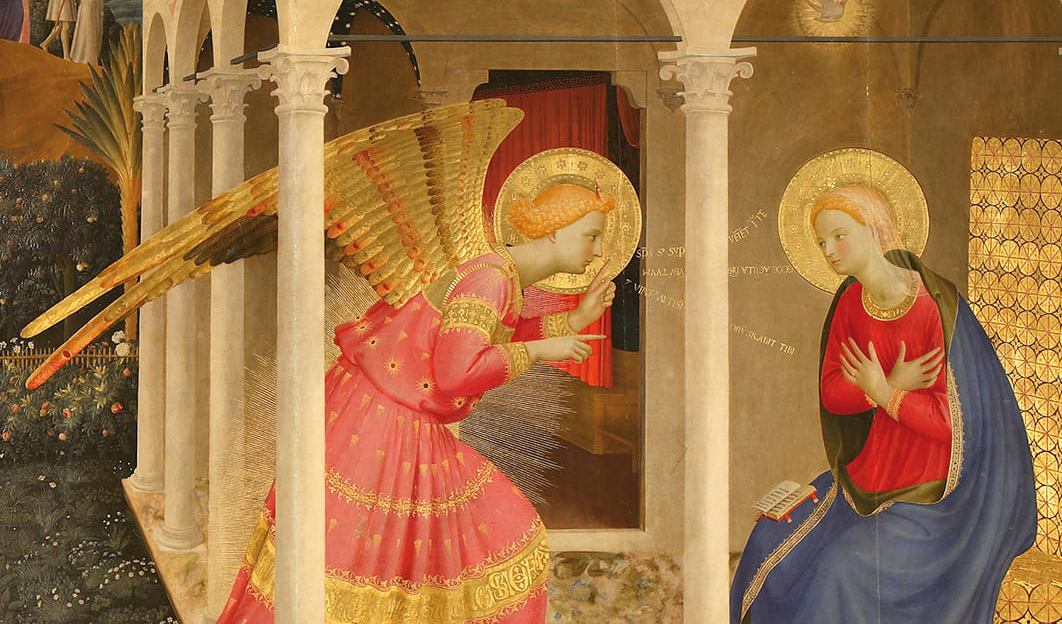
The Diocesan Museum houses valuable works of religious art gathered from the important churches of Cortona and its surroundings. The museum collection also includes a Roman sarcophagus, some extraordinary and rare pieces from the 14th century Church of Santa Margherita, and in the main room, two exquisite masterpieces of the 15th century, the famous Annunciation and a triptych painted by Fra Angelico.
MAEC
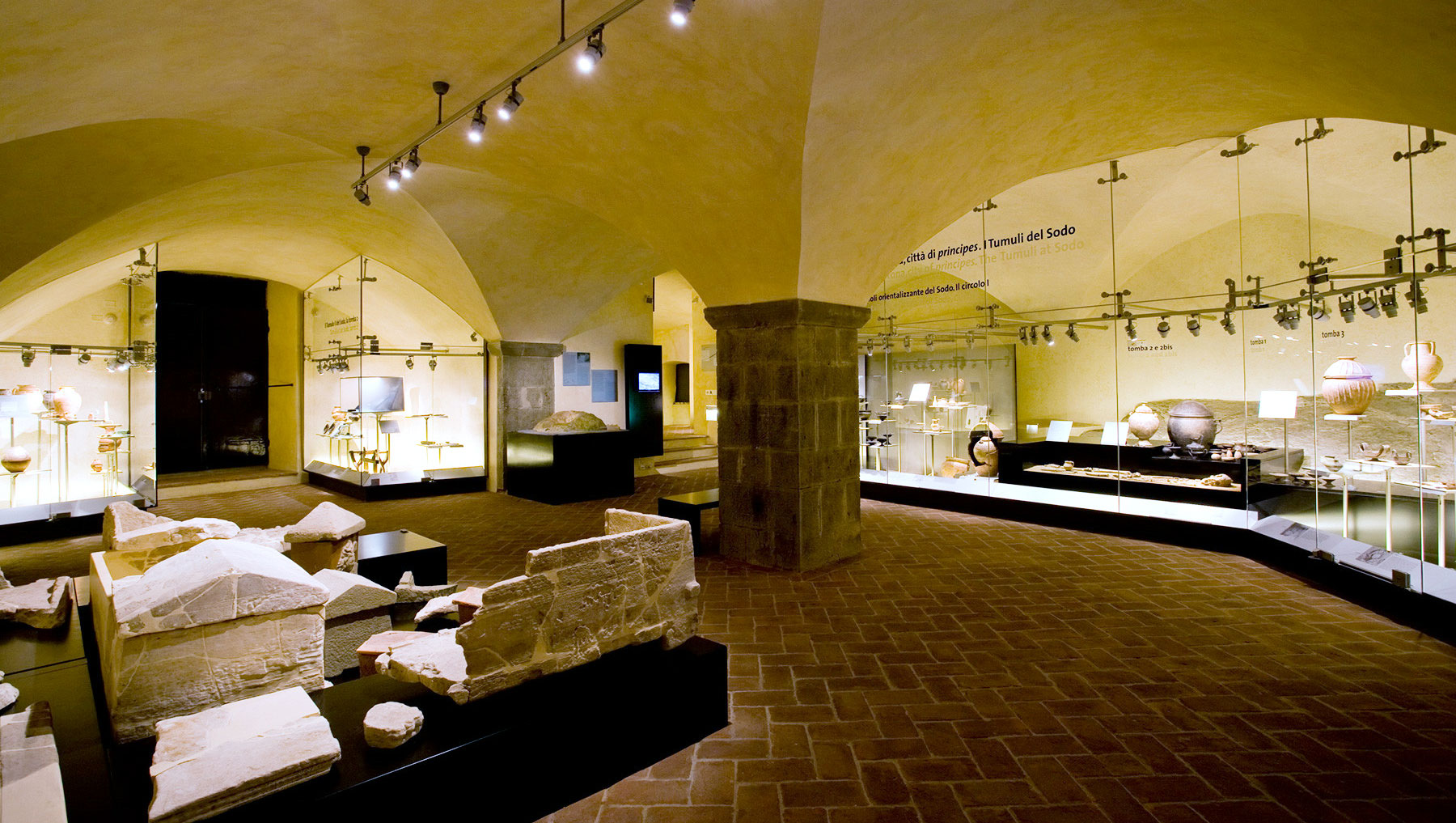
The MAEC (Museum of the Etruscan Academy and of the City of Cortona) preserves some of Cortona’s ancient history, from its evolution during the Prehistoric and Protohistoric Ages through the Etruscan and Roman periods, including the famous and rare Etruscan Bronze Chandelier, and the Tabula Cortonensis, the third longest inscription found in the Etruscan language. The museum also features several paintings by Tuscan artists from the 13th to the 19th century.
Fortezza del Girifalco

The Girifalco Fortress, standing already in 1258 AD, was sacked several times until sold, with the entire city of Cortona, to the Florentine Republic in 1411 but reconstruction work only began in 1527. In the 17th century it took on its present appearance. Used as a town prison in the 18th century and, during WWII, as the home of children whose parents were exiled. Today the Fortress is used for cultural events and provides one of the best sites to take in the views of the valley.
The “City of Stone”, Gubbio
Morning
- Drive to Gubbio, a medieval marvel.
- Teatro Romano and the Antiquarium, a structure built on the remains of a Roman house, is an archeological museum that houses artifacts uncovered here and throughout the area and also some well preserved mosaics.
- Palazzo dei Consoli and Piazza Grande, which together with the surrounding architectural ensemble inaugurated a new style that would only blossom in full a century later in Florence during the Renaissance.
Afternoon
- Free time or optional activities:
- Explore in depth the historic center.
- Cabinovia ride to the top of Monte Ingino for a panoramic view of the city and a short walk to the Basilica of Sant’Ubaldo.
- Back to Cortona.
Gubbio
The origins of the city of Gubbio are lost in remote times. Its roots lie in the ancient Umbrian civilization, evidenced by the Eugubine Tablets, written in the Umbrian language and dating back to the 4th century BC. Founded in the 3rd century BC as Tota Ikuvina, Gubbio assumed greater prominence in the 1st century AD as the Roman town Iguvium. Turbulent years began with the fall of the Roman Empire, first with the sack of the Goths in 552, then with the arrival of the Byzantines 40 years later, until the Lombard invasion 200 years later. The 12th century is one of its richest periods until the end of the 14th century, after which Gubbio entered a long period of slow decline, ending only with the unification of Italy in 1860. Gubbio has a busy calendar of events during the year, such as the Middle Ages Festival, the Truffle Exhibition and the setting up of the largest Christmas tree in the world. But the most important is the race of the Ceri (candles), one of the oldest folklore events in Italy that takes place every year since the 12th century. The 3 Ceri are represented by three gigantic wooden structures surmounted respectively by the statues of the 3 patron saints. Fixed on stretchers, the candles are carried on the shoulders of the ceraioli, who, running through the streets of the city, reach the Basilica of Sant’Ubaldo at the top of Mount Ingino. Since 1973 the candles have become the symbol of the Umbria Region.
Teatro Romano
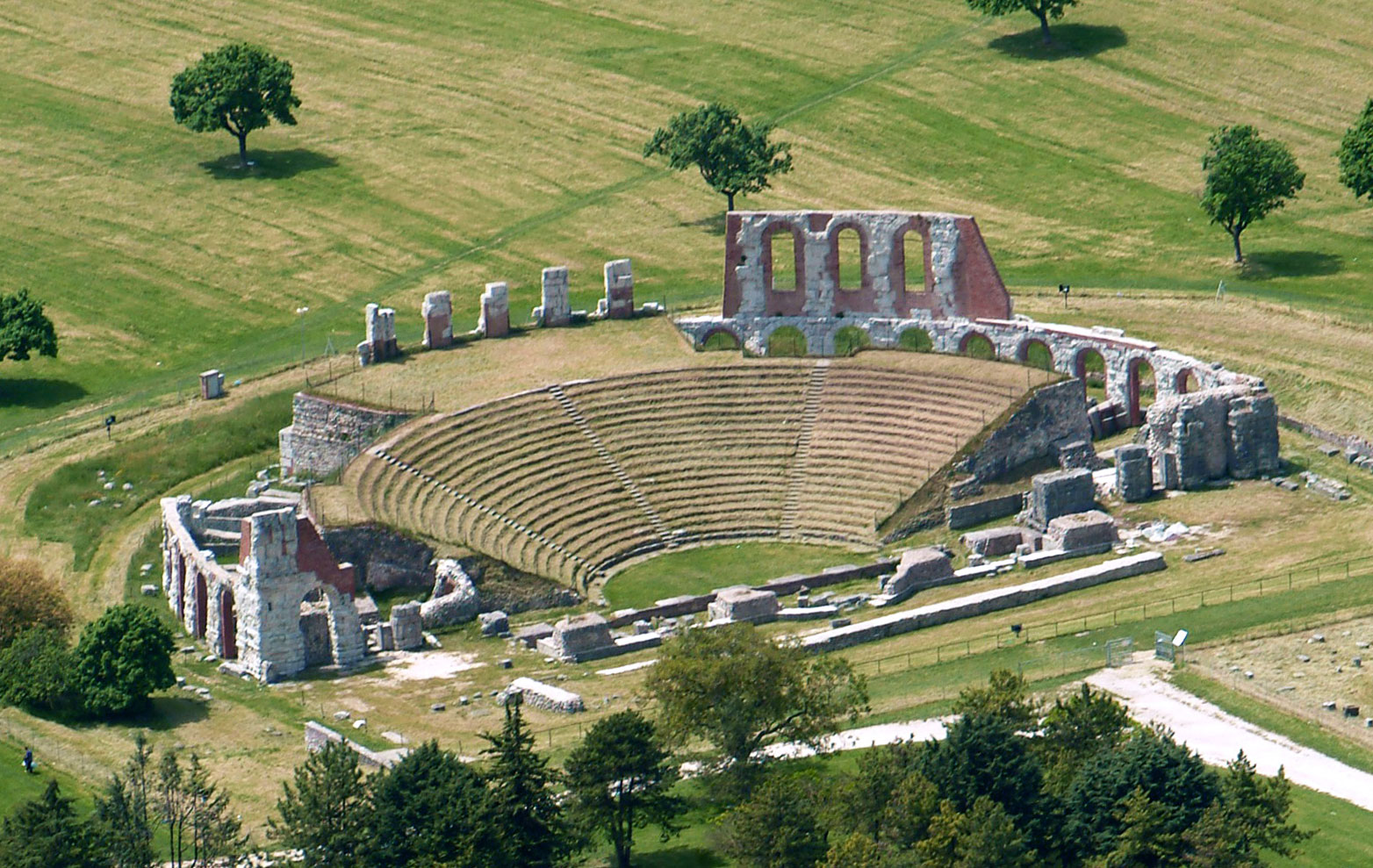
The 1st century Roman theater is one of the earliest theaters built entirely upon two-story hollow substructures. Originally it had an orchestra pit separated from the proscenium (stage) by a tall podium. The theater could accommodate nearly 6,000 spectators. Over the centuries it has had different uses, as a fortress during the Middle Age, as a place of monastic life in 1225, as material for construction, stones were reused either for the town walls, for churches, or the palaces of noble families. In the 19th and 20th centuries more excavations and restorations were carried out, thanks to which the ancient architecture that we can admire today was recovered. Today, during the summer, the theater is used for some outdoor performances.
Palazzo dei Consoli & Piazza Grande
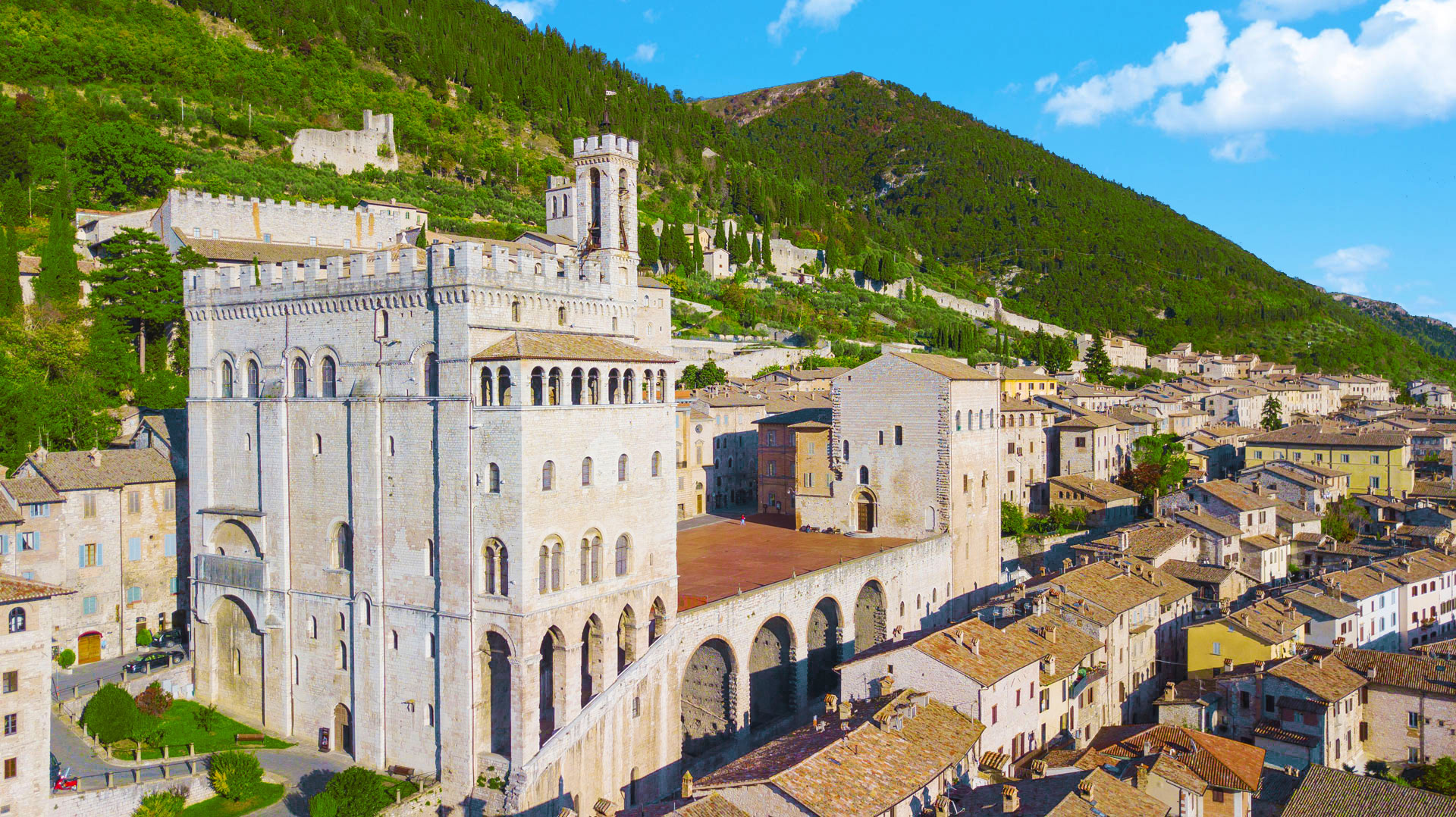
The rectangular castle, part of the Ducal Palace, was originally completed as a defensive structure in 1406 and was later transformed into a Renaissance residential palace in 1459 at the request of Francesco I Gonzaga. It was erected to defend the city, with 4 corner towers and is surrounded by a moat crossed by 3 drawbridges. It is now one of the most representative examples of late medieval military architecture in Italy. The castle was the residence of Isabella d’Este, wife of Francesco II Gonzaga, one of the most influential noblewomen during the Renaissance. She invited numerous artists and humanists of the time to the castle, among them Leonardo da Vinci, the painter Andrea Mantegna and the poet Ludovico Ariosto. Inside the castle there are many beautifully decorated halls, like Sala dei Soli (Hall of the Suns), decorated with 15th century frescoes, Sala delle Sigle, Isabella d’Este’s bridal chamber, Sala dello Zodiaco (Hall of the Zodiac), and Camera degli Sposi (Bridal chamber), with frescoes by Andrea Mantegna.
Saint Francis Homeland
Morning
- Drive to Santa Maria degli Angeli, to visit the Porziuncola, the small chapel where Saint Francis lived and where he began the Franciscan Order.
- Museo della Porziuncola, with the Conventino Medievale (Small Medieval Convent) with remains of the friars’ ancient cells.
- Cappella delle Rose (Rose Chapel) and the Thornless Rose Garden.
- Drive to Assisi, best known as the birthplace of Saint Francis.
- Basilica di San Francesco, one of the most important sites of Christian pilgrimage and a fine example of the outstanding development of Italian art during its time.
- Walk along Saint Francis Avenue and explore the historic center.
Afternoon
- Drive to Eremo delle Carceri, the hermitage where Saint Francis would often go to pray and contemplate, as did other hermits before him.
- Drive to Spello, a picturesque town, also known as the “Village of Flowers” which during Spring adorn the alleys, walls and balconies of the houses with bright colors.
Porziuncola
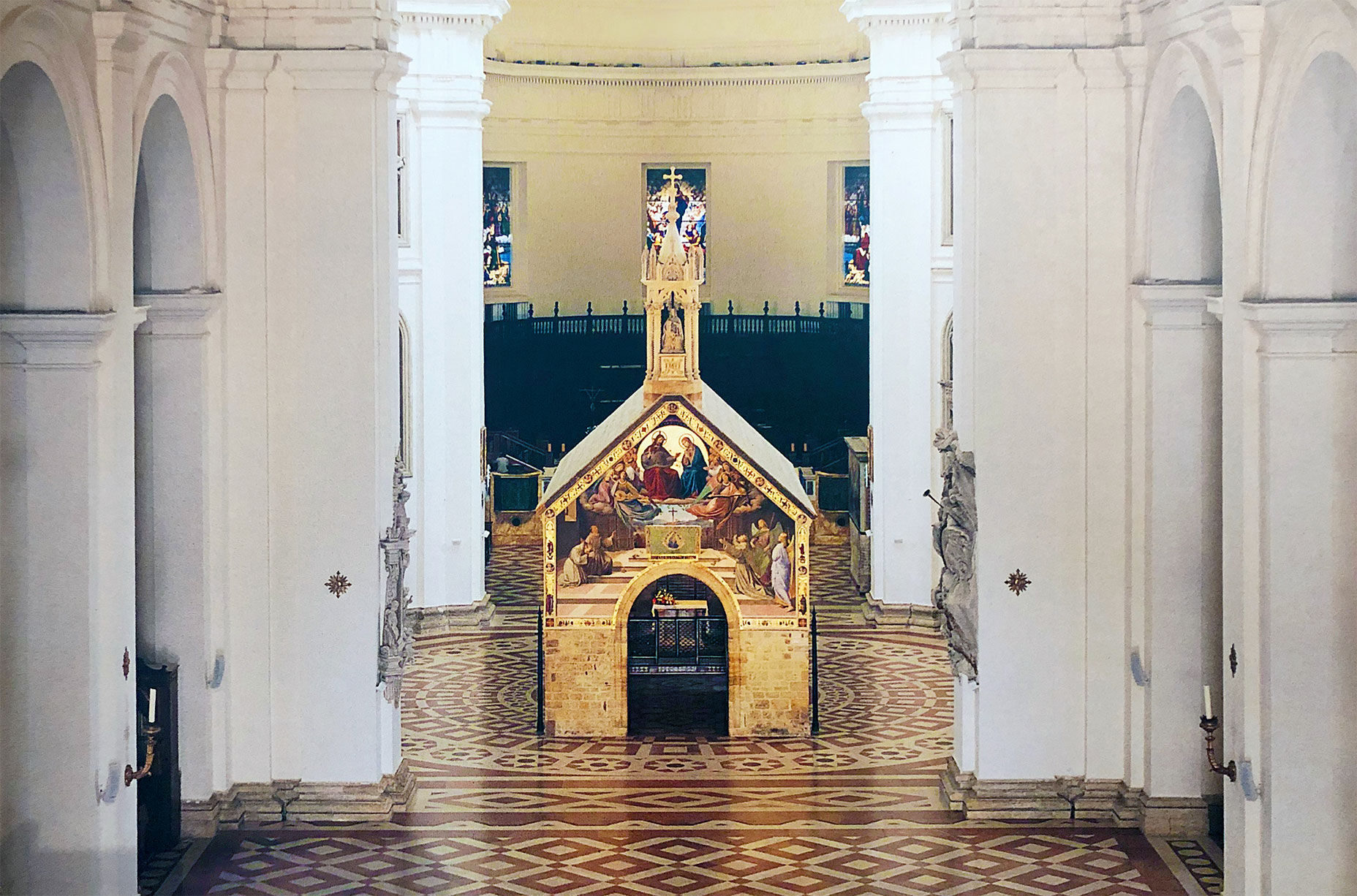
The Porziuncola (literally: small part), the small chapel inside the 17th century Papal Basilica of Santa Maria degli Angeli, around 1200, was just a dilapidated ruin that Francis wanted to restore and make his home, while today it is the Nazareth of Franciscanism. Here, in 1209 he founded the Order of Friars Minor, entrusting it to the protection of the Virgin Mary, to whom the church is dedicated. Seven years later, in a vision, Francis obtains from Jesus himself the indulgence known as the "Pardon of Assisi", approved by Pope Honorius III, which was a plenary indulgence to be granted to all those who had confessed their sins and visited the chapel. This event is illustrated in the panel by priest Ilario da Viterbo (1393), preserved in the small apse of the Porziuncola. The chapel, destination of millions of pilgrims every year, blends the Franciscan austerity of the architecture with the joyful spirituality of the Saint. Inside the Basilica there is also the Transit chapel, a simple stone room where Francis spent the last days of his life. He died there on the evening of October 3rd, 1226 at the age of 44.
Assisi
The first inhabitants in the area of Assisi were the Umbrians around 1000 BC, who lived in small fortified settlements on the hills and the forests of Monte Subasio. From 450 BC the Etruscans gradually settled in these areas until the arrival of the Romans who gave birth to the city of Assisium. Left from the roman era are the city walls, the forum, now Piazza del Comune, an amphitheater and the Temple of Minerva, now the Church of Santa Maria sopra Minerva. In 1997, the remains of a Roman villa were discovered containing several well-preserved rooms with frescoes and mosaics in a condition rarely found outside sites such as Pompei. In the early Middle Ages, Assisi was subject to the dukes of Spoleto until it became an independent community in the 12th century. During this period it was involved in internal disputes and wars with Perugia before passing to the Papal States in the 16th century. It became part of the Italian kingdom in 1860. Assisi was also pivotal in the development of the Italian Renaissance.
Basilica di San Francesco
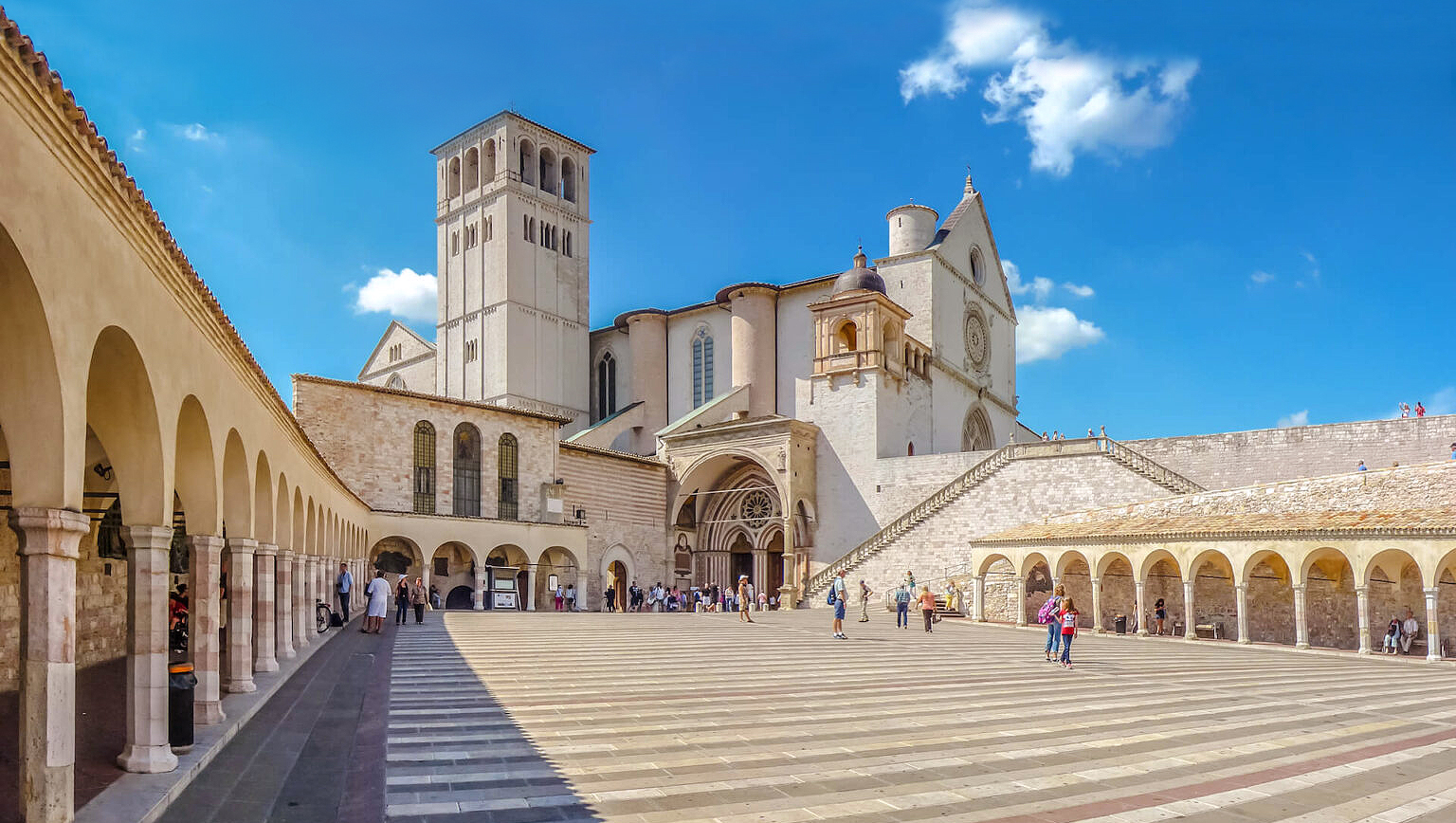
The city’s most notable landmark is the Basilica of Saint Francis. Its construction began in 1228, just two years after the saint’s death, and was completed in 1253. The two-story basilica consists of the upper church and the lower one that contains the crypt where St. Francis is buried. The basilica is one of the largest repositories of early Renaissance frescoes in Italy. The upper church has frescoes depicting episodes from the life of Saint Francis by Giotto, and other frescoes depicting scenes from the Old and New Testaments by Cimabue and Jacopo Torriti. The earthquake of September 26, 1997 severely damaged the basilica, collapsing several vaults of the upper church and destroying frescoes by Cimabue and others.
Eremo delle Carceri
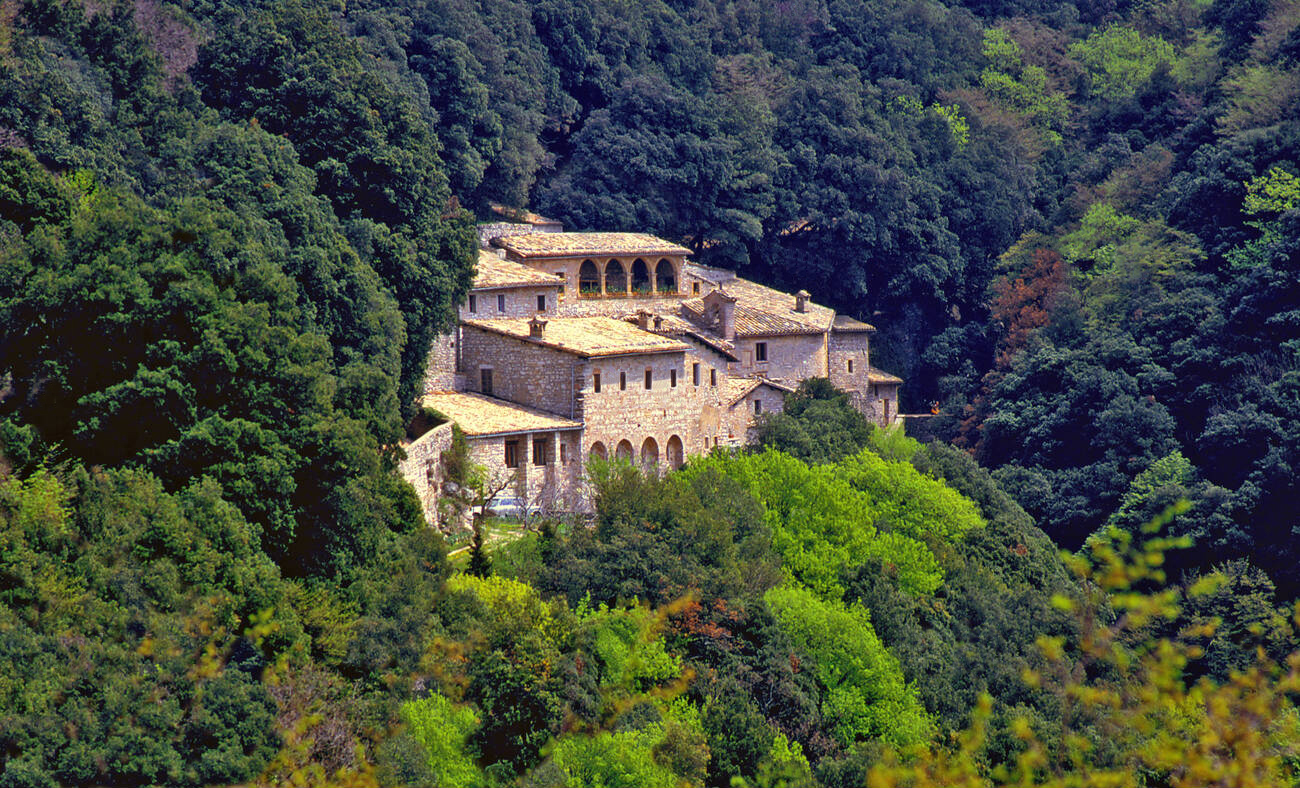
The Carceri Hermitage is located just outside Assisi in the tree-covered hills of Monte Subasio. The word Carceri may be misleading to Italian speakers because today is synonym of prison, but its origin comes from the Latin carcer meaning remote, solitary, and is here where Saint Francis and his followers dedicated themselves to prayer and contemplation. They utilized the natural caves in the rocks, and built a little chapel and lodgings. Through the years, the monastery expanded, the convent and the church of Santa Maria delle Carceri were added, maintaining its simplistic and rustic style characterized by limestone. There is a wide open courtyard with fantastic views over the beautiful, unspoiled countryside.
Spello
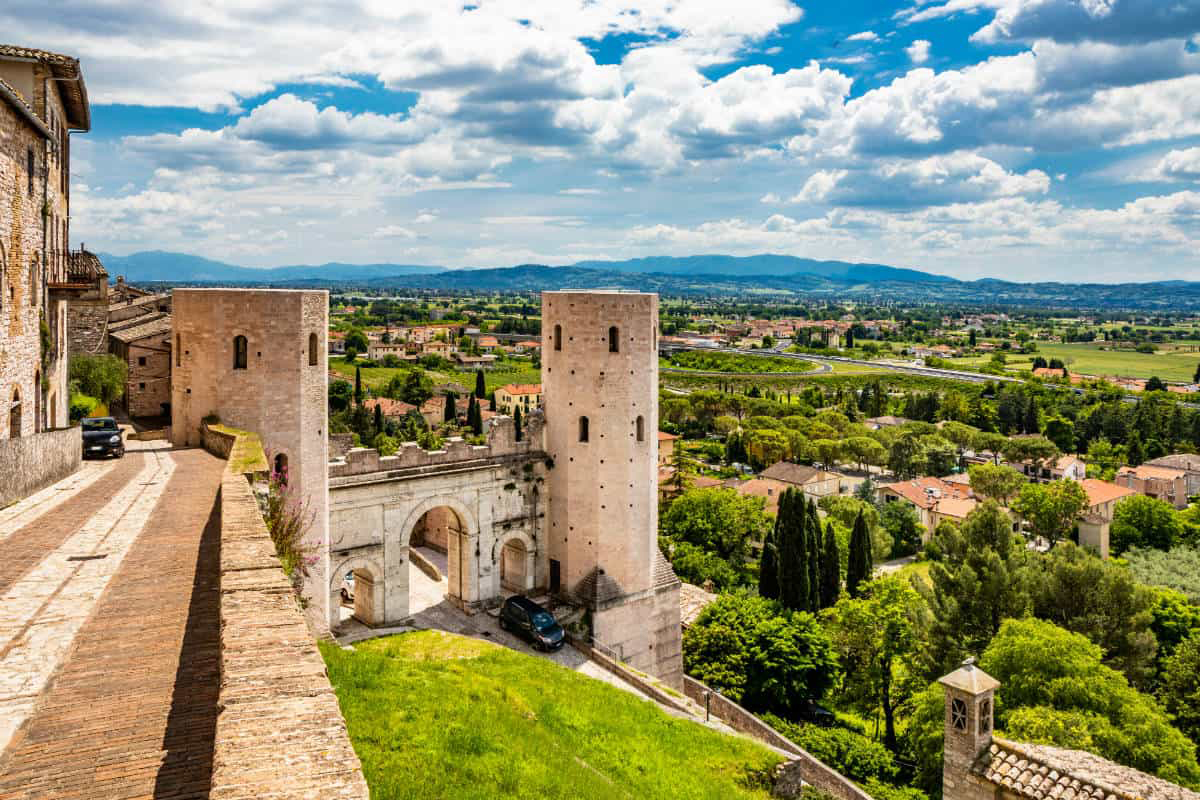
Spello history begins similarly to that of Assisi with the Umbrians forming the first settlements. From the 1st century BC, with the advent of the Romans, Spello, then called Hispellum, became an important city. In fact, the testimonies of that period are evident and impressive and coexist beautifully with today’s medieval urban appearance. There are six Roman gates, of these, Porta Consolare is the most imposing and Porta Venere, with the two Properzio Towers is the most characteristic. There are several churches, all quite plain from the outside but visually stunning on the inside, like the Baglioni Chapel with its magnificent Pinturicchio frescoes. Spello, which is all uphill or all downhill, depending on your point of view, is a jewel with its narrow cobbled streets, quaint little houses built in limestone and stunning views of the Umbrian countryside landscape.
A Day in Siena
Morning
- Drive to Siena, the unique city of superb Medieval and Renaissance art, a giant open-air museum.
- Duomo, one of Italy’s most notable Romanesque and Gothic cathedrals, a complex that consists of six sites: the Cathedral itself, the Piccolomini Library, the Baptistery, the Museo dell’Opera del Duomo (Cathedral’s museum), the Crypt, and the Facciatone viewing terrace.
Afternoon
- Free time or optional activities:
- Torre del Mangia (Tower of the Eater), one of the tallest secular towers in the medieval period. From the top enjoy a 360 degree view of the city and surrounding countryside after climbing its 400 steps.
- Basilica Cateriniana San Domenico, an example of Cistercian Gothic style. The relics of Saint Catherine of Siena, one of the two patron saints of Italy together with Saint Francis, are kept here. Inside, hanging on the walls, there are the flags of the 17 contrade (districts) of Siena displayed in alphabetical order.
- Explore the historic center with its charming street full of shops.
- Museo Civico, a place to admire the wonders of art, is housed on the first floor of the Palazzo Pubblico.
Dinner at one of the oldest restaurants in Siena where recipes from the Sienese culinary tradition have been cooked for three generations.
Siena
Siena is one of the most unique and beautiful cities in Italy, full of Gothic and medieval monuments and Renaissance art that blends into the surrounding landscape. Siena’s main site and heart of the city is its central piazza known as Piazza del Campo, the unique shell shaped square where twice a year the worldwide famous Palio race is held. Siena is said to have been founded by Senius and Aschius, two sons of mythical Remus. When they fled Rome, they took the statue of the She-wolf to Siena, which became its symbol. Throughout the centuries, the city has preserved its Gothic appearance acquired between the 12th and 15th centuries, exemplified by the quintessential Sienese arch, introduced from the East during the Crusades. The arch dominated later building styles including the Renaissance era. During this period, the work of Duccio, the Lorenzetti brothers and Simone Martini influenced Italian and European art. Also of note are the city’s fountains, still fed by an extensive system of original tunnels. Siena is also famous for its wonderful culinary tradition, its wines and pastries, including the famous Panforte and the Ricciarelli, almond paste cakes.
Duomo
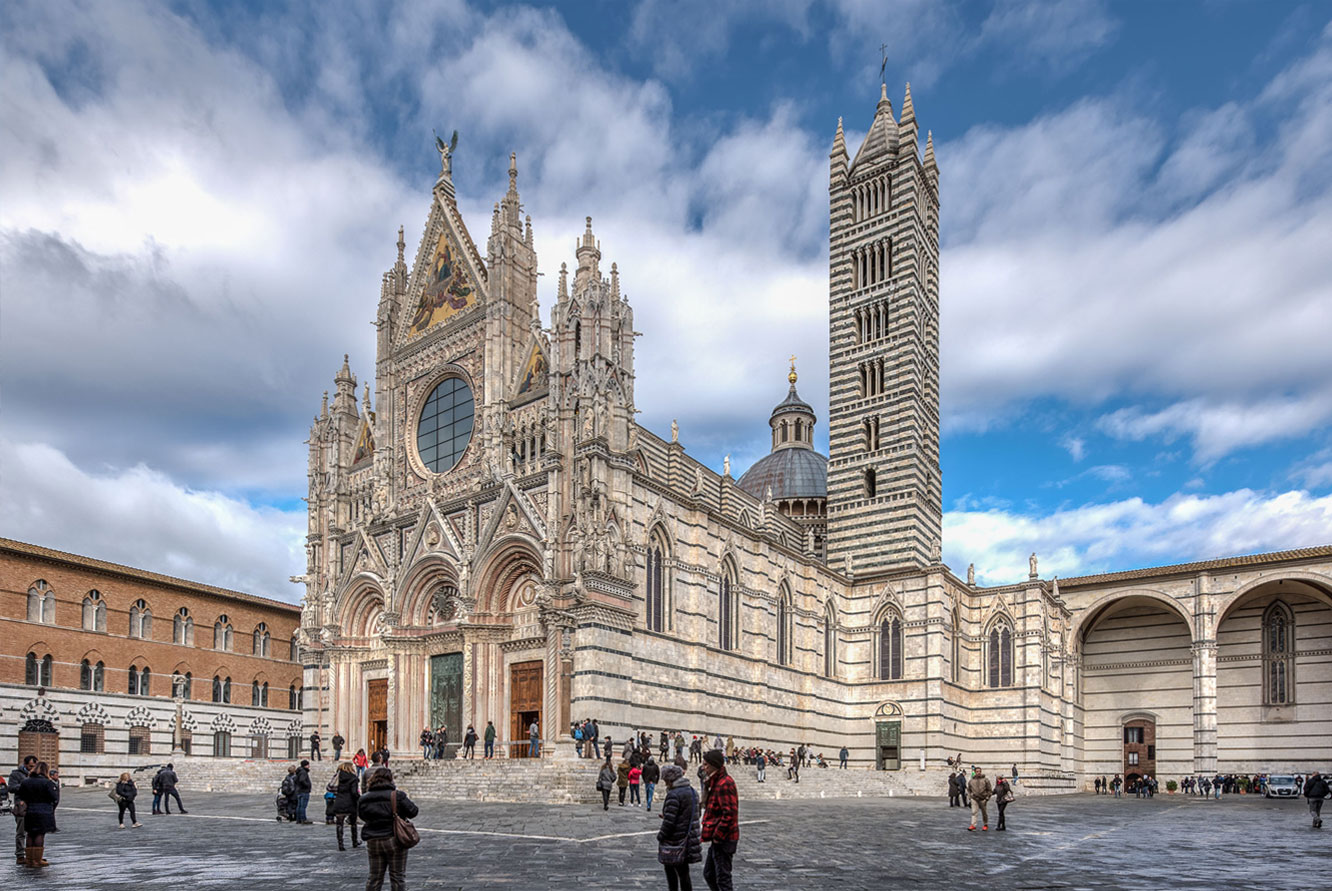
The Duomo, the cathedral dedicated to the Assumption of Mary, was designed and completed between 1215 and 1264. The exterior and interior are constructed of white and black marble in alternating stripes, with the addition of red marble on the façade. The Cathedral is a unique example of perfect synergy between elements of Gothic, Romanesque, and Classical architecture. The façade is one of the most fascinating in all of Italy. All the interior elements; the columns, the arches, the ornate golden dome, the frescoes and the spectacular inlaid marble mosaic flooring, full of esoteric symbols and religious stories, are a feast for the eyes. Many valuable pieces of art include The Feast of Herod by Donatello, and works by Bernini and the young Michelangelo.
Battistero
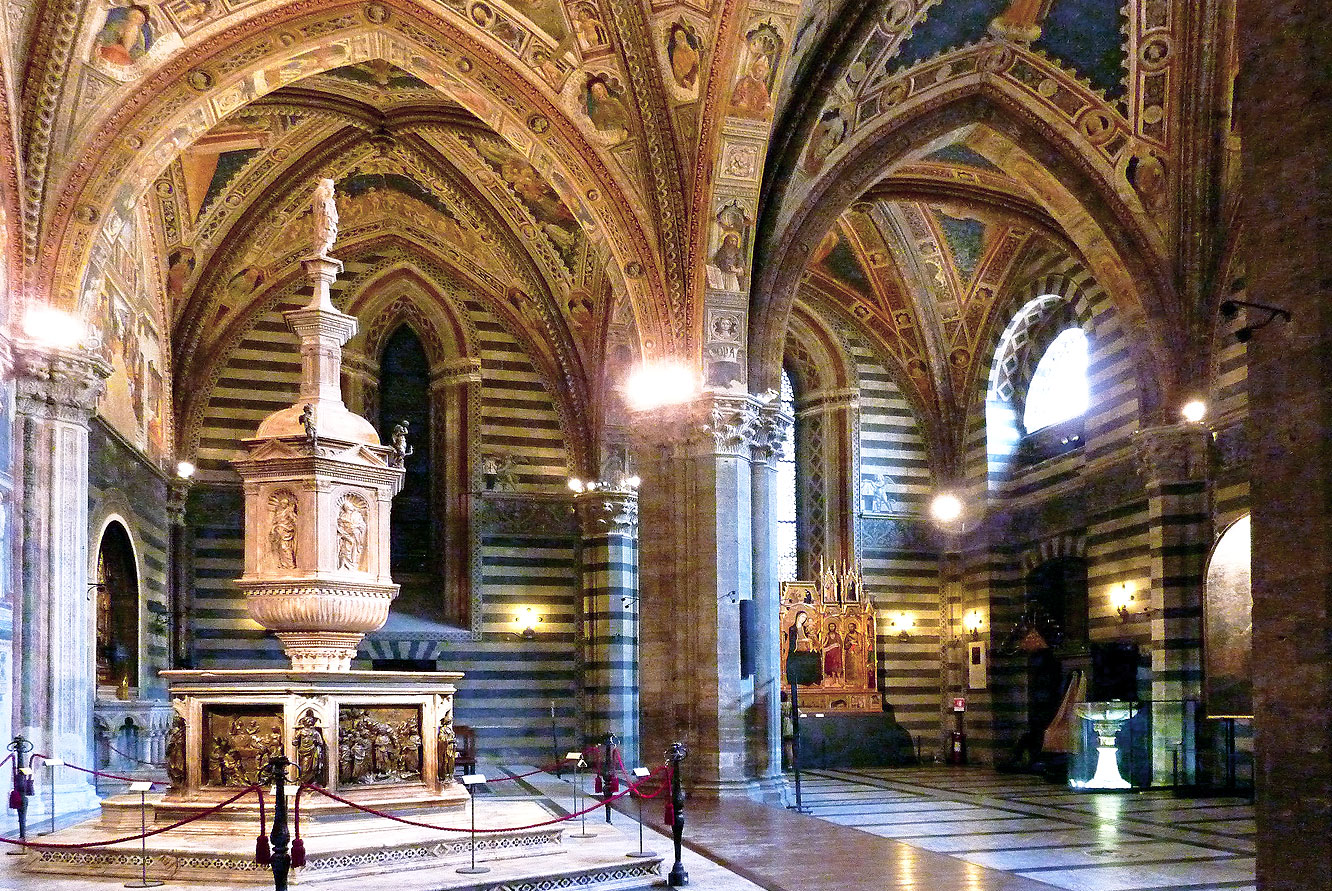
The Baptistry of San Giovanni Battista was built between 1310 and 1320. Its most important elements are the marble façade, in pure Sienese Gothic style and the hexagonal baptismal font, a fundamental example of Renaissance sculpture of the early 15th century. Made of marble, bronze and enamel, between 1417 and 1431, with contributions by the greatest sculptors of the time: Donatello, Lorenzo Ghiberti and Jacopo della Quercia. The frescoes, which completely decorate the vaults, represent a large and articulated religious cycle, among the best of the Sienese 15th century.
Libreria Piccolomini
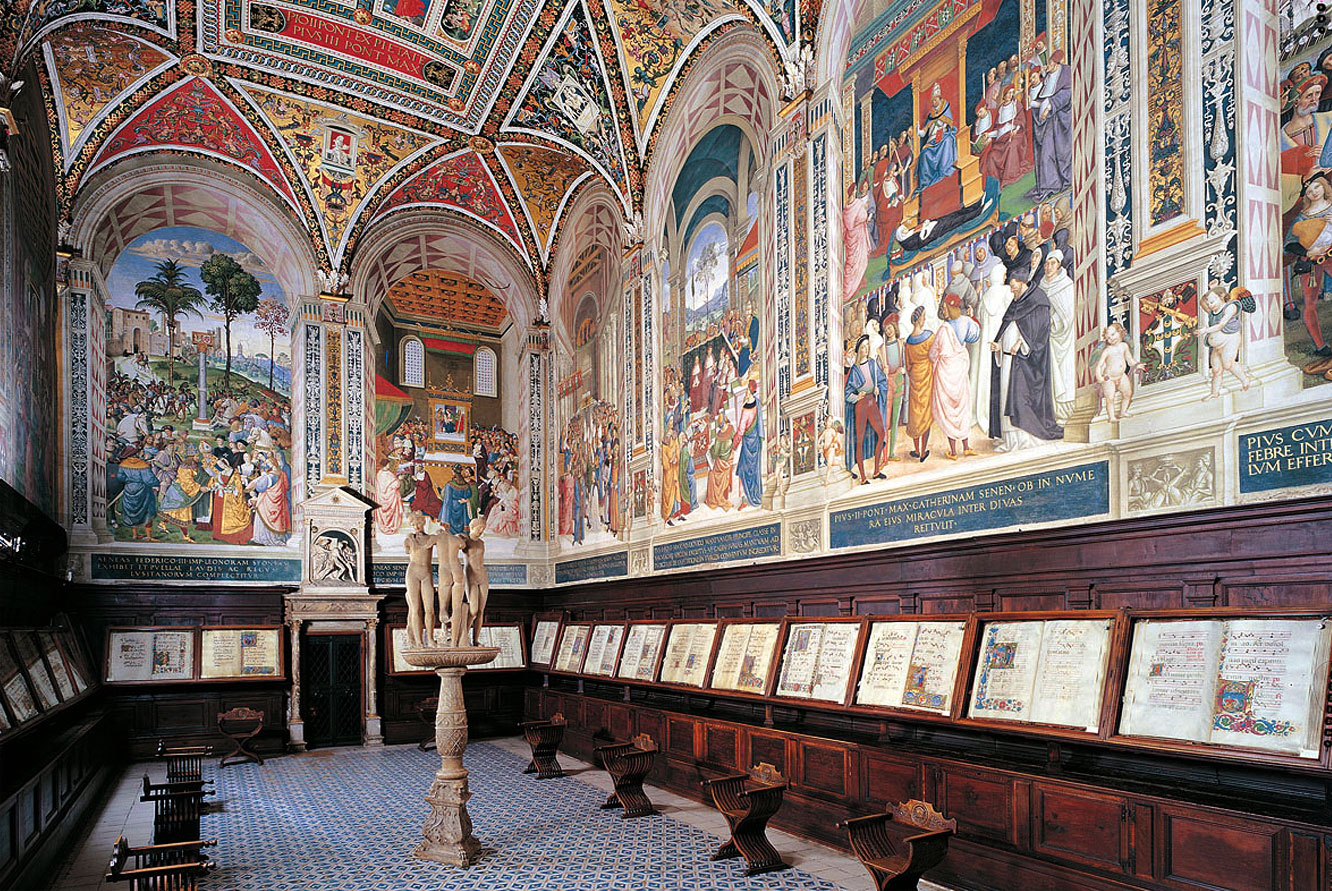
The construction of the Piccolomini Library, housed inside the Cathedral, was commissioned in 1492 by the archbishop of Siena Francesco Todeschini Piccolomini, subsequently Pope Pius III, in order to preserve the rich collection of books and manuscripts that his uncle, the humanist Pope Pius II had put together while in Rome. The frescoes adorning it were painted by Pinturicchio between 1503 and 1508. They illustrate episodes from the life and work of Pius II, with figures painted in different landscapes in real and imaginary costumes in a rich palette. Also notable are the marble sculpture of the Three Graces (a Roman-era copy of a Hellenistic original) in the center of the room, and the collection of illuminated manuscript codices that exemplify the history of Italian illumination in the 15th century.
Torre del Mangia
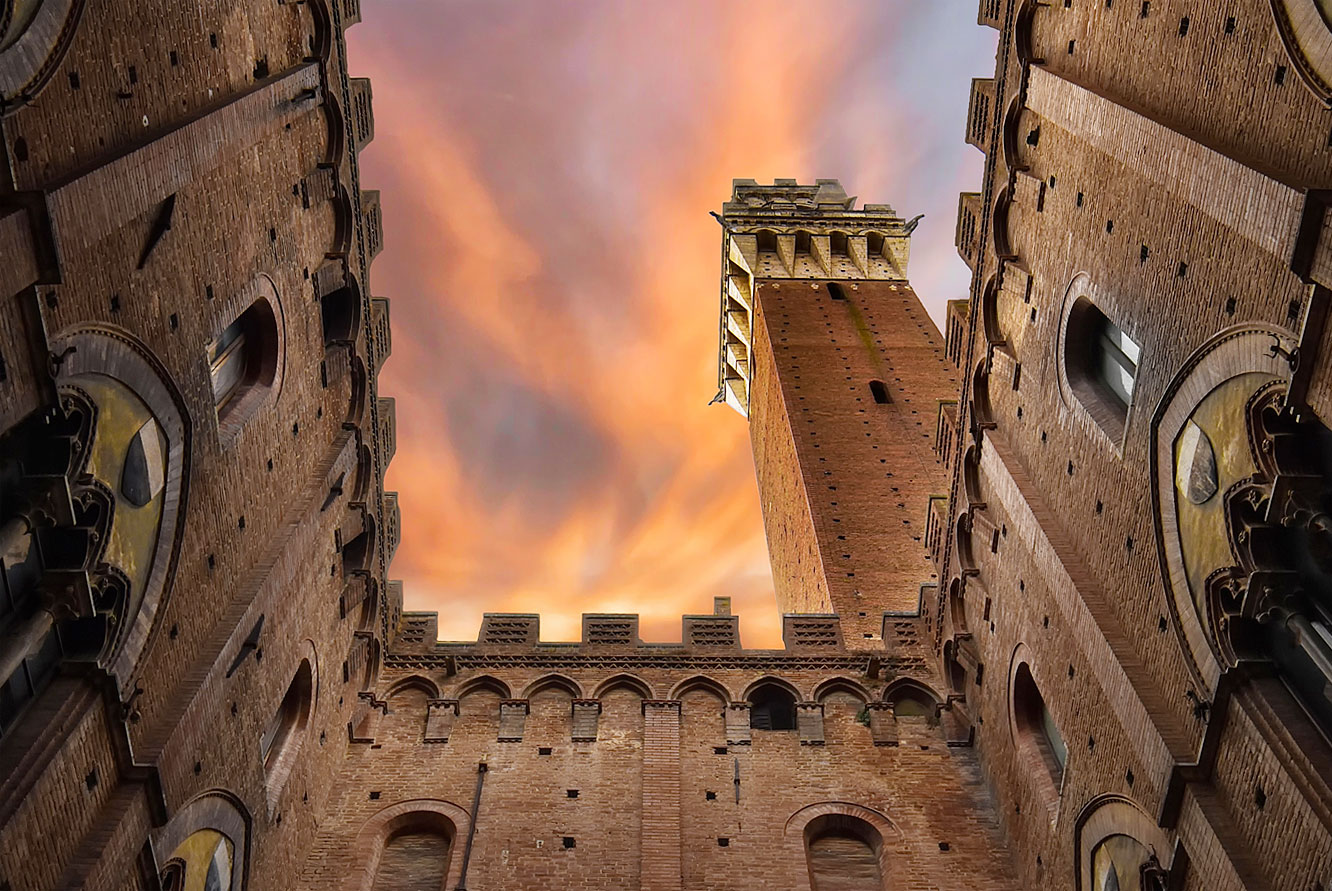
The Torre del Mangia, (Tower of the Eater) named after Giovanni di Balduccio nicknamed “Mangia” or “Mangiaguadagni” (profit-eater) because he was spending his earnings eating in the local taverns. The tower, located in Piazza del Campo, was built so high to match that of the Cathedral to symbolize that the Curia and the State in Siena had equal powers. It is 88 m (288 ft) high and from its top the view is truly breathtaking.
Arezzo, The Tuscan Cinderella
Morning
- Drive to La Verna, the Franciscan Sanctuary, a place where unspoiled nature is wedded with faith.
- Santa Maria degli Angeli, a small church built by Francis himself.
- Chapel of the Holy Stigmata, built in 1263 to mark the spot where Saint Francis received the stigmata.
- Basilica di Santa Maria Assunta, with the Annunciation, one of Andrea della Robbia's sculptural masterworks.
- La Verna Museum, with three large 15th century halls and the fuoco comune (common fire) room, where the brothers would spend cold winter evenings together.
Afternoon
- Drive to Arezzo, one of the most splendid cities in Tuscany, seldom included in tourist itineraries.
- Free time or optional activities:
- Piazza Grande, the heart of the city, famous for its odd shape due to the fact that it was built on a downhill slope.
- Palazzo della Fraternita dei Laici is one of several historic palazzos and buildings in Piazza Grande.
- Museo di Casa Vasari, home and museum of one of the most important architects and painters born in Arezzo.
- Basilica di San Francesco, a small stone and brick church famous because it houses La leggenda della Vera Croce (The Legend of the True Cross) painting by Piero Della Francesca, rightly considered one of the absolute masterpieces of Italian art.
- Duomo dei Santi Pietro e Donato with frescoes by Piero Della Francesca.
- Back to Cortona.
Santuario La Verna
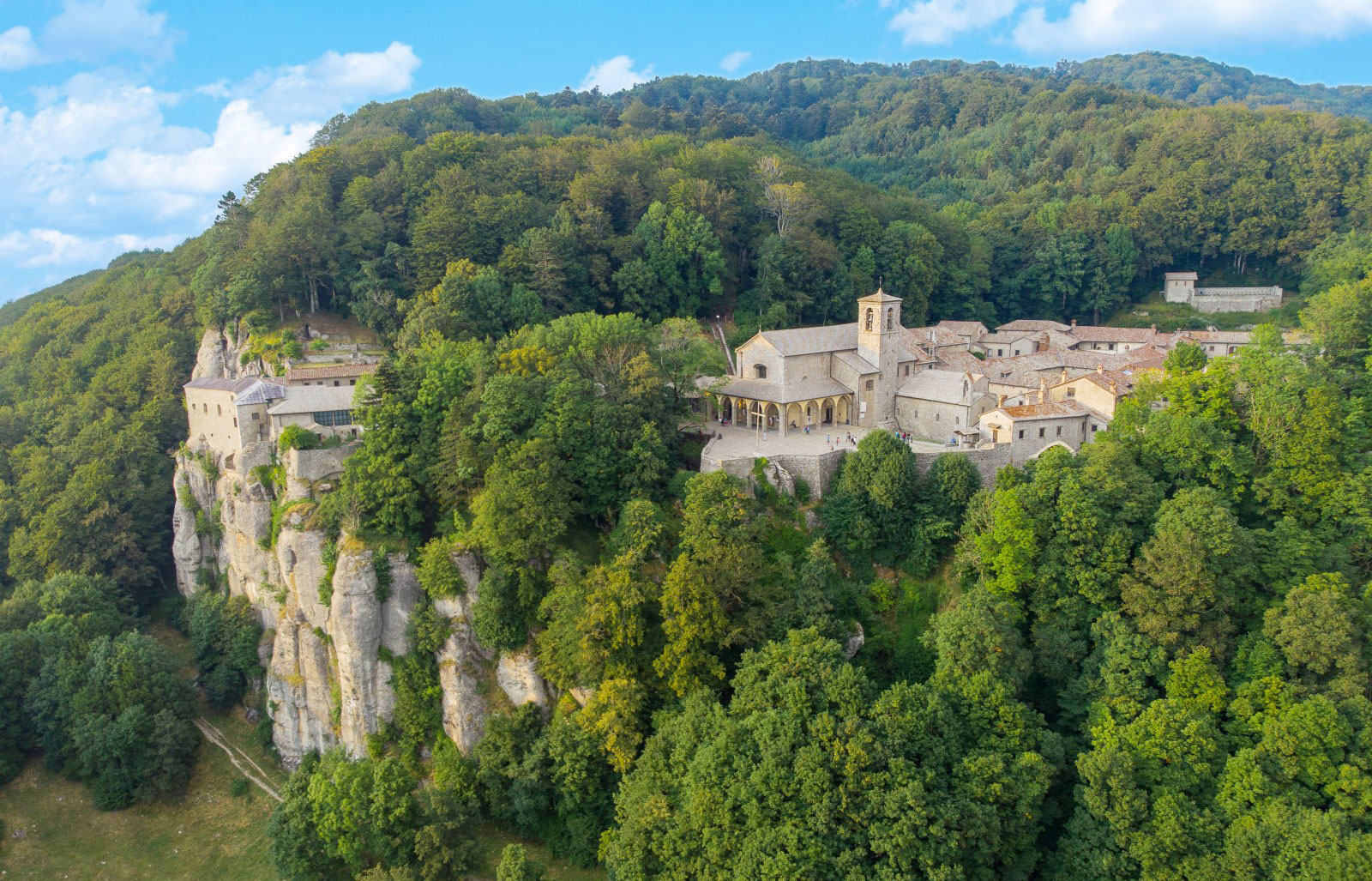
“I have in Tuscany a diverse little mountain, which is called the mountain of Alvernia, which is a very lonely and savage act and it’s good for those who want to do penance in a place removed from the people, or those who want a lonely life. If you like, I will gladly give it to you and your comrades for my soul.” With these words, in 1213, Count Orlando of Chiusi della Verna, donated to Saint Francis Mount Penna, also called Monte della Verna, where the monastery was later built. The sacred place became the favorite site for Francis and his followers to spend long periods of meditation and prayer. In 1224, during his last stay at La Verna when he was already tired and ill, he had a vision and received the stigmata that he carried until his death two years later.
Arezzo
Arezzo is the Cinderella of Tuscany, unjustly overshadowed by the fame of Florence, Siena and Pisa. The beautiful historic center conveys the wealth it has gathered over the past centuries. Lying on a steep hill, which rises from the floodplain of the Arno, the river that crosses Florence and Pisa, Arezzo (Aritim in Etruscan), which was born around the 9th century BC, was one of the twelve most important Etruscan cities. Conquered by the Romans in 311 BC, due to its strategic position, it became a military station on the Via Cassia, the road through which Rome expanded in the North. After the Gothic war and the invasion of the Lombards at the end of the 6th century, only the amphitheater survived from the Roman period. Arezzo was home to important and great artists such as Petrarch, the pioneer poet of Renaissance literature and humanist thought; the painter Piero della Francesca whose masterpiece painting can be seen in the Church of San Francesco; Vasari, architect and painter and the painters Masaccio, Michelangelo and Luca Signorelli. Arezzo has a lot to offer; palaces, small alleys and quiet streets, archaeological sites, churches, monuments, museums and beautiful squares such as Piazza Grande where some scenes of the film Life is beautiful by Roberto Benigni were filmed. Arezzo hosts two major events, the medieval festival The Giostra del Saracino, held twice during summer, and the largest Antiques Fair in Italy, held on the first weekend of each month.
Palazzo della Fraternita dei Laici
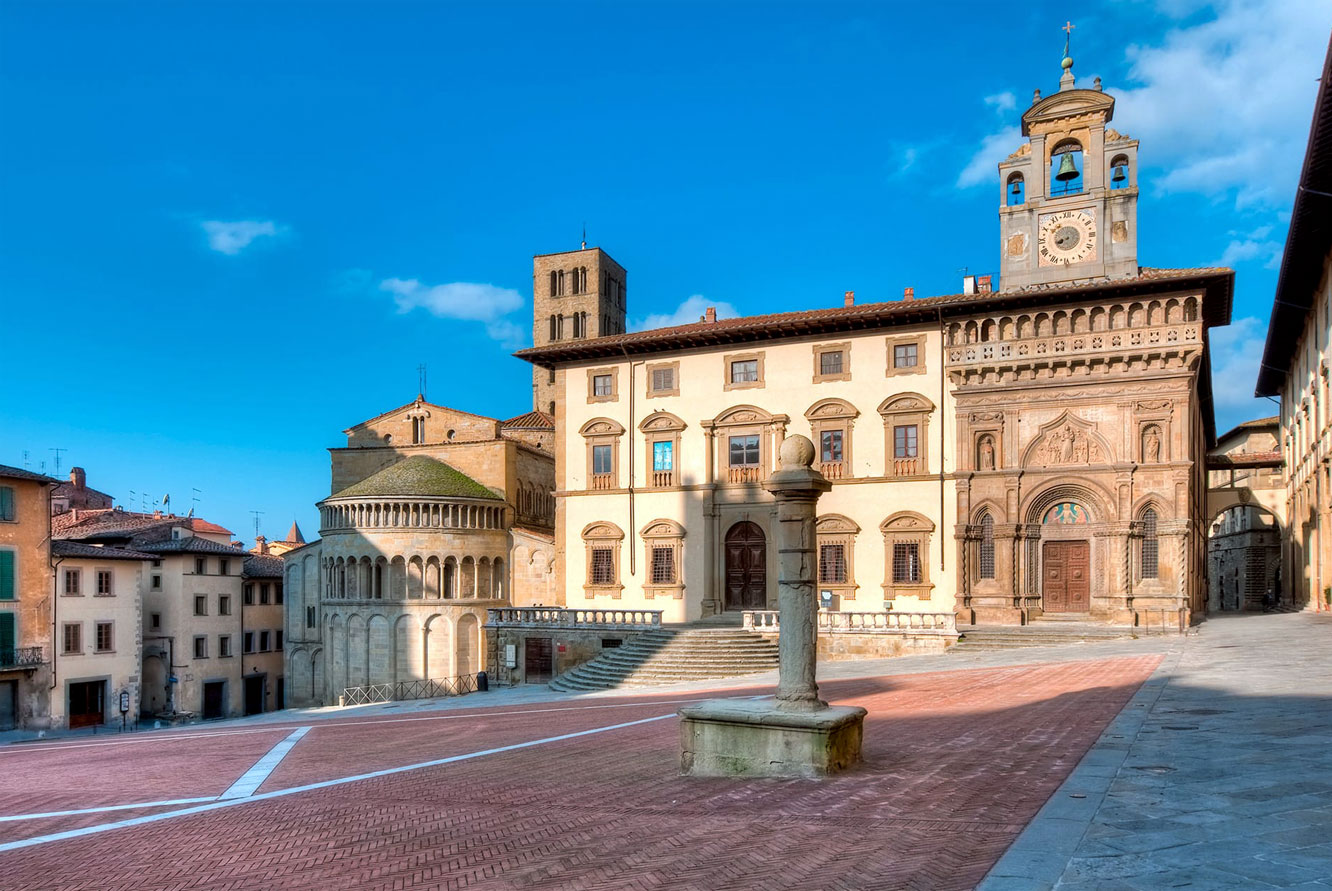
The Palace of the Lay Fraternity dates back to three different eras, the lower part is from the 14th century in Gothic style, then the second floor was completed during the Renaissance period. Finally, in 1552, a small bell tower and a clock were added. The clock, one of the oldest in Italy and one of the rarest in Europe, was built based on the ideas of the ancient Greek astronomer, Ptolemy, when it was still believed that the earth was the center around which the sun and the moon rotated. Still operating now, indicates the time, the day and the phases of the moon. The palace became in 2010 the Museum of Palazzo della Fraternita and houses the organization of Fraternita dei Laici, an institution founded in 1262, still active today and very involved in projects of social and cultural interest.
Museo di Casa Vasari
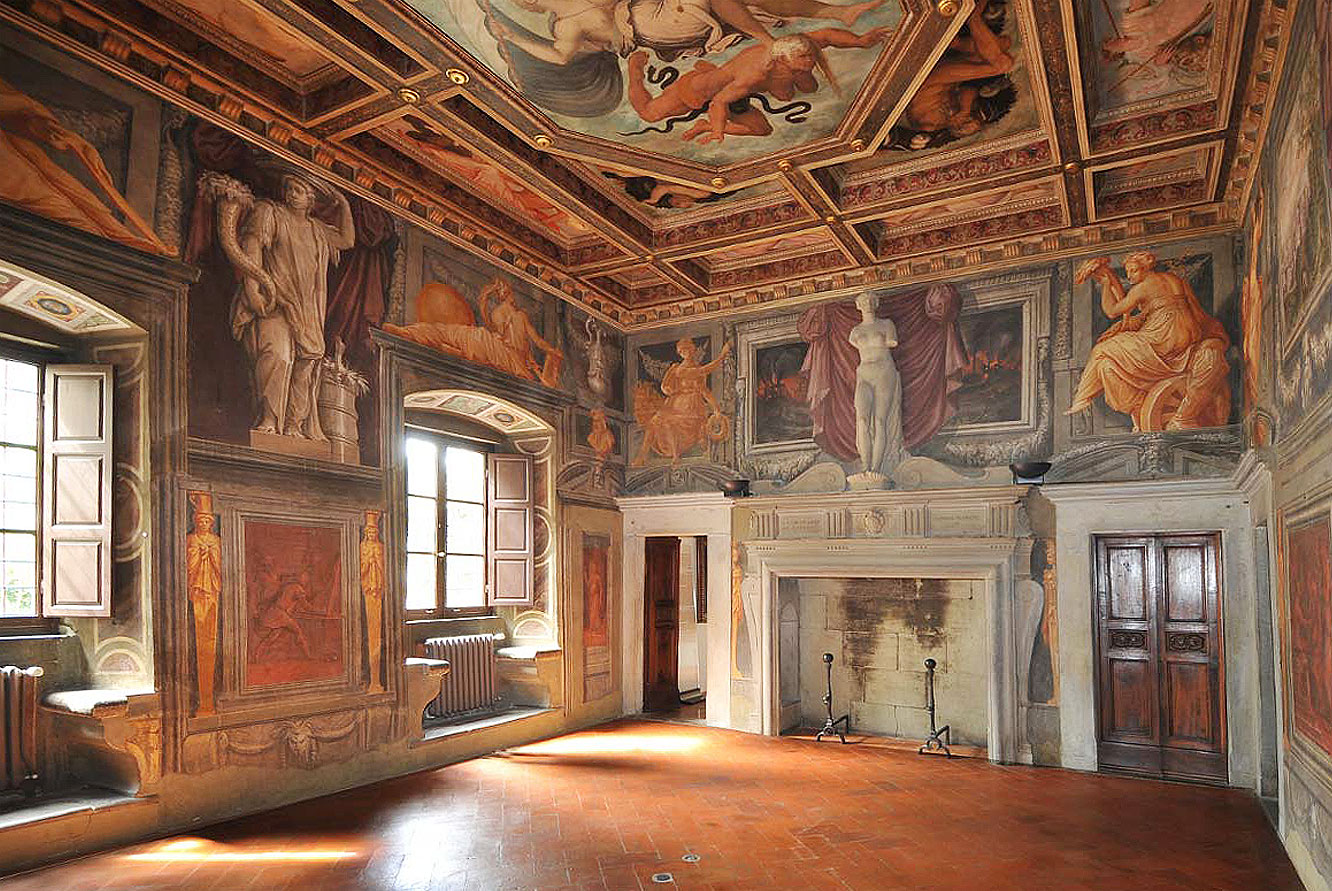
The Vasari Home Museum is an example of an artist’s family home, where the Mannerist artist Giorgio Vasari expressed his thinking and art. The interiors are a testimony of the highest expression of the artistic civilization of the 16th century in Italy, richly decorated with frescoes and a valuable collection of paintings. Vasari bought the two-story palace in 1541 and after completing the architectural work, he began the decoration with frescoes and paintings with scenes from the Bible, mythology and numerous allegories which he conceived and created with the help of his students, and finished it after 1568. Although several centuries have passed since Vasari’s time, the main interiors of the building have remained largely unchanged to this day.
Piero della Francesca
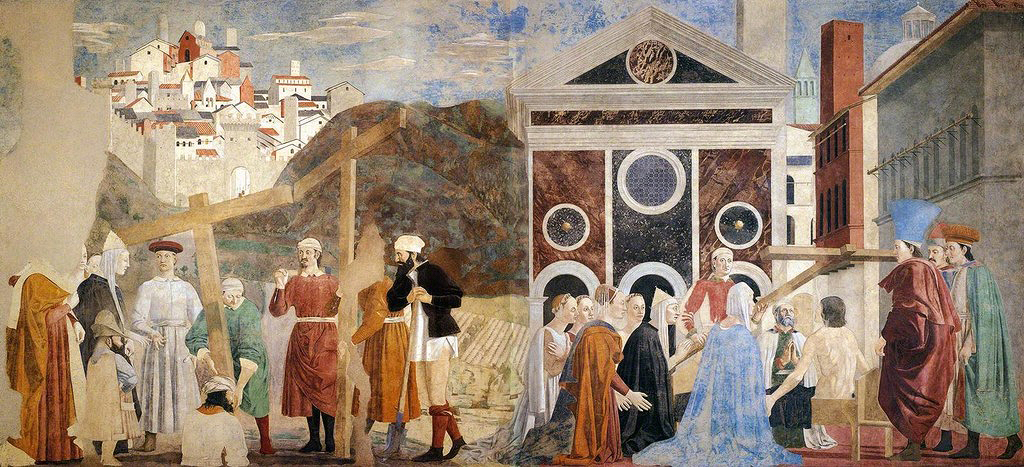
The Legend of the True Cross or the History of the True Cross is a sequence of frescoes painted by Piero della Francesca in the Cappella Maggiore of the late Medieval Basilica of San Francesco. The simplicity and clarity of the scenes, the use of perspective and the aura of serenity are typical of Piero’s art. It is his greatest work and considered his most beautiful. The fresco, an early Renaissance masterpiece, was executed on three levels, and tells the story of the cross on which Jesus was crucified. The dominant theme of the cycle is the triumph of the cross that, since the death of Adam, leads man to salvation
Arrivederci! See you soon!
The tour ends today with a ride to the Florence airport, or to your hotel in Florence if you are prolonging your visit in Italy. Today will be your last chance to exchange email addresses with your new friends!
Tornate Presto!
Remember that, following your first tour with us, you will receive a $200 credit for future trips with Tour With Us!
Home | Tours | Policies | Photos | About Us | Contact Us
CST # 2129817-40
Copyright ©2017 Tour With Us. All rights reserved.
Web Site Design: Landini Design, Inc.
